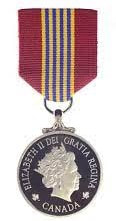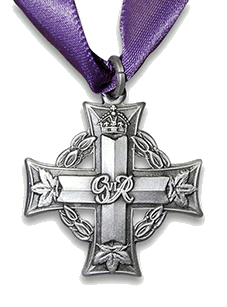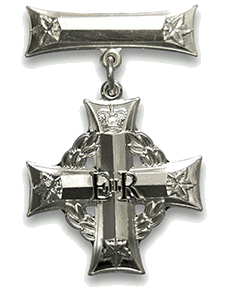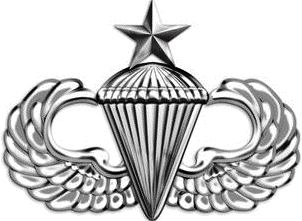Honours and Awards

Member of the Order of Canada (CM)
Established in 1967 by Her Majesty Queen Elizabeth II, the Order of Canada is the cornerstone of the Canadian Honours System, and recognizes outstanding achievement, dedication to the community and service to the nation. The Order recognizes people in all sectors of Canadian society. Their contributions are varied, yet they have all enriched the lives of others and made a difference to this country.
The insignia of the Order is a stylized snowflake of six points, with a red annulus at its centre which bears a stylized maple leaf circumscribed with the motto of the Order, DESIDERANTES MELIOREM PATRIAM (They desire a better country), surmounted by the Royal Crown. It is struck in fine silver and is composed of three individual pieces: the snowflake, annulus and maple leaf. The colour is added by hand through a unique application of opaque and translucent viscous enamel.
Lieutenant The Honourable Charles Joseph Holland Locke CC MC QC was appointed a companion in 1971.
Captain Edward John Hughes CM OBC was appointed a member of the Order of Canada in 2001.
Established in 1967 by Her Majesty Queen Elizabeth II, the Order of Canada is the cornerstone of the Canadian Honours System, and recognizes outstanding achievement, dedication to the community and service to the nation. The Order recognizes people in all sectors of Canadian society. Their contributions are varied, yet they have all enriched the lives of others and made a difference to this country.
The insignia of the Order is a stylized snowflake of six points, with a red annulus at its centre which bears a stylized maple leaf circumscribed with the motto of the Order, DESIDERANTES MELIOREM PATRIAM (They desire a better country), surmounted by the Royal Crown. It is struck in fine silver and is composed of three individual pieces: the snowflake, annulus and maple leaf. The colour is added by hand through a unique application of opaque and translucent viscous enamel.
Lieutenant The Honourable Charles Joseph Holland Locke CC MC QC was appointed a companion in 1971.
Captain Edward John Hughes CM OBC was appointed a member of the Order of Canada in 2001.

Commander of The Order of Military Merit (CMM)
Founded on July 1, 1972, the Order of Military Merit recognizes distinctive merit and exceptional service displayed by the men and women of the Canadian Forces, both Regular and Reserve. Many have demonstrated dedication and devotion beyond the call of duty, and the Order honours them for their commitment to Canada. Her Majesty Queen Elizabeth II is the Order’s Sovereign, Their Excellency, the Governor General is its Chancellor and a Commander of the Order, the Chief of the Defence Staff is its Principal Commander. The Commander of The Order of Military Merit recognizes outstanding meritorious service and demonstrated leadership in duties of great responsibility.
The badge of the Order is a blue-enamelled, straight-end cross (four arms, narrow at the centre, wider at the ends) with an annulus in red surmounted by St. Edward’s Crown. The annulus bears the inscription MERIT.MÉRITE.CANADA.
Major General Stuart T McDonald CMM CD appointed 26 October 1999
Commanding Officer 1978-1981
Founded on July 1, 1972, the Order of Military Merit recognizes distinctive merit and exceptional service displayed by the men and women of the Canadian Forces, both Regular and Reserve. Many have demonstrated dedication and devotion beyond the call of duty, and the Order honours them for their commitment to Canada. Her Majesty Queen Elizabeth II is the Order’s Sovereign, Their Excellency, the Governor General is its Chancellor and a Commander of the Order, the Chief of the Defence Staff is its Principal Commander. The Commander of The Order of Military Merit recognizes outstanding meritorious service and demonstrated leadership in duties of great responsibility.
The badge of the Order is a blue-enamelled, straight-end cross (four arms, narrow at the centre, wider at the ends) with an annulus in red surmounted by St. Edward’s Crown. The annulus bears the inscription MERIT.MÉRITE.CANADA.
Major General Stuart T McDonald CMM CD appointed 26 October 1999
Commanding Officer 1978-1981
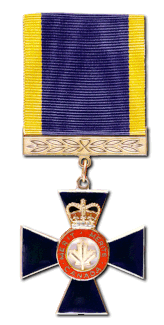
Officer of The Order of Military Merit (OMM)
The Officer of The Order of Military Merit recognizes outstanding meritorious service in duties of responsibility
The badge of the Order is a blue-enamelled, straight-end cross (four arms, narrow at the centre, wider at the ends) with an annulus in red surmounted by St. Edward’s Crown. The annulus bears the inscription MERIT.MÉRITE.CANADA.
Lieutenant Colonel Leon Jensen OMM CD September 2004 Commanding Officer 1998
Lieutenant Colonel Robert W Elliott September 2004 Lieutenant 1965
Captain (N) Harold Theodore Harsch OMM CD October 2007 Gunner 1974/1975
The Officer of The Order of Military Merit recognizes outstanding meritorious service in duties of responsibility
The badge of the Order is a blue-enamelled, straight-end cross (four arms, narrow at the centre, wider at the ends) with an annulus in red surmounted by St. Edward’s Crown. The annulus bears the inscription MERIT.MÉRITE.CANADA.
Lieutenant Colonel Leon Jensen OMM CD September 2004 Commanding Officer 1998
Lieutenant Colonel Robert W Elliott September 2004 Lieutenant 1965
Captain (N) Harold Theodore Harsch OMM CD October 2007 Gunner 1974/1975
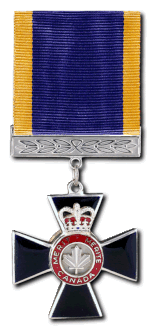
Member of The Order of Military Merit (MMM)
The Member of The Order of Military Merit recognizes exceptional service or performance of duty.
The badge of the Order is a blue-enamelled, straight-end cross (four arms, narrow at the centre, wider at the ends) with an annulus in red surmounted by St. Edward’s Crown. The annulus bears the inscription MERIT.MÉRITE.CANADA.
Captain Richard J Van Slyke MMM CD appointed 26 October 1999
Captain Douglas P Gayton MMM CD appointed 28 November 2008
Captain Brian J. Logheed MMM CD appointed 4 October 2018
Warrant Officer Nathaniel CA Senff MMM CD appointed 11 December 2020
Warrant Officer J Palmer MMM CD
The Member of The Order of Military Merit recognizes exceptional service or performance of duty.
The badge of the Order is a blue-enamelled, straight-end cross (four arms, narrow at the centre, wider at the ends) with an annulus in red surmounted by St. Edward’s Crown. The annulus bears the inscription MERIT.MÉRITE.CANADA.
Captain Richard J Van Slyke MMM CD appointed 26 October 1999
Captain Douglas P Gayton MMM CD appointed 28 November 2008
Captain Brian J. Logheed MMM CD appointed 4 October 2018
Warrant Officer Nathaniel CA Senff MMM CD appointed 11 December 2020
Warrant Officer J Palmer MMM CD
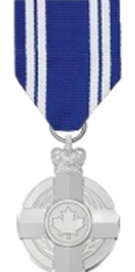
Meritorious Service Medal (MSM)
The Meritorious Service Decorations recognize great Canadians for exceptional deeds accomplished over a limited period of time that bring honour to our country. They honour achievements in both military and civil divisions. The Meritorious Service Decorations (Civil Division) were established to recognize remarkable contributions in many different fields of endeavour, from advocacy initiatives and health care services, to research and humanitarian efforts. Past recipients have tackled poverty in their community, improved education opportunities for children in Canada and abroad, or raised awareness of important causes and issues.
Honorary Colonel Allan Frank De Genova MSM Awarded 3 May 2022
The Meritorious Service Decorations recognize great Canadians for exceptional deeds accomplished over a limited period of time that bring honour to our country. They honour achievements in both military and civil divisions. The Meritorious Service Decorations (Civil Division) were established to recognize remarkable contributions in many different fields of endeavour, from advocacy initiatives and health care services, to research and humanitarian efforts. Past recipients have tackled poverty in their community, improved education opportunities for children in Canada and abroad, or raised awareness of important causes and issues.
Honorary Colonel Allan Frank De Genova MSM Awarded 3 May 2022
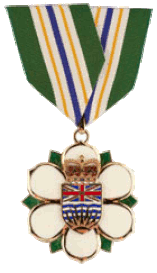
The Order of British Columbia (OBC)
The Order was established by statute on April 21, 1989, to recognize those persons who have served with the greatest distinction and excelled in any field of endeavour benefiting the people of the Province of British Columbia or elsewhere. The Order represents the highest form of recognition the Province can extend to its citizens. The Order will be bestowed on the most outstanding British Columbians possessing the above qualifications annually.
Captain Edward John Hughes CM OBC was awarded the Order of British Columbia in 2005.
The Order was established by statute on April 21, 1989, to recognize those persons who have served with the greatest distinction and excelled in any field of endeavour benefiting the people of the Province of British Columbia or elsewhere. The Order represents the highest form of recognition the Province can extend to its citizens. The Order will be bestowed on the most outstanding British Columbians possessing the above qualifications annually.
Captain Edward John Hughes CM OBC was awarded the Order of British Columbia in 2005.

Commander of the Order of the British Empire (CBE)
For the Commander of the Order of the British Empire there is no star and the neck badge is smaller than that of the Knight Commander of the Order of the British Empire. For mounting a ring is attached to the top of the crown through which a larger ring passes.
Obverse of the medal:
Original Badge: A cross patonce (four arms with three points on each arm) of silver-gilt with the arms enameled pearl-grey, surmounted by an Imperial Crown. The circular centre, in gold, shows the figure of Britannia, holding a trident and seated beside a shield bearing the national flag. The centre is surrounded by a circular band, enameled crimson and bearing the motto FOR GOD AND THE EMPIRE in gold.
Current Badge (after 1937): As above except that in the centre, in gold, are the crowned effigies of King George V and his consort Queen Mary. Neither the original nor the current Officer of the Order of the British Empire and Member of the Order of the British Empire badges are enameled.
On the reverse of the medal is a rope circle with the current Royal Cypher, surmounted by an Imperial Crown and with a hallmark on the lower limb.
Original ribbon: The civil ribbon was purple. The military ribbon had a narrow central stripe of scarlet added.
Current ribbon (after 1937): The civil ribbon is rose-pink with pearl-grey edges. The military ribbon has a narrow central stripe of pearl-grey added.
Lieutenant-Colonel Douglas Hitch Storms CBE MC Awarded 5 June 1943 Battery Commander 85 Battery
For the Commander of the Order of the British Empire there is no star and the neck badge is smaller than that of the Knight Commander of the Order of the British Empire. For mounting a ring is attached to the top of the crown through which a larger ring passes.
Obverse of the medal:
Original Badge: A cross patonce (four arms with three points on each arm) of silver-gilt with the arms enameled pearl-grey, surmounted by an Imperial Crown. The circular centre, in gold, shows the figure of Britannia, holding a trident and seated beside a shield bearing the national flag. The centre is surrounded by a circular band, enameled crimson and bearing the motto FOR GOD AND THE EMPIRE in gold.
Current Badge (after 1937): As above except that in the centre, in gold, are the crowned effigies of King George V and his consort Queen Mary. Neither the original nor the current Officer of the Order of the British Empire and Member of the Order of the British Empire badges are enameled.
On the reverse of the medal is a rope circle with the current Royal Cypher, surmounted by an Imperial Crown and with a hallmark on the lower limb.
Original ribbon: The civil ribbon was purple. The military ribbon had a narrow central stripe of scarlet added.
Current ribbon (after 1937): The civil ribbon is rose-pink with pearl-grey edges. The military ribbon has a narrow central stripe of pearl-grey added.
Lieutenant-Colonel Douglas Hitch Storms CBE MC Awarded 5 June 1943 Battery Commander 85 Battery
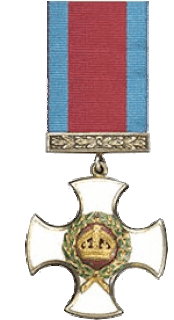
Distinguished Service Order (DSO)
The order was established for rewarding individual instances of meritorious or distinguished service in war. This is a military order for officers only, and while normally given for service under fire or under conditions equivalent to service in actual combat with the enemy, it was awarded between 1914 and 1916 under circumstances which could not be regarded as under fire. After 01 January 1917, commanders in the field were instructed to recommend this award only for those serving under fire. Prior to 1943, the order could be given only to someone Mentioned-in-Dispatches. The order is generally given to officers in command, above the rank of Lieutenant-Colonel and awards to ranks below this are usually for a high degree of gallantry just short of deserving the Victoria Cross.
A bar is awarded for an act which would have earned the order in the first place. The bar is plain gold with an Imperial Crown in the centre. The year of the award is engraved on the reverse.
A gold cross, enamelled gold and edged in gold. In the centre, within a wreath of laurel, enamelled green, the Imperial Crown in gold upon a red enamelled ground. On the reverse, within a wreath of laurel, enamelled green, the Royal Cypher in gold upon a red enamelled ground. A ring at the top of the medal attaches to a ring at the bottom of a gold bar, ornamented with laurel. At the top of the ribbon is a second gold bar ornamented with laurel. The red ribbon is 1.125 inches wide with narrow blue edges. A rosette is worn on the ribbon in undress to signify the award of a bar.
Officially unnamed, some recipients have privately had their names engraved on the back of the suspension bar.
There have been 1,220 Distinguished Service Orders, 119 first bars and 20 second bars awarded to Canadians.
http://www.veterans.gc.ca/eng/remembrance/medals-decorations/orders-decorations
Lieutenant-Colonel Frederick Thomas Coghlan DSO
Lieutenant-Colonel Alexander Thomas Ogilvie
Major DN Hossie DSO
Major William Wasbrough Foster DSO
Major Walter Court Hyde DSO
Bar to Distinguished Service Order (DSO)
Lieutenant-Colonel William Wasbrough Foster DSO 18 January 1918 Honorary Colonel 1932-1938
Second Bar to Distinguished Service Order (DSO)
Lieutenant-Colonel William Wasbrough Foster DSO 2 December 1918 Honorary Colonel 1932-1938
For citations
The order was established for rewarding individual instances of meritorious or distinguished service in war. This is a military order for officers only, and while normally given for service under fire or under conditions equivalent to service in actual combat with the enemy, it was awarded between 1914 and 1916 under circumstances which could not be regarded as under fire. After 01 January 1917, commanders in the field were instructed to recommend this award only for those serving under fire. Prior to 1943, the order could be given only to someone Mentioned-in-Dispatches. The order is generally given to officers in command, above the rank of Lieutenant-Colonel and awards to ranks below this are usually for a high degree of gallantry just short of deserving the Victoria Cross.
A bar is awarded for an act which would have earned the order in the first place. The bar is plain gold with an Imperial Crown in the centre. The year of the award is engraved on the reverse.
A gold cross, enamelled gold and edged in gold. In the centre, within a wreath of laurel, enamelled green, the Imperial Crown in gold upon a red enamelled ground. On the reverse, within a wreath of laurel, enamelled green, the Royal Cypher in gold upon a red enamelled ground. A ring at the top of the medal attaches to a ring at the bottom of a gold bar, ornamented with laurel. At the top of the ribbon is a second gold bar ornamented with laurel. The red ribbon is 1.125 inches wide with narrow blue edges. A rosette is worn on the ribbon in undress to signify the award of a bar.
Officially unnamed, some recipients have privately had their names engraved on the back of the suspension bar.
There have been 1,220 Distinguished Service Orders, 119 first bars and 20 second bars awarded to Canadians.
http://www.veterans.gc.ca/eng/remembrance/medals-decorations/orders-decorations
Lieutenant-Colonel Frederick Thomas Coghlan DSO
Lieutenant-Colonel Alexander Thomas Ogilvie
Major DN Hossie DSO
Major William Wasbrough Foster DSO
Major Walter Court Hyde DSO
Bar to Distinguished Service Order (DSO)
Lieutenant-Colonel William Wasbrough Foster DSO 18 January 1918 Honorary Colonel 1932-1938
Second Bar to Distinguished Service Order (DSO)
Lieutenant-Colonel William Wasbrough Foster DSO 2 December 1918 Honorary Colonel 1932-1938
For citations

Officer of the Order of the British Empire (OBE)
The silver-gilt badge (2 inches wide) is gold in appearance with no enamels and is worn on the left breast. the obverse of the original badge had a cross patonce (four arms with three points on each arm) of silver-gilt with the arms enamelled pearl-grey, surmounted by an Imperial Crown. The circular centre, in gold, shows the figure of Britannia, holding a trident and seated beside a shield bearing the national flag. The centre is surrounded by a circular band, enamelled crimson and bearing the motto FOR GOD AND THE EMPIRE in gold.
Current Badge (after 1937): As above except that in the centre, in gold, are the crowned effigies of King George V and his consort Queen Mary. Neither the original nor the current OBE and MBE badges are enamelled.
on the reverse a rope circle with the current Royal Cypher, surmounted by an Imperial Crown and with a hallmark on the lower limb.
A silver emblem of two oak leaves is worn on the riband when the appointment to the order is for gallantry. A ring is attached to the top of the crown through which a larger ring passes.
Original: The civil ribbon was purple (1.5 inches wide). The military ribbon had a narrow central stripe of scarlet added. Current (after 1937): The civil ribbon is rose-pink with pearl grey edges. The military ribbon has a narrow central stripe of pearl grey added.
The order was established in June 1917. In December 1918, military and civil divisions were established.
On 09 March 1937, the insignia and ribbon were changed. After 01 January 1958, gallantry awards were recognized with silver oak leaves.
There have been a total of 1,671 OBEs issued to Canadians; 599 civil and 1,072 military.
http://thercr.ca/main/index.php?option=com_content&view=article&id=90&Itemid=200
Lieutenant-Colonel Douglas Hitch Storms OBE MC Awarded 5 June 1943 Battery Commander 85 Battery
Lieutenant-Colonel Aeneas E. McBean Bell-Irving OBE ED Awarded 1 January 1944 Honorary Colonel 1957
Colonel William Allen Townsley OBE MC ED Awarded 1 June 1945 Commanding Officer 1924-1930
Major Gordon Younghusband L. Crossley OBE ED Awarded 16 June 1945 Commanding Officer 1938-1940
The silver-gilt badge (2 inches wide) is gold in appearance with no enamels and is worn on the left breast. the obverse of the original badge had a cross patonce (four arms with three points on each arm) of silver-gilt with the arms enamelled pearl-grey, surmounted by an Imperial Crown. The circular centre, in gold, shows the figure of Britannia, holding a trident and seated beside a shield bearing the national flag. The centre is surrounded by a circular band, enamelled crimson and bearing the motto FOR GOD AND THE EMPIRE in gold.
Current Badge (after 1937): As above except that in the centre, in gold, are the crowned effigies of King George V and his consort Queen Mary. Neither the original nor the current OBE and MBE badges are enamelled.
on the reverse a rope circle with the current Royal Cypher, surmounted by an Imperial Crown and with a hallmark on the lower limb.
A silver emblem of two oak leaves is worn on the riband when the appointment to the order is for gallantry. A ring is attached to the top of the crown through which a larger ring passes.
Original: The civil ribbon was purple (1.5 inches wide). The military ribbon had a narrow central stripe of scarlet added. Current (after 1937): The civil ribbon is rose-pink with pearl grey edges. The military ribbon has a narrow central stripe of pearl grey added.
The order was established in June 1917. In December 1918, military and civil divisions were established.
On 09 March 1937, the insignia and ribbon were changed. After 01 January 1958, gallantry awards were recognized with silver oak leaves.
There have been a total of 1,671 OBEs issued to Canadians; 599 civil and 1,072 military.
http://thercr.ca/main/index.php?option=com_content&view=article&id=90&Itemid=200
Lieutenant-Colonel Douglas Hitch Storms OBE MC Awarded 5 June 1943 Battery Commander 85 Battery
Lieutenant-Colonel Aeneas E. McBean Bell-Irving OBE ED Awarded 1 January 1944 Honorary Colonel 1957
Colonel William Allen Townsley OBE MC ED Awarded 1 June 1945 Commanding Officer 1924-1930
Major Gordon Younghusband L. Crossley OBE ED Awarded 16 June 1945 Commanding Officer 1938-1940
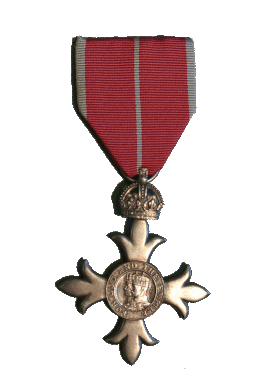
Member of The Order of the British Empire (MBE)
A member wears a silver badge (2 inches wide) on the left breast (no enamels).
Original Badge: A cross patonce (four arms with three points on each arm) of silver-gilt with the arms enamelled pearl-grey, surmounted by an Imperial Crown. The circular centre, in gold, shows the figure of Britannia, holding a trident and seated beside a shield bearing the national flag. The centre is surrounded by a circular band, enamelled crimson and bearing the motto FOR GOD AND THE EMPIRE in gold.
Current Badge (after 1937):As above except that in the centre, in gold, are the crowned effigies of King George V and his consort Queen Mary. Neither the original nor the current OBE and MBE badges are enamelled.
On the rverse a rope circle with the current Royal Cypher, surmounted by an Imperial Crown and with a hallmark on the lower limb.
A silver emblem of two oak leaves is worn on the riband when the appointment to the order is for gallantry. A ring is attached to the top of the crown through which a larger ring passes.
Original: The civil ribbon was purple (1.5 inches wide). The military ribbon had a narrow central stripe of scarlet added.
Current (after 1937): The civil ribbon is rose-pink with pearl grey edges. The military ribbon has a narrow central stripe of pearl grey added.
The order was established in June 1917. In December 1918, military and civil divisions were established.
On 09 March 1937, the insignia and ribbon were changed. After 01 January 1958, gallantry awards were recognized with silver oak leaves.
There have been a total of 2,726 MBEs issued to Canadians; 859 civil and 1,867 military.
http://thercr.ca/main/index.php?option=com_content&view=article&id=90&Itemid=200
Warrant Officer Class I Charles H.P. Trappitt MBE Awarded 5 May 1946 RSM 1947-1949
Colonel Robert Dimma Travis MBE Awarded 16 June 1945 15th Bde CFA 1916
A member wears a silver badge (2 inches wide) on the left breast (no enamels).
Original Badge: A cross patonce (four arms with three points on each arm) of silver-gilt with the arms enamelled pearl-grey, surmounted by an Imperial Crown. The circular centre, in gold, shows the figure of Britannia, holding a trident and seated beside a shield bearing the national flag. The centre is surrounded by a circular band, enamelled crimson and bearing the motto FOR GOD AND THE EMPIRE in gold.
Current Badge (after 1937):As above except that in the centre, in gold, are the crowned effigies of King George V and his consort Queen Mary. Neither the original nor the current OBE and MBE badges are enamelled.
On the rverse a rope circle with the current Royal Cypher, surmounted by an Imperial Crown and with a hallmark on the lower limb.
A silver emblem of two oak leaves is worn on the riband when the appointment to the order is for gallantry. A ring is attached to the top of the crown through which a larger ring passes.
Original: The civil ribbon was purple (1.5 inches wide). The military ribbon had a narrow central stripe of scarlet added.
Current (after 1937): The civil ribbon is rose-pink with pearl grey edges. The military ribbon has a narrow central stripe of pearl grey added.
The order was established in June 1917. In December 1918, military and civil divisions were established.
On 09 March 1937, the insignia and ribbon were changed. After 01 January 1958, gallantry awards were recognized with silver oak leaves.
There have been a total of 2,726 MBEs issued to Canadians; 859 civil and 1,867 military.
http://thercr.ca/main/index.php?option=com_content&view=article&id=90&Itemid=200
Warrant Officer Class I Charles H.P. Trappitt MBE Awarded 5 May 1946 RSM 1947-1949
Colonel Robert Dimma Travis MBE Awarded 16 June 1945 15th Bde CFA 1916
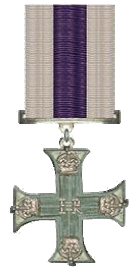
Military Cross (MC)
The Military Cross can be awarded to commissioned officers of the substantive rank of Captain or below (therefore acting and temporary Majors are eligible) or Warrant Officers for distinguished and meritorious services in battle. In 1920, the terms were altered to clearly state the award was for gallant and distinguished services in action and that naval and air force officers could be awarded the cross for gallant and distinguished services on the ground.
Description
A plain silver cross, 1.75 inches across. On each arm of the cross is an Imperial Crown and in the centre of the cross is the Imperial and Royal Cypher of the reigning sovereign (GV, GVI, or EIIR). The reverse is plain with the year of the award engraved on the lower arm. The ring welded to the top of the cross is joined to the plain straight suspender ring by a small ring (3 rings). A watered white ribbon (1.375 inches wide), with a central purple stripe (0.5 inches wide).
The Military Cross was established on 28 December 1914.
A total of 3,727 have gone to Canadians, with 324 first bars and 18 second bars.
http://www.veterans.gc.ca/eng/remembrance/medals-decorations/orders-decorations
The Military Cross can be awarded to commissioned officers of the substantive rank of Captain or below (therefore acting and temporary Majors are eligible) or Warrant Officers for distinguished and meritorious services in battle. In 1920, the terms were altered to clearly state the award was for gallant and distinguished services in action and that naval and air force officers could be awarded the cross for gallant and distinguished services on the ground.
Description
A plain silver cross, 1.75 inches across. On each arm of the cross is an Imperial Crown and in the centre of the cross is the Imperial and Royal Cypher of the reigning sovereign (GV, GVI, or EIIR). The reverse is plain with the year of the award engraved on the lower arm. The ring welded to the top of the cross is joined to the plain straight suspender ring by a small ring (3 rings). A watered white ribbon (1.375 inches wide), with a central purple stripe (0.5 inches wide).
The Military Cross was established on 28 December 1914.
A total of 3,727 have gone to Canadians, with 324 first bars and 18 second bars.
http://www.veterans.gc.ca/eng/remembrance/medals-decorations/orders-decorations
Captain C.R. Burton, MC, Adjutant 15th (Vancouver) Coast Brigade, RCA, NPAM 1940-1941
Lieutenant Joseph Gordon Chutter, MC, 2 April 1919, Vancouver Overseas Artillery Association in 1919
Lieutenant Arthur J. Cowan, MC, 9 November 1917, Vancouver Overseas Artillery Association in 1919
Lieutenant Achilles Daunt Golden, MC, member of 31st Battery 9th Brigade CFA in 1917
Lieutenant N. Hess, MC, Corps Reserve in 1922
Lieutenant H. Jones, MC, Lieutenant in 5th Medium Battery, 15th Field Brigade, CA in 1928
Lieutenant James Maxwell McIlquham, MC, 31st Battery 9th Brigade CFA
Lieutenant Vincent McKenna, 15th Field Brigade Canadian Field Artillery Canadian Expeditionary Force 1919
Major Harry Lyall McPherson, MC, Battery Commander 68 Battery in 1922
Captain H. Morton, MC, 31st Battery, 15th (Vancouver) Coast Brigade, RCA 1940
Captain Oliver Alexander Mowat, MC, Battery Captain, 68th Bty ,16th Bde, CFA North Russia Expeditionary Force
Lieutenant Walter Selkirk Newton, MC, 68th Bty, 16th Bde, CFA North Russia Expeditionary Force, 1919
Captain William Augustus Richardson, MC, 58th Heavy Battery, 15th (Vancouver) Coast Brigade, RCA 1940-1941
Lieutenant J. Roberts, MC, October 1918, 68th Battery 16th Brigade, CFA North Russia Expeditionary Force
Lieutenant Donald Graham Robertson, MC, 13 February 1917, 31st Battery, 8th Brigade CFA
Warrant Officer Class I Sverre Sorenson, MC, Regimental Sergeant Major 15th Field Brigade, CA 1924-1930
Lieutenant William Allen Townsley, MC, 26 May 1917, Commanding Officer 15th Field Brigade, CA 1924-1930
Captain F.C. Whitehead, MC, 68th Bty 15th Bde, CFA 1922, 58th Bty 15th (Vancouver) Coast Brigade, RCA 1940-1944
Captain A.L. Wilson, MC, 2 September 1918, Corps Reserve in 1922
Lieutenant Douglas J Winslow, MC, January 1919, 68th Battery 16th Brigade, CFA North Russia Expeditionary Force
For citations
Lieutenant Joseph Gordon Chutter, MC, 2 April 1919, Vancouver Overseas Artillery Association in 1919
Lieutenant Arthur J. Cowan, MC, 9 November 1917, Vancouver Overseas Artillery Association in 1919
Lieutenant Achilles Daunt Golden, MC, member of 31st Battery 9th Brigade CFA in 1917
Lieutenant N. Hess, MC, Corps Reserve in 1922
Lieutenant H. Jones, MC, Lieutenant in 5th Medium Battery, 15th Field Brigade, CA in 1928
Lieutenant James Maxwell McIlquham, MC, 31st Battery 9th Brigade CFA
Lieutenant Vincent McKenna, 15th Field Brigade Canadian Field Artillery Canadian Expeditionary Force 1919
Major Harry Lyall McPherson, MC, Battery Commander 68 Battery in 1922
Captain H. Morton, MC, 31st Battery, 15th (Vancouver) Coast Brigade, RCA 1940
Captain Oliver Alexander Mowat, MC, Battery Captain, 68th Bty ,16th Bde, CFA North Russia Expeditionary Force
Lieutenant Walter Selkirk Newton, MC, 68th Bty, 16th Bde, CFA North Russia Expeditionary Force, 1919
Captain William Augustus Richardson, MC, 58th Heavy Battery, 15th (Vancouver) Coast Brigade, RCA 1940-1941
Lieutenant J. Roberts, MC, October 1918, 68th Battery 16th Brigade, CFA North Russia Expeditionary Force
Lieutenant Donald Graham Robertson, MC, 13 February 1917, 31st Battery, 8th Brigade CFA
Warrant Officer Class I Sverre Sorenson, MC, Regimental Sergeant Major 15th Field Brigade, CA 1924-1930
Lieutenant William Allen Townsley, MC, 26 May 1917, Commanding Officer 15th Field Brigade, CA 1924-1930
Captain F.C. Whitehead, MC, 68th Bty 15th Bde, CFA 1922, 58th Bty 15th (Vancouver) Coast Brigade, RCA 1940-1944
Captain A.L. Wilson, MC, 2 September 1918, Corps Reserve in 1922
Lieutenant Douglas J Winslow, MC, January 1919, 68th Battery 16th Brigade, CFA North Russia Expeditionary Force
For citations

Distinguished Flying Cross
The cross is awarded to officers and Warrant Officers for an act or acts of valour, courage or devotion to duty performed whilst flying in active operations against the enemy.
A cross flory, 2.125 inches wide, with the horizontal and base bars terminated with bumps, the upper bar with a rose. For mounting, the straight bar has two sprigs of laurel at the bottom which form a slot for a king ring to attach it to the small ring at the top of the medal.
On the obverse, airplane propellers are superimposed upon the vertical arms of the cross. Within a central winged roundel which is encircled by a wreath of laurels and surmounted by an Imperial Crown, appear the letters RAF. The wings of the roundel fall upon the horizontal arms of the cross.
On the reverse, in the central circle the Royal Cypher (GV, GVI, EIIR) appears above the date. The year of issue is engraved on the lower arm.
The ribbon is 1.25 inches wide, and consists of alternating violet and white stripes (0.125 wide) leaning to the left at 45 degrees from the vertical. The violet colour is to appear in the bottom left and upper right corners when viewed on the wearer's chest. Until 1919, the stripes were horizontal.
A straight silver bar is awarded for a further act or acts of valour, courage or devotion to duty whilst flying in active operations against the enemy. The slip-on bar has an eagle in the centre. The year of the award is engraved on the reverse.
The DFC is issued unnamed.
A total of 4,460 have been awarded to Canadians, including 256 first bars and six second bars.
First World War: 193 to Canadians in the Royal Air Force (RAF), plus nine first bars
Lieutenant Claude Melnot Wilson (FRANCE)
Bold in attack, this officer never hesitates to join in an engagement with the •enemy, regardless of their numerical superiority. On 18th August, with four other machines, he attacked a large hostile formation. Five enemy machines .were destroyed, Lt. Wilson accounting for one. In all he has four machines and one balloon to his credit.
The cross is awarded to officers and Warrant Officers for an act or acts of valour, courage or devotion to duty performed whilst flying in active operations against the enemy.
A cross flory, 2.125 inches wide, with the horizontal and base bars terminated with bumps, the upper bar with a rose. For mounting, the straight bar has two sprigs of laurel at the bottom which form a slot for a king ring to attach it to the small ring at the top of the medal.
On the obverse, airplane propellers are superimposed upon the vertical arms of the cross. Within a central winged roundel which is encircled by a wreath of laurels and surmounted by an Imperial Crown, appear the letters RAF. The wings of the roundel fall upon the horizontal arms of the cross.
On the reverse, in the central circle the Royal Cypher (GV, GVI, EIIR) appears above the date. The year of issue is engraved on the lower arm.
The ribbon is 1.25 inches wide, and consists of alternating violet and white stripes (0.125 wide) leaning to the left at 45 degrees from the vertical. The violet colour is to appear in the bottom left and upper right corners when viewed on the wearer's chest. Until 1919, the stripes were horizontal.
A straight silver bar is awarded for a further act or acts of valour, courage or devotion to duty whilst flying in active operations against the enemy. The slip-on bar has an eagle in the centre. The year of the award is engraved on the reverse.
The DFC is issued unnamed.
A total of 4,460 have been awarded to Canadians, including 256 first bars and six second bars.
First World War: 193 to Canadians in the Royal Air Force (RAF), plus nine first bars
Lieutenant Claude Melnot Wilson (FRANCE)
Bold in attack, this officer never hesitates to join in an engagement with the •enemy, regardless of their numerical superiority. On 18th August, with four other machines, he attacked a large hostile formation. Five enemy machines .were destroyed, Lt. Wilson accounting for one. In all he has four machines and one balloon to his credit.

Distinguished Conduct Medal (DCM)
The DCM was created on 04 December 1854, because of the Crimea War and was first awarded to a Canadian on 19 April 1901.
Eligibility and Criteria
The Distinguished Conduct Medal (DCM) was awarded to Warrant Officers, non-commissioned officers, and non-commissioned members, serving in any of the sovereign's military forces, for distinguished conduct in the field. It was the second highest award for gallantry in action (after the Victoria Cross) for all army ranks below commissioned officers and was available to Navy and Air Force personnel also for distinguished conduct in the field.
Description
A circular, silver medal, 1.42 inches in diameter. For mounting an ornate scroll suspender is attached to the medal by a single-toe claw.
Medal obverse:
King Edward VII: uncrowned, in Field Marshal's uniform, facing left, with the legend EDWARDVS VII REX IMPERATOR
King George V: uncrowned, in Field Marshal's uniform, facing left, with the legend GEORGIVS V BRITT: OMN: REX ET IND: IMP:
King George VI:
1. A crowned effigy, facing left, with the legend: GEORGIVS VI D: G: BR: OMN: REX ET INDIAE IMP: (for the Second World War)
2. A crowned effigy, facing left, with the legend: GEORGIVS VI DEI GRA: BRITT: OMN: REX FID: DEF: (for Korea) BIU
The reverse shows FOR/DISTINGUISHED/CONDUCT/IN THE FIELD in four lines, with a horizontal line through a small oval wreath below the wording. Some Edward VII medals had the word CANADA above the inscription.
The crimson ribbon is 1.25 inches wide with a dark blue central stripe.
Bars
A silver, laurelled bar was awarded for a subsequent act or acts of distinguished conduct in the field.
http://www.veterans.gc.ca/eng/remembrance/medals-decorations/details/49
Battery Sergeant Major Herbert Rexford Lea DCM
Acting Sergeant (Cadet) Raymond Franklin Sharpe DCM
Acting Battery Quartermaster Sergeant Hugh Moore DCM
Sergeant Claude Drone Winegard DCM
The DCM was created on 04 December 1854, because of the Crimea War and was first awarded to a Canadian on 19 April 1901.
Eligibility and Criteria
The Distinguished Conduct Medal (DCM) was awarded to Warrant Officers, non-commissioned officers, and non-commissioned members, serving in any of the sovereign's military forces, for distinguished conduct in the field. It was the second highest award for gallantry in action (after the Victoria Cross) for all army ranks below commissioned officers and was available to Navy and Air Force personnel also for distinguished conduct in the field.
Description
A circular, silver medal, 1.42 inches in diameter. For mounting an ornate scroll suspender is attached to the medal by a single-toe claw.
Medal obverse:
King Edward VII: uncrowned, in Field Marshal's uniform, facing left, with the legend EDWARDVS VII REX IMPERATOR
King George V: uncrowned, in Field Marshal's uniform, facing left, with the legend GEORGIVS V BRITT: OMN: REX ET IND: IMP:
King George VI:
1. A crowned effigy, facing left, with the legend: GEORGIVS VI D: G: BR: OMN: REX ET INDIAE IMP: (for the Second World War)
2. A crowned effigy, facing left, with the legend: GEORGIVS VI DEI GRA: BRITT: OMN: REX FID: DEF: (for Korea) BIU
The reverse shows FOR/DISTINGUISHED/CONDUCT/IN THE FIELD in four lines, with a horizontal line through a small oval wreath below the wording. Some Edward VII medals had the word CANADA above the inscription.
The crimson ribbon is 1.25 inches wide with a dark blue central stripe.
Bars
A silver, laurelled bar was awarded for a subsequent act or acts of distinguished conduct in the field.
http://www.veterans.gc.ca/eng/remembrance/medals-decorations/details/49
Battery Sergeant Major Herbert Rexford Lea DCM
Acting Sergeant (Cadet) Raymond Franklin Sharpe DCM
Acting Battery Quartermaster Sergeant Hugh Moore DCM
Sergeant Claude Drone Winegard DCM
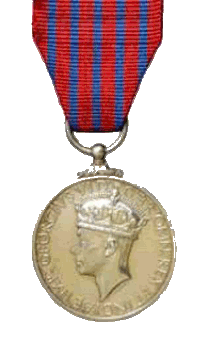
George Medal (GM)
The George Medal is the second highest civil award of the United Kingdom and Commonwealth. It ranks below the George Cross. It is only awarded for non-combat acts of bravery.
The GM was created on 24 September 1940 by King George VI. At this time, during the height of The Blitz, there was a desire to reward acts of civilian courage. It was decided that the George Cross and the GM would recognize civilian bravery in the face of enemy action and brave deeds more widely.
Announcing the new award, the King said:
"In order that they should be worthily and promptly recognized, I have decided to create, at once, a new mark of honour for men and women in all walks of civilian life. I propose to give my name to this new distinction, which will consist of the George Cross, which will rank next to the Victoria Cross, and the George Medal for wider distribution". The Warrant for the GM was published in the London Gazette on 31 January 1941. The medal is granted in recognition of "acts of great bravery".
The medal is primarily a civilian award, but it may be awarded to military personnel for gallant conduct that is not in the face of the enemy. As the Warrant states: The Medal is intended primarily for civilians and awards to military services is to be confined to actions for which purely military Honours are not normally granted. Bars are awarded to the GM in recognition of the performance of further acts of bravery meriting the award. In undress uniform or on occasions when the medal ribbon alone is worn, a silver rosette is worn on the ribbon to indicate each bar. Recipients are entitled to the postnominal letters GM.
http://www.veterans.gc.ca/eng/remembrance/medals-decorations/orders-decorations
Lieutenant Walter Douglas Elsdon GM 19 October 1945 Commanding Officer 1962-1965
The George Medal is the second highest civil award of the United Kingdom and Commonwealth. It ranks below the George Cross. It is only awarded for non-combat acts of bravery.
The GM was created on 24 September 1940 by King George VI. At this time, during the height of The Blitz, there was a desire to reward acts of civilian courage. It was decided that the George Cross and the GM would recognize civilian bravery in the face of enemy action and brave deeds more widely.
Announcing the new award, the King said:
"In order that they should be worthily and promptly recognized, I have decided to create, at once, a new mark of honour for men and women in all walks of civilian life. I propose to give my name to this new distinction, which will consist of the George Cross, which will rank next to the Victoria Cross, and the George Medal for wider distribution". The Warrant for the GM was published in the London Gazette on 31 January 1941. The medal is granted in recognition of "acts of great bravery".
The medal is primarily a civilian award, but it may be awarded to military personnel for gallant conduct that is not in the face of the enemy. As the Warrant states: The Medal is intended primarily for civilians and awards to military services is to be confined to actions for which purely military Honours are not normally granted. Bars are awarded to the GM in recognition of the performance of further acts of bravery meriting the award. In undress uniform or on occasions when the medal ribbon alone is worn, a silver rosette is worn on the ribbon to indicate each bar. Recipients are entitled to the postnominal letters GM.
http://www.veterans.gc.ca/eng/remembrance/medals-decorations/orders-decorations
Lieutenant Walter Douglas Elsdon GM 19 October 1945 Commanding Officer 1962-1965
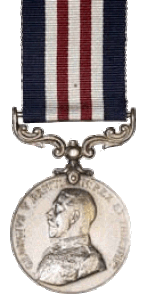
Military Medal (MM)
The medal is awarded to Warrant Officers, non-commissioned officers and men for individual or associated acts of bravery on the recommendation of a Commander-in-Chief in the field.
The silver, laurelled bar is awarded for a subsequent act or acts of bravery and devotion under fire.
A circular, silver medal, 1.42 inches in diameter with King George V: A bareheaded effigy, in Field Marshal's uniform, facing left, and the legend: GEORGIVS V BRITT: OMN: REX ET IND: IMP: or King George VI: A crowned effigy, facing left, and one of the legends:
The reverse shows FOR/BRAVERY/IN THE/FIELD in four lines, encircled by a laurel wreath and surmounted by the Royal Cypher and Imperial Crown. An ornate scroll suspender is attached to the medal with a single-toe claw. A dark blue ribbon, 1.25 inches wide, with five equal centre stripes of white, red, white, red, and white (0.125 inches each).
The regimental or equivalent number, rank, initials, surname and unit of the recipient appear in plain block capitals around the edge of the medal.
The medal was instituted on 25 March 1916. Canadians have received 13, 654 medals, plus 848 first bars and 38 second bars.
http://www.veterans.gc.ca/eng/remembrance/medals-decorations/orders-decorations
The following members with a connection to the history of the 15th Field Artillery Regiment RCA were awarded the Military Medal. Additional details can be found on the Military Medal page.
Sergeant J.A. Beddow MM 68th Battery 16th Brigade, CFA North Russia Expeditionary Force
Signaller J.P. Breiter, MM 68th Battery 16th Brigade, CFA North Russia Expeditionary Force
Signaller Donald William Buchanan, MM 68th Battery 16th Brigade, CFA North Russia Expeditionary Force
Signaller Thomas Leroy Chambers, MM 31st Battery, 8th Brigade, CFA, Canadian Expeditionary Force
Bombardier William Osser Cook, MM 68th Battery 16th Brigade, CFA North Russia Expeditionary Force
Bombardier John Murray Crocket, MM 68th Battery 16th Brigade, CFA North Russia Expeditionary Force
Corporal Philip Lawrence Debney, MM 68th Battery 16th Brigade, CFA North Russia Expeditionary Force
Sergeant Edward Arlett Dickie, MM 5th Siege Battery, CGA, Canadian Expeditionary Force
Driver W.J. Donahue, MM 68th Battery 16th Brigade, CFA North Russia Expeditionary Force
Gunner William Matthews Dowling, MM 68th Battery 16th Brigade, CFA North Russia Expeditionary Force
Gunner Sydney Phillip Fielding, MM 5th Siege Battery, CGA, Canadian Expeditionary Force
Gunner Fred Charles French, MM 68th Battery 16th Brigade, CFA North Russia Expeditionary Force
Corporal Thomas Bernard Greaves, MM 68th Battery 16th Brigade, CFA North Russia Expeditionary Force
Warrant Officer Class I Herbert Hankins, MM 15th Field Brigade, Canadian Artillery
Gunner Webster Rhodes Harrison, MM 68th Battery 16th Brigade, CFA North Russia Expeditionary Force
Corporal Walter Hughes, MM 68th Battery 16th Brigade, CFA North Russia Expeditionary Force
Gunner John McLean, MM 68th Battery 16th Brigade, CFA North Russia Expeditionary Force
Gunner Joseph William Murphy, MM 68th Battery 16th Brigade, CFA North Russia Expeditionary Force
Gunner William John Perryman, MM 68th Battery 16th Brigade, CFA North Russia Expeditionary Force
Gunner Charles Robertson, MM 68th Battery 16th Brigade, CFA North Russia Expeditionary Force
Corporal Edward Savage, MM 31st Battery, 8th Brigade, CFA, Canadian Expeditionary Force
Sergeant John Simmons, MM 31st Battery, 8th Brigade, CFA, Canadian Expeditionary Force
Brigadier Percy Curran Teesm MM, VD, ED 4th Trench Mortar Battery, CFA, Canadian Expeditionary Force
Driver George Watters, MM 68th Battery 16th Brigade, CFA North Russia Expeditionary Force
Gunner Allan Wilkinson, MM 68th Battery 16th Brigade, CFA North Russia Expeditionary Force
Gunner Valentine William Henry Hansen, MM 15th Field Regiment, RCA
Click here to see citations
The medal is awarded to Warrant Officers, non-commissioned officers and men for individual or associated acts of bravery on the recommendation of a Commander-in-Chief in the field.
The silver, laurelled bar is awarded for a subsequent act or acts of bravery and devotion under fire.
A circular, silver medal, 1.42 inches in diameter with King George V: A bareheaded effigy, in Field Marshal's uniform, facing left, and the legend: GEORGIVS V BRITT: OMN: REX ET IND: IMP: or King George VI: A crowned effigy, facing left, and one of the legends:
- GEORGIVS VI D: G: BR: OMN: REX ET INDIAE IMP: (for WWII)
- GEORGIVS VI DEI GRA: BRITT: OMN: REX FID: DEF: (for Korea)
The reverse shows FOR/BRAVERY/IN THE/FIELD in four lines, encircled by a laurel wreath and surmounted by the Royal Cypher and Imperial Crown. An ornate scroll suspender is attached to the medal with a single-toe claw. A dark blue ribbon, 1.25 inches wide, with five equal centre stripes of white, red, white, red, and white (0.125 inches each).
The regimental or equivalent number, rank, initials, surname and unit of the recipient appear in plain block capitals around the edge of the medal.
The medal was instituted on 25 March 1916. Canadians have received 13, 654 medals, plus 848 first bars and 38 second bars.
http://www.veterans.gc.ca/eng/remembrance/medals-decorations/orders-decorations
The following members with a connection to the history of the 15th Field Artillery Regiment RCA were awarded the Military Medal. Additional details can be found on the Military Medal page.
Sergeant J.A. Beddow MM 68th Battery 16th Brigade, CFA North Russia Expeditionary Force
Signaller J.P. Breiter, MM 68th Battery 16th Brigade, CFA North Russia Expeditionary Force
Signaller Donald William Buchanan, MM 68th Battery 16th Brigade, CFA North Russia Expeditionary Force
Signaller Thomas Leroy Chambers, MM 31st Battery, 8th Brigade, CFA, Canadian Expeditionary Force
Bombardier William Osser Cook, MM 68th Battery 16th Brigade, CFA North Russia Expeditionary Force
Bombardier John Murray Crocket, MM 68th Battery 16th Brigade, CFA North Russia Expeditionary Force
Corporal Philip Lawrence Debney, MM 68th Battery 16th Brigade, CFA North Russia Expeditionary Force
Sergeant Edward Arlett Dickie, MM 5th Siege Battery, CGA, Canadian Expeditionary Force
Driver W.J. Donahue, MM 68th Battery 16th Brigade, CFA North Russia Expeditionary Force
Gunner William Matthews Dowling, MM 68th Battery 16th Brigade, CFA North Russia Expeditionary Force
Gunner Sydney Phillip Fielding, MM 5th Siege Battery, CGA, Canadian Expeditionary Force
Gunner Fred Charles French, MM 68th Battery 16th Brigade, CFA North Russia Expeditionary Force
Corporal Thomas Bernard Greaves, MM 68th Battery 16th Brigade, CFA North Russia Expeditionary Force
Warrant Officer Class I Herbert Hankins, MM 15th Field Brigade, Canadian Artillery
Gunner Webster Rhodes Harrison, MM 68th Battery 16th Brigade, CFA North Russia Expeditionary Force
Corporal Walter Hughes, MM 68th Battery 16th Brigade, CFA North Russia Expeditionary Force
Gunner John McLean, MM 68th Battery 16th Brigade, CFA North Russia Expeditionary Force
Gunner Joseph William Murphy, MM 68th Battery 16th Brigade, CFA North Russia Expeditionary Force
Gunner William John Perryman, MM 68th Battery 16th Brigade, CFA North Russia Expeditionary Force
Gunner Charles Robertson, MM 68th Battery 16th Brigade, CFA North Russia Expeditionary Force
Corporal Edward Savage, MM 31st Battery, 8th Brigade, CFA, Canadian Expeditionary Force
Sergeant John Simmons, MM 31st Battery, 8th Brigade, CFA, Canadian Expeditionary Force
Brigadier Percy Curran Teesm MM, VD, ED 4th Trench Mortar Battery, CFA, Canadian Expeditionary Force
Driver George Watters, MM 68th Battery 16th Brigade, CFA North Russia Expeditionary Force
Gunner Allan Wilkinson, MM 68th Battery 16th Brigade, CFA North Russia Expeditionary Force
Gunner Valentine William Henry Hansen, MM 15th Field Regiment, RCA
Click here to see citations

Mention in Dispatches (MID)
Members of the Canadian Forces on active service and other individuals working with or in conjunction with the Canadian Forces on or after November 1, 1990 are eligible for the award of the Insignia.
Mention in Dispatches shall be awarded for valiant conduct, devotion to duty or other distinguished service.
The Insignia shall consist of a bronze oak leaf, 30mm long and 9 mm wide at its widest point.
The Insignia shall be worn horizontally on the concerned mission medal ribbon or undress ribbon, with the stalk of the oak leaf furthest from the left shoulder.
If the medal in question has a bar, the Insignia of the MID is worn above the bar and spaced equally with it and any other devise (such as a numeral) on the ribbon. If the undress ribbon also displays other devices, the MID is worn at the left of the other devices and spaced equally with them on the ribbon.
When the MID is awarded and there is no mission ribbon, the MID shall be worn horizontal and centered on the left breast with the stalk of the oak leaf furthest from the left shoulder.
Only one MID may be worn on any one medal.
Note that the insignia, when issued under British regulations for the Second World War and the Korean conflict, was worn at an angle, stalk down.
During the First World War, 5467 MIDs were awarded to Canadians.
During the Second World War, MID's were awarded as follows: 6432 to the Canadian Army, 2197 to the Royal Canadian Air Force and 1037 to the Royal Canadian Navy for a total of 9666 MID's awarded.
During the Korean conflict, MID's were awarded as follows: 246 to the Canadian Army and 33 to the Royal Canadian Navy for a total 279 MID's awarded.
In 1990, the MID was re-introduced in the Canadian Forces.
Members of the Canadian Forces on active service and other individuals working with or in conjunction with the Canadian Forces on or after November 1, 1990 are eligible for the award of the Insignia.
Mention in Dispatches shall be awarded for valiant conduct, devotion to duty or other distinguished service.
The Insignia shall consist of a bronze oak leaf, 30mm long and 9 mm wide at its widest point.
The Insignia shall be worn horizontally on the concerned mission medal ribbon or undress ribbon, with the stalk of the oak leaf furthest from the left shoulder.
If the medal in question has a bar, the Insignia of the MID is worn above the bar and spaced equally with it and any other devise (such as a numeral) on the ribbon. If the undress ribbon also displays other devices, the MID is worn at the left of the other devices and spaced equally with them on the ribbon.
When the MID is awarded and there is no mission ribbon, the MID shall be worn horizontal and centered on the left breast with the stalk of the oak leaf furthest from the left shoulder.
Only one MID may be worn on any one medal.
Note that the insignia, when issued under British regulations for the Second World War and the Korean conflict, was worn at an angle, stalk down.
During the First World War, 5467 MIDs were awarded to Canadians.
During the Second World War, MID's were awarded as follows: 6432 to the Canadian Army, 2197 to the Royal Canadian Air Force and 1037 to the Royal Canadian Navy for a total of 9666 MID's awarded.
During the Korean conflict, MID's were awarded as follows: 246 to the Canadian Army and 33 to the Royal Canadian Navy for a total 279 MID's awarded.
In 1990, the MID was re-introduced in the Canadian Forces.

Queen's South Africa Medal (QSA)
British campaign medal awarded to British and Colonial military personnel, and to civilians employed in an official capacity, who served in the Second Boer War in South Africa. Altogether twenty-six clasps were awarded, to indicate participation in particular actions and campaigns.
CAPE COLONY, NATAL, RHODESIA, RELIEF OF MAFEKING, DEFENCE OF KIMBERLEY, TALANA, ELANDSLAAGTE, DEFENCE OF LADYSMITH, BELMONT, MODDER RIVER,TUGELA HEIGHTS,
RELIEF OF KIMBERLEY, PAARDEBERG, ORANGE FREE STATE, RELIEF OF LADYSMITH, DRIEFONTEIN, WEPENER, DEFENCE OF MAFEKING, TRANSVAAL, JOHANNESBURG, LAING'S NEK, DIAMOND HILL, WITTEBERGEN, BELFAST, SOUTH AFRICA 1901, SOUTH AFRICA 1902.
Gunner Stewart Isley Howard Wylie
British campaign medal awarded to British and Colonial military personnel, and to civilians employed in an official capacity, who served in the Second Boer War in South Africa. Altogether twenty-six clasps were awarded, to indicate participation in particular actions and campaigns.
CAPE COLONY, NATAL, RHODESIA, RELIEF OF MAFEKING, DEFENCE OF KIMBERLEY, TALANA, ELANDSLAAGTE, DEFENCE OF LADYSMITH, BELMONT, MODDER RIVER,TUGELA HEIGHTS,
RELIEF OF KIMBERLEY, PAARDEBERG, ORANGE FREE STATE, RELIEF OF LADYSMITH, DRIEFONTEIN, WEPENER, DEFENCE OF MAFEKING, TRANSVAAL, JOHANNESBURG, LAING'S NEK, DIAMOND HILL, WITTEBERGEN, BELFAST, SOUTH AFRICA 1901, SOUTH AFRICA 1902.
Gunner Stewart Isley Howard Wylie
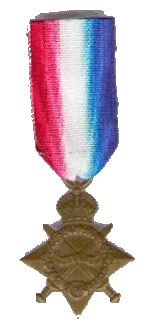
1914 - 1915 Star (14/15)
The star was awarded to all who saw service in any theatre of war against the central powers between 05 August 1914 and 31 December 1915 except those eligible for the 1914 Star. Canada considered 'overseas' to be service beyond the three mile limit and hence many RCN small ships were entitled to this star. There is no bar.
A bronze four-pointed star, 1.75 inches wide and 2.25 inches top to bottom, with its uppermost point replaced by a crown. Across the face of the star are two crossed swords (blades upward), with the blades and hilts protruding to form four additional points of the star. (The design is the same as the 1914 Star.) In the centre is a scroll with 1914-15. This is surrounded by a laurel wreath and on the bottom is the Royal Cypher GV (large G with smaller V inside).
The reverse is plain. A suspension ring at the top of the crown is stamped out solid with the star. The watered ribbon (1.25 inches wide), is shaded left to right: red, white, and blue. Engraved on the reverse are the recipient's number, rank and name for the first issue. The award was authorized in December 1918. There were 71,150 issued to Canadians (of a total 2,366,000 issued).
http://www.veterans.gc.ca/eng/remembrance/medals-decorations/orders-decorations
The star was awarded to all who saw service in any theatre of war against the central powers between 05 August 1914 and 31 December 1915 except those eligible for the 1914 Star. Canada considered 'overseas' to be service beyond the three mile limit and hence many RCN small ships were entitled to this star. There is no bar.
A bronze four-pointed star, 1.75 inches wide and 2.25 inches top to bottom, with its uppermost point replaced by a crown. Across the face of the star are two crossed swords (blades upward), with the blades and hilts protruding to form four additional points of the star. (The design is the same as the 1914 Star.) In the centre is a scroll with 1914-15. This is surrounded by a laurel wreath and on the bottom is the Royal Cypher GV (large G with smaller V inside).
The reverse is plain. A suspension ring at the top of the crown is stamped out solid with the star. The watered ribbon (1.25 inches wide), is shaded left to right: red, white, and blue. Engraved on the reverse are the recipient's number, rank and name for the first issue. The award was authorized in December 1918. There were 71,150 issued to Canadians (of a total 2,366,000 issued).
http://www.veterans.gc.ca/eng/remembrance/medals-decorations/orders-decorations
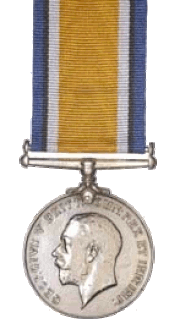
British War Medal (BWM)
The medal was awarded to all ranks of Canadian overseas military forces who came from Canada between 05 August 1914 and 11 November 1918, or who had served in a theatre of war. Those who had enlisted in the O.M.F.C. in the United Kingdom and had not served in a theatre of war were not entitled to this medal.
The requirements for RAF personnel were the same as for the army. Naval personnel were required to have 28 days of mobilized service or to have lost their lives before this period of service was complete. Seamen of the Canadian Merchant Marine who served at sea not less than six months, and crews of Dominion Government Ships and the Canadian Mercantile Marine were also eligible.
There was no bar to this medal.
A circular, silver medal, 1.42 inches in diameter. (The medal awarded to Chinese, Maltese and Native Labour Corps was bronze.) The obverse shows the King George V, bareheaded coinage effigy, facing left, with the legend: GEORGIVS V BRITT : OMN : REX ET IND : IMP : On the reverse a horseman (St. George, naked), armed with a short sword (an allegory of the physical and mental strength which achieves victory over Prussianism). The horse tramples on the Prussian shield and the skull and cross-bones. Just off-centre, near the right upper rim, is the sun of Victory. The dates 1914 and 1918 appear in the left and right fields respectively.
The mounting is a non-swivelling suspender with a single-toe claw. The watered ribbon is 1.25 inches wide, and consists of seven stripes: blue (0.125 inches), black (0.0625 inches), white (0.125 inches), orange centre (0.625 inches wide), white (0.125 inches), black (0.0325 inches), and blue (0.125 inches). The recipient's name, number and rank are engraved on the rim for the first issue.
The medal was authorized on 26 July 1919. There were 427,993 issued to Canadians in the CEF out of 6,500,000 total. http://www.veterans.gc.ca/eng/remembrance/medals-decorations/orders-decorations
The medal was awarded to all ranks of Canadian overseas military forces who came from Canada between 05 August 1914 and 11 November 1918, or who had served in a theatre of war. Those who had enlisted in the O.M.F.C. in the United Kingdom and had not served in a theatre of war were not entitled to this medal.
The requirements for RAF personnel were the same as for the army. Naval personnel were required to have 28 days of mobilized service or to have lost their lives before this period of service was complete. Seamen of the Canadian Merchant Marine who served at sea not less than six months, and crews of Dominion Government Ships and the Canadian Mercantile Marine were also eligible.
There was no bar to this medal.
A circular, silver medal, 1.42 inches in diameter. (The medal awarded to Chinese, Maltese and Native Labour Corps was bronze.) The obverse shows the King George V, bareheaded coinage effigy, facing left, with the legend: GEORGIVS V BRITT : OMN : REX ET IND : IMP : On the reverse a horseman (St. George, naked), armed with a short sword (an allegory of the physical and mental strength which achieves victory over Prussianism). The horse tramples on the Prussian shield and the skull and cross-bones. Just off-centre, near the right upper rim, is the sun of Victory. The dates 1914 and 1918 appear in the left and right fields respectively.
The mounting is a non-swivelling suspender with a single-toe claw. The watered ribbon is 1.25 inches wide, and consists of seven stripes: blue (0.125 inches), black (0.0625 inches), white (0.125 inches), orange centre (0.625 inches wide), white (0.125 inches), black (0.0325 inches), and blue (0.125 inches). The recipient's name, number and rank are engraved on the rim for the first issue.
The medal was authorized on 26 July 1919. There were 427,993 issued to Canadians in the CEF out of 6,500,000 total. http://www.veterans.gc.ca/eng/remembrance/medals-decorations/orders-decorations
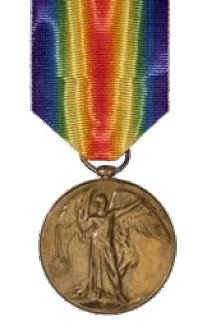
Victory Medal (Inter-Allied War Medal) (VM)
The medal was awarded to all ranks of the fighting forces, to civilians under contract, and others employed with military hospitals who actually served on the establishment of a unit in a theatre of war between 05 August 1914 and 11 November 1918 (inclusive). It was also awarded to members of the British Naval mission to Russia 1919 - 1920 and for mine clearance in the North Sea between 11 November 1918 and 30 November 1919. This medal was never issued alone and was always issued with the British War Medal.
Only the Mentioned-in-Despatches multiple-leaved emblem is worn on this medal when it was awarded for WWI. There were no other bars.
It is a copper medal, lacquered bronze, 1.42 inches in diameter. The obverse shows the winged, full-length, full-front, figure of Victory, with her left arm extended and holding a palm branch in her right hand. The reverse shows the legend THE GREAT / WAR FOR / CIVILISATION / 1914 - 1919 in four lines, surrounded by a wreath, with dots below the words.
MountingA ring (0.5 inches diameter) passes through a loop fixed to the top of the medal. The ring moves forwards and backwards but not sideways.
The watered ribbon is 1.5 inches (39 mm) wide, and consists of nine coloured stripes: violet, blue, green, yellow, red (centre), yellow, green, blue, and violet.
The Inter-Allied War Medal was agreed to by all allies in March 1919. All medals were to be almost identical to obviate the need to exchange allied medals and each was patterned after a French medal of 1870. The medal was authorized in Britain (and for Canadians) on 01 September 1919.
There were 351,289 medals awarded to the CEF (of the 5,725,000 total issued).
The recipient's name, number and rank are engraved on the rim for the first issue
http://www.veterans.gc.ca/eng/remembrance/medals-decorations/orders-decorations
The medal was awarded to all ranks of the fighting forces, to civilians under contract, and others employed with military hospitals who actually served on the establishment of a unit in a theatre of war between 05 August 1914 and 11 November 1918 (inclusive). It was also awarded to members of the British Naval mission to Russia 1919 - 1920 and for mine clearance in the North Sea between 11 November 1918 and 30 November 1919. This medal was never issued alone and was always issued with the British War Medal.
Only the Mentioned-in-Despatches multiple-leaved emblem is worn on this medal when it was awarded for WWI. There were no other bars.
It is a copper medal, lacquered bronze, 1.42 inches in diameter. The obverse shows the winged, full-length, full-front, figure of Victory, with her left arm extended and holding a palm branch in her right hand. The reverse shows the legend THE GREAT / WAR FOR / CIVILISATION / 1914 - 1919 in four lines, surrounded by a wreath, with dots below the words.
MountingA ring (0.5 inches diameter) passes through a loop fixed to the top of the medal. The ring moves forwards and backwards but not sideways.
The watered ribbon is 1.5 inches (39 mm) wide, and consists of nine coloured stripes: violet, blue, green, yellow, red (centre), yellow, green, blue, and violet.
The Inter-Allied War Medal was agreed to by all allies in March 1919. All medals were to be almost identical to obviate the need to exchange allied medals and each was patterned after a French medal of 1870. The medal was authorized in Britain (and for Canadians) on 01 September 1919.
There were 351,289 medals awarded to the CEF (of the 5,725,000 total issued).
The recipient's name, number and rank are engraved on the rim for the first issue
http://www.veterans.gc.ca/eng/remembrance/medals-decorations/orders-decorations

British Meritorious Service Medal (MSM)
This medal was awarded for valuable and commendable service by those in the permanent forces including Warrant Officers and senior Non-commissioned Officers (NCOs) (Sergeant or above), who were:
"duly recommended for the grant in respect of gallant conduct in the performance of military duty otherwise than in action against the enemy, or in saving, or attempting to save the life of an officer or soldier, or for devotion to duty in a theatre of war."
A circular, silver medal, 1.42 inches in diameter. For mounting, an ornate scroll suspender is attached to the medal with a single-toe claw.
On the obverse:
King George V: An effigy in Field Marshal's uniform, facing left, and the legend: GEORGIVS V BRITT : OMN : REX ET IND : IMP :
The reverse displays the inscription FOR / MERITORIOUS / SERVICE in three lines, encircled by two laurel leaves, tied at the bottom with a bow and separated at the top by an Imperial Crown. King Edward VII and King George V medals bear the word CANADA above the crown.
The crimson ribbon is 1.25 inches wide. Because the ribbon was the same as that for the Victoria Cross (VC), white edge stripes were added in 1916; and in 1917 a narrow white central stripe was added.
The number of medals issued to Canadians was 275 for service and 1430 for gallantry.
Farrier Sergeant Wallace Garfield Fisher MSM 68th Battery, 16th Brigade, Canadian Field Artillery
Bombardier Albert Augustsen MSM enrolled 68th Overseas Depot Battery, Canadian Field Artillery
Captain Frederick Alfred Leyfield enrolled 68th Overseas Depot Battery, Canadian Field Artillery
This medal was awarded for valuable and commendable service by those in the permanent forces including Warrant Officers and senior Non-commissioned Officers (NCOs) (Sergeant or above), who were:
"duly recommended for the grant in respect of gallant conduct in the performance of military duty otherwise than in action against the enemy, or in saving, or attempting to save the life of an officer or soldier, or for devotion to duty in a theatre of war."
A circular, silver medal, 1.42 inches in diameter. For mounting, an ornate scroll suspender is attached to the medal with a single-toe claw.
On the obverse:
King George V: An effigy in Field Marshal's uniform, facing left, and the legend: GEORGIVS V BRITT : OMN : REX ET IND : IMP :
The reverse displays the inscription FOR / MERITORIOUS / SERVICE in three lines, encircled by two laurel leaves, tied at the bottom with a bow and separated at the top by an Imperial Crown. King Edward VII and King George V medals bear the word CANADA above the crown.
The crimson ribbon is 1.25 inches wide. Because the ribbon was the same as that for the Victoria Cross (VC), white edge stripes were added in 1916; and in 1917 a narrow white central stripe was added.
The number of medals issued to Canadians was 275 for service and 1430 for gallantry.
Farrier Sergeant Wallace Garfield Fisher MSM 68th Battery, 16th Brigade, Canadian Field Artillery
Bombardier Albert Augustsen MSM enrolled 68th Overseas Depot Battery, Canadian Field Artillery
Captain Frederick Alfred Leyfield enrolled 68th Overseas Depot Battery, Canadian Field Artillery

1939-1945 Star (39/45)
The Star was awarded for six months service on active operations for Army and Navy, and two months for active air-crew between 02 September 1939 and 08 May 1945 (Europe) or 02 September 1945 (Pacific).
Battle of Britain: This bar was awarded to those members of the crews of fighter aircraft who took part in the Battle of Britain between 10 July and 31 October 1940
The ribbon consists of three equal stripes: dark blue, red, and light blue (representing the navy, army and air force).
http://www.veterans.gc.ca/eng/remembrance/medals-decorations/orders-decorations
Lieutenant Walter Douglas Elsdon GM Commanding Officer 1962-1965
Lieutenant-Colonel Aeneas E. McBean Bell-Irving OBE ED Honorary Colonel 1957
Sergeant Arne Knudsen
The Star was awarded for six months service on active operations for Army and Navy, and two months for active air-crew between 02 September 1939 and 08 May 1945 (Europe) or 02 September 1945 (Pacific).
Battle of Britain: This bar was awarded to those members of the crews of fighter aircraft who took part in the Battle of Britain between 10 July and 31 October 1940
The ribbon consists of three equal stripes: dark blue, red, and light blue (representing the navy, army and air force).
http://www.veterans.gc.ca/eng/remembrance/medals-decorations/orders-decorations
Lieutenant Walter Douglas Elsdon GM Commanding Officer 1962-1965
Lieutenant-Colonel Aeneas E. McBean Bell-Irving OBE ED Honorary Colonel 1957
Sergeant Arne Knudsen
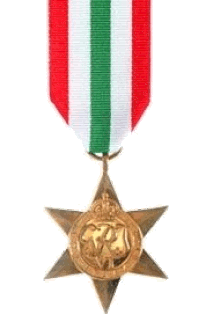
Italy Star (IS)
The star was awarded for one day operational service in Sicily or Italy between 11 June 1943 and 08 May 1945.
Please note that the above is only a summary outline of the conditions that apply to this medal.
There was no bar to this medal.
The ribbon consists of equal stripes of red, white, green, white, and red. The colours represent the colours of the Italian flag.
http://www.veterans.gc.ca/eng/remembrance/medals-decorations/orders-decorations
Lieutenant Walter Douglas Elsdon GM Commanding Officer 1962-1965
Sergeant Arne Knudsen
The star was awarded for one day operational service in Sicily or Italy between 11 June 1943 and 08 May 1945.
Please note that the above is only a summary outline of the conditions that apply to this medal.
There was no bar to this medal.
The ribbon consists of equal stripes of red, white, green, white, and red. The colours represent the colours of the Italian flag.
http://www.veterans.gc.ca/eng/remembrance/medals-decorations/orders-decorations
Lieutenant Walter Douglas Elsdon GM Commanding Officer 1962-1965
Sergeant Arne Knudsen

France and Germany Star (FG)
The Star was awarded for one day or more of service in France, Belgium, Holland or Germany between 06 June 1944 (D-Day) and 08 May 1945.
If later entitled to the Atlantic star, the ATLANTIC bar would be worn.
The ribbon consists of equal stripes of blue, white, red, white, and blue. The colours represent the Union flag and those of France and the Netherlands but not of Belgium.
http://www.veterans.gc.ca/eng/remembrance/medals-decorations/orders-decorations
Lieutenant-Colonel Aeneas E. McBean Bell-Irving OBE ED Honorary Colonel 1957
Lieutenant Walter Douglas Elsdon GM Commanding Officer 1962-1965
Sergeant Arne Knudsen
The Star was awarded for one day or more of service in France, Belgium, Holland or Germany between 06 June 1944 (D-Day) and 08 May 1945.
If later entitled to the Atlantic star, the ATLANTIC bar would be worn.
The ribbon consists of equal stripes of blue, white, red, white, and blue. The colours represent the Union flag and those of France and the Netherlands but not of Belgium.
http://www.veterans.gc.ca/eng/remembrance/medals-decorations/orders-decorations
Lieutenant-Colonel Aeneas E. McBean Bell-Irving OBE ED Honorary Colonel 1957
Lieutenant Walter Douglas Elsdon GM Commanding Officer 1962-1965
Sergeant Arne Knudsen

Defence Medal (DM)
Although the medal was usually awarded to Canadians for six months service in Britain between 03 September 1939 and 08 May 1945, the exact terms were: Service in the forces in non-operational areas subjected to air attack or closely threatened, providing such service lasted for three or more years. Service overseas or outside the country of residence, providing that such service lasted for one year, except in territories threatened by the enemy or subject to bomb attacks, in which case it was six months prior to 02 September 1945. Under the terms of this last condition, Canadians serving for one year in Newfoundland were eligible and persons serving for six months in Hong Kong were also eligible. The qualifying period in mine and bomb disposal was three months. Canadians serving in West Africa, Palestine and India, other than operational air crew, qualified for this medal. Those awarded the GC or GM for civil defence received this medal. Home Guard and others in Britain qualified for this medal.
There was no bar to this medal.
A circular, silver (.800 fine) medal, 1.42 inches in diameter. The British issue medals were made of cupro-nickel. The obverse shows the bareheaded coinage effigy of King George VI, facing left, and the legend: GEORGIVS VI D: BR: OMN: REX F: D: IND: IMP: On the reverse, the Royal Crown rests on the stump of an oak tree, flanked by a lion and a lioness. At the top left is the date 1939, and at the top right, the date 1945. In exergue, though not ruled off, is the wording: THE DEFENCE/MEDAL.
MountingA plain, straight, non-swivelling suspender with a single-toe claw.
RibbonThe light green ribbon is 1.25 inches wide with a central stripe of orange (0.5 inches wide) and a narrow black stripe in the middle of each green stripe. The orange (flame colour) represents the enemy attacks on the green land of England and the black represents the black-outs.
The award was established on 16 August 1945.
http://www.veterans.gc.ca/eng/remembrance/medals-decorations/orders-decorations
Although the medal was usually awarded to Canadians for six months service in Britain between 03 September 1939 and 08 May 1945, the exact terms were: Service in the forces in non-operational areas subjected to air attack or closely threatened, providing such service lasted for three or more years. Service overseas or outside the country of residence, providing that such service lasted for one year, except in territories threatened by the enemy or subject to bomb attacks, in which case it was six months prior to 02 September 1945. Under the terms of this last condition, Canadians serving for one year in Newfoundland were eligible and persons serving for six months in Hong Kong were also eligible. The qualifying period in mine and bomb disposal was three months. Canadians serving in West Africa, Palestine and India, other than operational air crew, qualified for this medal. Those awarded the GC or GM for civil defence received this medal. Home Guard and others in Britain qualified for this medal.
There was no bar to this medal.
A circular, silver (.800 fine) medal, 1.42 inches in diameter. The British issue medals were made of cupro-nickel. The obverse shows the bareheaded coinage effigy of King George VI, facing left, and the legend: GEORGIVS VI D: BR: OMN: REX F: D: IND: IMP: On the reverse, the Royal Crown rests on the stump of an oak tree, flanked by a lion and a lioness. At the top left is the date 1939, and at the top right, the date 1945. In exergue, though not ruled off, is the wording: THE DEFENCE/MEDAL.
MountingA plain, straight, non-swivelling suspender with a single-toe claw.
RibbonThe light green ribbon is 1.25 inches wide with a central stripe of orange (0.5 inches wide) and a narrow black stripe in the middle of each green stripe. The orange (flame colour) represents the enemy attacks on the green land of England and the black represents the black-outs.
The award was established on 16 August 1945.
http://www.veterans.gc.ca/eng/remembrance/medals-decorations/orders-decorations
Lieutenant-Colonel Aeneas E. McBean Bell-Irving OBE ED Honorary Colonel 1957
Captain Edward Joseph Duckering Edmonds
Lieutenant Walter Douglas Elsdon GM Commanding Officer 1962-1965
Captain Edward Joseph Duckering Edmonds
Lieutenant Walter Douglas Elsdon GM Commanding Officer 1962-1965
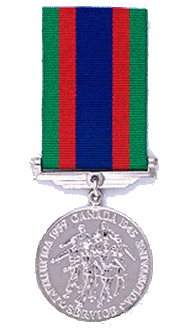
Canadian Volunteer Service Medal (CVSM)
The Canadian Volunteer Service Medal is granted to persons of any rank in the Naval, Military or Air Forces of Canada who voluntarily served on Active Service and honourably completed eighteen months (540 days) total voluntary service from September 3, 1939 to March 1, 1947.
On June 6, 2003, eligibility to the Canadian Volunteer Service Medal was extended to members and reserve constables of the Royal Canadian Mounted Police who voluntarily served during the Second World War.
A silver bar (often called a clasp), a maple leaf at its centre, was awarded for 60 days service outside Canada. A silver maple leaf is worn on the ribbon in undress.
A circular, silver medal (.925 fine silver), 1.42 inches in diameter. Seven marching figures are depicted, representing men and women of the army, air force, navy and nursing service; and around the rim, the inscription 1939 CANADA 1945 VOLUNTARY SERVICE VOLONTAIRE. The reverse shows the coat of arms of Canada. The medal is linked to a straight suspender by a small ring passing through a small fixed ring at the top of the medal. The ribbon is 1.25 inches wide with a royal blue centre (0.5 inches) flanked by two equal stripes of scarlet and dark green, the dark green being on the edges. The ribbon was issued during the war; the medal after the war.
The medal was established on 22 October 1943.
http://www.veterans.gc.ca/eng/remembrance/medals-decorations/orders-decorations
The Canadian Volunteer Service Medal is granted to persons of any rank in the Naval, Military or Air Forces of Canada who voluntarily served on Active Service and honourably completed eighteen months (540 days) total voluntary service from September 3, 1939 to March 1, 1947.
On June 6, 2003, eligibility to the Canadian Volunteer Service Medal was extended to members and reserve constables of the Royal Canadian Mounted Police who voluntarily served during the Second World War.
A silver bar (often called a clasp), a maple leaf at its centre, was awarded for 60 days service outside Canada. A silver maple leaf is worn on the ribbon in undress.
A circular, silver medal (.925 fine silver), 1.42 inches in diameter. Seven marching figures are depicted, representing men and women of the army, air force, navy and nursing service; and around the rim, the inscription 1939 CANADA 1945 VOLUNTARY SERVICE VOLONTAIRE. The reverse shows the coat of arms of Canada. The medal is linked to a straight suspender by a small ring passing through a small fixed ring at the top of the medal. The ribbon is 1.25 inches wide with a royal blue centre (0.5 inches) flanked by two equal stripes of scarlet and dark green, the dark green being on the edges. The ribbon was issued during the war; the medal after the war.
The medal was established on 22 October 1943.
http://www.veterans.gc.ca/eng/remembrance/medals-decorations/orders-decorations

War Medal 1939-1945 (WM)
The War Medal was awarded to all full-time personnel of the armed forces and merchant marines for serving for 28 days between 03 September 1939 and 02 September 1945. In the Merchant Navy, the 28 days must have been served at sea.
A single oak leaf emblem is worn to signify a Mention-in-Despatches and the silver oak leaf signifying a King's Commendation for Brave Conduct is worn on this medal. There is no bar other than these emblems.
A circular, (.800 fine) silver medal, 1.42 inches in diameter. The British issue medals were made of cupro-nickel. The obverse shows the crowned coinage effigy of King George VI, facing left, and the legend GEORGIVS VI D : BR : OMN : REX ET INDIAE IMP : The reverse device shows a lion standing wanton on the body of a double-headed dragon. The dragons heads are those of an eagle and a dragon to signify the principal occidental and oriental enemies. At the top, just right of centre are the dates 1939/1945 in two lines. A plain, straight non-swivelling suspender with a single-toe claw. The ribbon is 1.25 inches wide and consists of 7 coloured stripes: red, dark blue, white, narrow red (centre), white, dark blue, and red.
The award was established on 16 August 1945.
http://www.veterans.gc.ca/eng/remembrance/medals-decorations/orders-decorations
The War Medal was awarded to all full-time personnel of the armed forces and merchant marines for serving for 28 days between 03 September 1939 and 02 September 1945. In the Merchant Navy, the 28 days must have been served at sea.
A single oak leaf emblem is worn to signify a Mention-in-Despatches and the silver oak leaf signifying a King's Commendation for Brave Conduct is worn on this medal. There is no bar other than these emblems.
A circular, (.800 fine) silver medal, 1.42 inches in diameter. The British issue medals were made of cupro-nickel. The obverse shows the crowned coinage effigy of King George VI, facing left, and the legend GEORGIVS VI D : BR : OMN : REX ET INDIAE IMP : The reverse device shows a lion standing wanton on the body of a double-headed dragon. The dragons heads are those of an eagle and a dragon to signify the principal occidental and oriental enemies. At the top, just right of centre are the dates 1939/1945 in two lines. A plain, straight non-swivelling suspender with a single-toe claw. The ribbon is 1.25 inches wide and consists of 7 coloured stripes: red, dark blue, white, narrow red (centre), white, dark blue, and red.
The award was established on 16 August 1945.
http://www.veterans.gc.ca/eng/remembrance/medals-decorations/orders-decorations
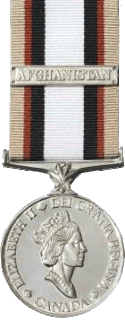
South-West Asia Service Medal (SWASM)
The South-West Asia Service Medal recognizes service with or in direct support of operations against terrorism in South-West Asia.
The South-West Asia Service Medal is awarded for a minimum of 90 days cumulative service in direct support of operations against terrorism in South West Asia from 11 September 2001 to 31 July 2009. Direct support occurs when a member is deployed to a unit or organization outside Canada but not into a specific theatre of operations, and where his or her primary duty is to provide direct assistance on a full-time basis to the operations against terrorism in South-West Asia.
The medal with AFGHANISTAN bar is awarded for 30 days cumulative service between 11 September 2001 and 31 Jul 2009 in the theatre of operations, which is a subset of the United States Central Command Area of Operation Responsibility (USCENTCOM AOR). The theatre of operations is defined as the land, sea, or air spaces of Afghanistan, Bahrain, Kuwait, Qatar, the United Arab Emirates, the Persian Gulf, Gulf of Oman, Arabian Sea, Gulf of Aden, Red Sea, Suez Canal and those parts of the Indian Ocean north of 5° South Latitude and west of 68° East Longitude.
CAF exchange personnel posted to foreign units or organizations in direct support of operations as described above are eligible for this medal.
The only civilians eligible are Members of the Public Service working for the CAF, Canadian civilians under contract with the CAF and Canadian Police Officers serving under the authority of the CAF in the locations and with the units described at the link above and between the dates indicated. Foreign civilians are not eligible for the SWASM.
The only members of allied forces eligible are those who serve in approved locations on behalf of Canada. They are usually foreign exchange personnel who deploy with our units or personnel seconded to the CAF specifically to serve in our mission. In all cases, they must be on the CFTPO filling a Canadian position and they are usually assigned a CAF service number. Foreign personnel working in concert with the CAF or reporting to a Canadian superior in an international context are not eligible for Canadian service medals.
All service under the NATO-led International Security Assistance Force (ISAF) is not eligible for the SWASM but qualifies for the SOUTH-WEST ASIA ribbon to either the General Campaign Star or General Service Medal.
Aircrew flying into the theatre accumulate one day of service for the first sortie flown on any day, additional sorties flown on the same day receive no further credit.
The first and last days in theatre count as full days.
Visits and inspections do not constitute qualifying service. Specifically, visits for the purpose of leadership, familiarization, ceremonial, or morale by civilian or military VIPs as well as Staff Assistance Visits (SAVs), Staff Inspection Visits (SIVs), and specialist visits for the conduct of summary/criminal/administrative investigations, courts martial, Boards of Inquiry, trial evaluations, academic studies, surveys or other similar administrative activities are excluded from qualification.
Any person who dies or is evacuated because of injuries or medical reasons directly attributable to service is deemed to have satisfied the time criteria set out above. Any recipient of the Medal with Afghanistan Bar who dies or is evacuated because of injuries or medical reasons directly attributable to service shall be credited the entire period the person would have served in theatre should the person have completed their tour of duty for the purpose of calculating eligibility for Rotation Bars.The South-West Asia Service Medal is a circular medal, silver in colour, 36 mm across, displaying:
on the obverse: The effigy of Her Majesty the Queen of Canada, wearing the King George IV State Diadem, facing right, circumscribed with the legend: “ELIZABETH II DEI GRATIA REGINA” and at the base of the effigy the word “CANADA” flanked by two small maple leaves; and
on the reverse: A representation of the mythical figure of Hydra, a many-headed serpent of Greek mythology described as a multifarious evil not to be overcome by a single effort, symbolising international terrorism. Each head is different, symbolising the idea that evil is found in every part of the world and that its face is constantly changing. The Hydra is transfixed by a Canadian sword and over the design is the Latin phrase, “ADVERSUS MALUM PUGNAMUS” - “We are fighting evil”.
A claw at the top of the medal, in the form of a cluster of olive leaves representing peace, is attached to a straight, slotted bar.
The ribbon is 32 mm in width with a white stripe in the middle (12 mm), on either side of which are stripes of black (4 mm), red (2 mm) and sand (4 mm). The black represents the shock of 11 September 2001 for the world and the mourning of the victims of the terror attacks. The sand colour represents the challenges of the theatre of operations, the white is for peace which is the ultimate aim of this operation. The red is for the blood that has been spilled on 11 September 2001 and in the ensuing campaign in the service of peace. Red and white are also the official colours of Canada as appointed by King George V in 1921.
The AFGHANISTAN bar to the medal is silver in colour with raised edges and bears the inscription “AFGHANISTAN”.
The rotation bars for the Medal are silver in colour with a raised edge and bear either one or five maple leaves.
Bombardier Goran Kurtagich
Bombardier T Spruston
The South-West Asia Service Medal recognizes service with or in direct support of operations against terrorism in South-West Asia.
The South-West Asia Service Medal is awarded for a minimum of 90 days cumulative service in direct support of operations against terrorism in South West Asia from 11 September 2001 to 31 July 2009. Direct support occurs when a member is deployed to a unit or organization outside Canada but not into a specific theatre of operations, and where his or her primary duty is to provide direct assistance on a full-time basis to the operations against terrorism in South-West Asia.
The medal with AFGHANISTAN bar is awarded for 30 days cumulative service between 11 September 2001 and 31 Jul 2009 in the theatre of operations, which is a subset of the United States Central Command Area of Operation Responsibility (USCENTCOM AOR). The theatre of operations is defined as the land, sea, or air spaces of Afghanistan, Bahrain, Kuwait, Qatar, the United Arab Emirates, the Persian Gulf, Gulf of Oman, Arabian Sea, Gulf of Aden, Red Sea, Suez Canal and those parts of the Indian Ocean north of 5° South Latitude and west of 68° East Longitude.
CAF exchange personnel posted to foreign units or organizations in direct support of operations as described above are eligible for this medal.
The only civilians eligible are Members of the Public Service working for the CAF, Canadian civilians under contract with the CAF and Canadian Police Officers serving under the authority of the CAF in the locations and with the units described at the link above and between the dates indicated. Foreign civilians are not eligible for the SWASM.
The only members of allied forces eligible are those who serve in approved locations on behalf of Canada. They are usually foreign exchange personnel who deploy with our units or personnel seconded to the CAF specifically to serve in our mission. In all cases, they must be on the CFTPO filling a Canadian position and they are usually assigned a CAF service number. Foreign personnel working in concert with the CAF or reporting to a Canadian superior in an international context are not eligible for Canadian service medals.
All service under the NATO-led International Security Assistance Force (ISAF) is not eligible for the SWASM but qualifies for the SOUTH-WEST ASIA ribbon to either the General Campaign Star or General Service Medal.
Aircrew flying into the theatre accumulate one day of service for the first sortie flown on any day, additional sorties flown on the same day receive no further credit.
The first and last days in theatre count as full days.
Visits and inspections do not constitute qualifying service. Specifically, visits for the purpose of leadership, familiarization, ceremonial, or morale by civilian or military VIPs as well as Staff Assistance Visits (SAVs), Staff Inspection Visits (SIVs), and specialist visits for the conduct of summary/criminal/administrative investigations, courts martial, Boards of Inquiry, trial evaluations, academic studies, surveys or other similar administrative activities are excluded from qualification.
Any person who dies or is evacuated because of injuries or medical reasons directly attributable to service is deemed to have satisfied the time criteria set out above. Any recipient of the Medal with Afghanistan Bar who dies or is evacuated because of injuries or medical reasons directly attributable to service shall be credited the entire period the person would have served in theatre should the person have completed their tour of duty for the purpose of calculating eligibility for Rotation Bars.The South-West Asia Service Medal is a circular medal, silver in colour, 36 mm across, displaying:
on the obverse: The effigy of Her Majesty the Queen of Canada, wearing the King George IV State Diadem, facing right, circumscribed with the legend: “ELIZABETH II DEI GRATIA REGINA” and at the base of the effigy the word “CANADA” flanked by two small maple leaves; and
on the reverse: A representation of the mythical figure of Hydra, a many-headed serpent of Greek mythology described as a multifarious evil not to be overcome by a single effort, symbolising international terrorism. Each head is different, symbolising the idea that evil is found in every part of the world and that its face is constantly changing. The Hydra is transfixed by a Canadian sword and over the design is the Latin phrase, “ADVERSUS MALUM PUGNAMUS” - “We are fighting evil”.
A claw at the top of the medal, in the form of a cluster of olive leaves representing peace, is attached to a straight, slotted bar.
The ribbon is 32 mm in width with a white stripe in the middle (12 mm), on either side of which are stripes of black (4 mm), red (2 mm) and sand (4 mm). The black represents the shock of 11 September 2001 for the world and the mourning of the victims of the terror attacks. The sand colour represents the challenges of the theatre of operations, the white is for peace which is the ultimate aim of this operation. The red is for the blood that has been spilled on 11 September 2001 and in the ensuing campaign in the service of peace. Red and white are also the official colours of Canada as appointed by King George V in 1921.
The AFGHANISTAN bar to the medal is silver in colour with raised edges and bears the inscription “AFGHANISTAN”.
The rotation bars for the Medal are silver in colour with a raised edge and bear either one or five maple leaves.
Bombardier Goran Kurtagich
Bombardier T Spruston
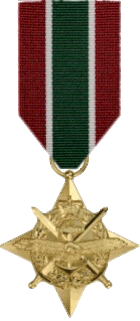
General Campaign Star – SOUTH-WEST ASIA (GCS-SWA)
This general service award has been created as a means to recognize - in a timelier manner - those who serve in operations in the presence of an armed enemy. Rather than creating a new honour for each new Canadian Forces operation as it arises, the General Campaign Star and General Service Medal - with their theatre or service specific ribbons - can be awarded in future to honour participation in any operation that meets the criteria.
The General Campaign Star (GCS) is awarded to members of the Canadian Forces and members of allied forces working with the Canadian Forces who deploy into a defined theatre of operations to take part in operations in the presence of an armed enemy. The GCS is always issued with a ribbon specific to the theatre or type of service being recognized, and each ribbon has its own criteria.
The GCS with South-West Asia ribbon is awarded to Canadian Forces members and members of allied forces working with the Canadian Forces who served either with the Canadian contribution to the International Security Assistance Force (ISAF) in Afghanistan for at least 30 days cumulative between 24 April 2003 and 31 July 2009, in the theatre of operations which consisted of the political boundaries and airspace of Afghanistan; and/or in the theatre of operations consisting of the political boundaries of Afghanistan, the Persian Gulf, the Gulf of Oman, the Gulf of Aden, the Red Sea, the Suez Canal and those parts of the Indian Ocean and the Arabian Sea that are west of sixty-eight degrees East longitude and north of five degrees South latitude, as well as the airspace above those areas for at least 30 cumulative days commencing on August 1, 2009, provided that the service has not been recognized by another service medal.
Aircrew flying into the theatre accumulate one day of service for the first sortie flown on any day, additional sorties flown on the same day receive no further credit. The Star and Rotation Bars shall be awarded for honourable service.
The GCS is a gold-coloured four-pointed star, 44 mm across, representing the cardinal points of a compass bearing on the obverse, built-up in order from the back: a wreath of maple leaves terminating at the top with the Royal Crown, two crossed swords, the blades and hilts forming four additional points to the star, an anchor and a flying eagle. The wreath represents honour, the maple leaves represent Canada, the anchor, crossed swords and eagle represent the three services of the Canadian Forces and the Crown represents the Queen of Canada and her role as the fount of all honours. On the reverse appear within a raised circle, from top to bottom: the Royal Cypher ensigned by the Royal Crown, a plain space for engraving, and three maple leaves on one stem. The ribbon passes through a ring attached to a small ball at the top point of the star. The ribbon is 32 mm wide with a central stripe of green (12 mm), on either side of which are stripes of white (2 mm) and red (8 mm). Red and white are the official colours of Canada as appointed by King George V in 1921 and green represents service.
The rotations bars for the Star are gold in colour with a raised edge and bear either one or five maples leaves.
http://www.cmp-cpm.forces.gc.ca/dhr-ddhr/chc-tdh/chart-tableau-eng.asp?ref=GCS
This general service award has been created as a means to recognize - in a timelier manner - those who serve in operations in the presence of an armed enemy. Rather than creating a new honour for each new Canadian Forces operation as it arises, the General Campaign Star and General Service Medal - with their theatre or service specific ribbons - can be awarded in future to honour participation in any operation that meets the criteria.
The General Campaign Star (GCS) is awarded to members of the Canadian Forces and members of allied forces working with the Canadian Forces who deploy into a defined theatre of operations to take part in operations in the presence of an armed enemy. The GCS is always issued with a ribbon specific to the theatre or type of service being recognized, and each ribbon has its own criteria.
The GCS with South-West Asia ribbon is awarded to Canadian Forces members and members of allied forces working with the Canadian Forces who served either with the Canadian contribution to the International Security Assistance Force (ISAF) in Afghanistan for at least 30 days cumulative between 24 April 2003 and 31 July 2009, in the theatre of operations which consisted of the political boundaries and airspace of Afghanistan; and/or in the theatre of operations consisting of the political boundaries of Afghanistan, the Persian Gulf, the Gulf of Oman, the Gulf of Aden, the Red Sea, the Suez Canal and those parts of the Indian Ocean and the Arabian Sea that are west of sixty-eight degrees East longitude and north of five degrees South latitude, as well as the airspace above those areas for at least 30 cumulative days commencing on August 1, 2009, provided that the service has not been recognized by another service medal.
Aircrew flying into the theatre accumulate one day of service for the first sortie flown on any day, additional sorties flown on the same day receive no further credit. The Star and Rotation Bars shall be awarded for honourable service.
The GCS is a gold-coloured four-pointed star, 44 mm across, representing the cardinal points of a compass bearing on the obverse, built-up in order from the back: a wreath of maple leaves terminating at the top with the Royal Crown, two crossed swords, the blades and hilts forming four additional points to the star, an anchor and a flying eagle. The wreath represents honour, the maple leaves represent Canada, the anchor, crossed swords and eagle represent the three services of the Canadian Forces and the Crown represents the Queen of Canada and her role as the fount of all honours. On the reverse appear within a raised circle, from top to bottom: the Royal Cypher ensigned by the Royal Crown, a plain space for engraving, and three maple leaves on one stem. The ribbon passes through a ring attached to a small ball at the top point of the star. The ribbon is 32 mm wide with a central stripe of green (12 mm), on either side of which are stripes of white (2 mm) and red (8 mm). Red and white are the official colours of Canada as appointed by King George V in 1921 and green represents service.
The rotations bars for the Star are gold in colour with a raised edge and bear either one or five maples leaves.
http://www.cmp-cpm.forces.gc.ca/dhr-ddhr/chc-tdh/chart-tableau-eng.asp?ref=GCS
2013 Major Ian Watt
Captain Don Lamb
Captain Brent Purcell
2013 Captain Rob Wishnicki
Captain T Yoo
Warrant Officer Rob Tennant
Sergeant Adam Coleman
Master Bombardier C Godsoe
Bombardier Y Bolgak
Bombardier M Coles
Bombardier A Dyke
Bombardier J Farquhar
Corporal G Fletcher
Bombardier R Hill
Bombardier I Ho
Bombardier K Hodgson
Bombardier K Keene
Bombardier B Lippert
Bombardier D Pare
Bombardier C Parker (Weller)
Bombardier R Pryce
Bombardier J Rosario
Bombardier Dan Scott
Bombardier D Sylka
Corporal M Wong
Looking for the deployment year. [email protected]
Captain Don Lamb
Captain Brent Purcell
2013 Captain Rob Wishnicki
Captain T Yoo
Warrant Officer Rob Tennant
Sergeant Adam Coleman
Master Bombardier C Godsoe
Bombardier Y Bolgak
Bombardier M Coles
Bombardier A Dyke
Bombardier J Farquhar
Corporal G Fletcher
Bombardier R Hill
Bombardier I Ho
Bombardier K Hodgson
Bombardier K Keene
Bombardier B Lippert
Bombardier D Pare
Bombardier C Parker (Weller)
Bombardier R Pryce
Bombardier J Rosario
Bombardier Dan Scott
Bombardier D Sylka
Corporal M Wong
Looking for the deployment year. [email protected]

Special Service Medal (SSM)
The Special Service Medal was created to recognize members of the Canadian Forces who are taking part in activities and operations under exceptional circumstances.
The Special Service Medal recognizes members of the Canadian Forces (CF) who have performed a service determined to be under exceptional circumstances, in a clearly defined locality for a specified duration. The SSM recognizes approved activities underway on 11 June 1984 or subsequently established. This medals is always issued with a bar that specifies the special service being recognized, each bar having its own criteria.
The Medal shall be circular in form, of copper and zinc alloy, 36 mm in diameter, bearing:
on the obverse, a maple leaf surrounded by a laurel wreath;
on the reverse the inscription "SPECIAL SERVICE SPÉCIAL" ensigned with the Royal Crown and Cypher.
A single-toe claw attached to the top of the medal and to the centre of a straight, slotted bar.
The ribbon is 32 mm wide with a dark green centre (12 mm) flanked with white stripes (5mm) and edged with red (5 mm). The dark green is similar to the "unification green" of the uniform worn when the medal was approved in 1984, red and white are the official colours of Canada as appointed by King George V in 1921.
The bars are silver in colour with a raised edge and bear the title of the bar on a pebbled background.
NATO Bar - Awarded for an aggregate of 180 days of honourable service within the North Atlantic Treaty Organization's (NATO) area of responsibility between 1 January 1951 and 19 October 2004.
http://www.cmp-cpm.forces.gc.ca/dhr-ddhr/chc-tdh/index-eng.asp
Captain Noel RR Dykes, CD (NATO) Awarded in 1994
Captain Steve Watkins
Derrick Mann
Heath Porritt
George Dempsey (NATO)
PG Dolomont
Bombardier Mark Jackson (NATO)
The Special Service Medal was created to recognize members of the Canadian Forces who are taking part in activities and operations under exceptional circumstances.
The Special Service Medal recognizes members of the Canadian Forces (CF) who have performed a service determined to be under exceptional circumstances, in a clearly defined locality for a specified duration. The SSM recognizes approved activities underway on 11 June 1984 or subsequently established. This medals is always issued with a bar that specifies the special service being recognized, each bar having its own criteria.
The Medal shall be circular in form, of copper and zinc alloy, 36 mm in diameter, bearing:
on the obverse, a maple leaf surrounded by a laurel wreath;
on the reverse the inscription "SPECIAL SERVICE SPÉCIAL" ensigned with the Royal Crown and Cypher.
A single-toe claw attached to the top of the medal and to the centre of a straight, slotted bar.
The ribbon is 32 mm wide with a dark green centre (12 mm) flanked with white stripes (5mm) and edged with red (5 mm). The dark green is similar to the "unification green" of the uniform worn when the medal was approved in 1984, red and white are the official colours of Canada as appointed by King George V in 1921.
The bars are silver in colour with a raised edge and bear the title of the bar on a pebbled background.
NATO Bar - Awarded for an aggregate of 180 days of honourable service within the North Atlantic Treaty Organization's (NATO) area of responsibility between 1 January 1951 and 19 October 2004.
http://www.cmp-cpm.forces.gc.ca/dhr-ddhr/chc-tdh/index-eng.asp
Captain Noel RR Dykes, CD (NATO) Awarded in 1994
Captain Steve Watkins
Derrick Mann
Heath Porritt
George Dempsey (NATO)
PG Dolomont
Bombardier Mark Jackson (NATO)
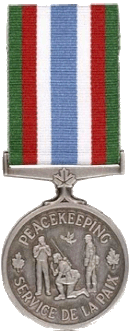
Canadian Peacekeeping Service Medal (CPSM)
The prestigious Nobel Peace Prize was awarded to all United Nations Peacekeepers in 1988 in recognition of their collective efforts in the cause of peace. This inspired the creation of the Canadian Peacekeeping Service Medal to acknowledge the unique contribution to peace that Canadian peacekeepers have made since 1947.
Awarded for a minimum of 30 days cumulative service in a UN or international peacekeeping mission.
The medal is a circular medal, 36 mm diameter. In the centre of the obverse is three figures of unarmed observer. Above them flies a dove. The words “PEACEKEEPING” and “SERVICE DE LA PAIX” are written around the three figures separated by two maple leafs on either side. In the centre of the reverse is the Queen’s Cypher on a maple leaf, surrounded by two sprigs of laurel and the word “CANADA”.
A single-toe claw attaches to the top of the medal and to the centre of a straight, slotted bar. There is a maple leaf centred on the slotted bar. The ribbon is 32 mm wide and consists of a central stripe of United Nations blue on each side of which are stripes of white, red and green. The blue in the official colour of the United Nations, organisation under which authority most of the peacekeeping missions are conducted, the green represents service, the white is the colour of peace, the red represents the blood shed in the service of peace. Red and white are also the official colours of Canada as appointed by King George V in 1921.
There is no bar to this medal. The use of a post-nominal is not authorized for this medal.
Almost 125,000 Canadian personnel have served in peacekeeping missions over the past 53 years. This record is unsurpassed by any nation. This tradition in the “service of peace” continues today.
http://www.cmp-cpm.forces.gc.ca/dhr-ddhr/chc-tdh/index-eng.asp
The prestigious Nobel Peace Prize was awarded to all United Nations Peacekeepers in 1988 in recognition of their collective efforts in the cause of peace. This inspired the creation of the Canadian Peacekeeping Service Medal to acknowledge the unique contribution to peace that Canadian peacekeepers have made since 1947.
Awarded for a minimum of 30 days cumulative service in a UN or international peacekeeping mission.
The medal is a circular medal, 36 mm diameter. In the centre of the obverse is three figures of unarmed observer. Above them flies a dove. The words “PEACEKEEPING” and “SERVICE DE LA PAIX” are written around the three figures separated by two maple leafs on either side. In the centre of the reverse is the Queen’s Cypher on a maple leaf, surrounded by two sprigs of laurel and the word “CANADA”.
A single-toe claw attaches to the top of the medal and to the centre of a straight, slotted bar. There is a maple leaf centred on the slotted bar. The ribbon is 32 mm wide and consists of a central stripe of United Nations blue on each side of which are stripes of white, red and green. The blue in the official colour of the United Nations, organisation under which authority most of the peacekeeping missions are conducted, the green represents service, the white is the colour of peace, the red represents the blood shed in the service of peace. Red and white are also the official colours of Canada as appointed by King George V in 1921.
There is no bar to this medal. The use of a post-nominal is not authorized for this medal.
Almost 125,000 Canadian personnel have served in peacekeeping missions over the past 53 years. This record is unsurpassed by any nation. This tradition in the “service of peace” continues today.
http://www.cmp-cpm.forces.gc.ca/dhr-ddhr/chc-tdh/index-eng.asp
Bombardier Lisa Abbott
Sergeant Drew Bartlett CD
Bombardier Craig Burridge
Sergeant Ken Chiu CD
Warrant Officer Chris Comars CD
Captain Jean Pierre Dorris CD
Captain Noel Robert Ryland Dykes, CD
Master Bombardier Darrell Erickson
Bombardier Richard Fowler
Sergeant Rob Garrett
Master Bombardier Anthonv Gee CD
Bombardier Shane Hall
Gunner Goran Kurtaqich
Bombardier Lani Jakimchuk
Corporal Paul Kim
Bombardier Ernie Kovacs
Lieutenant-Colonel Leon Jensen CD
Warrant Officer Don Labossiere CD
Lieutenant Don Lamb
Gunner Dolan Magrath
Bombardier William Martinez
Master Bombardier John Meszaros CD
Master Bombardier James Perkins
Petty Officer Second Class Dennis Pistun CD
Captain Brent Purcell CD
Bombardier Chris Schulz
Gunner Kendall Shaw
Lieutenant Elizabeth Skuce
Bombardier Tymothy Spruston
Master Bombardier Rick Tennant CD
Sergeant Dave Urquhart CD
Captain Richard Van Slyke MMM CD
Captain Kent Wickens CD
Warrant Officer Robert Wishnicki CD
Master Bombardier Oliver Younq CD
Sergeant Drew Bartlett CD
Bombardier Craig Burridge
Sergeant Ken Chiu CD
Warrant Officer Chris Comars CD
Captain Jean Pierre Dorris CD
Captain Noel Robert Ryland Dykes, CD
Master Bombardier Darrell Erickson
Bombardier Richard Fowler
Sergeant Rob Garrett
Master Bombardier Anthonv Gee CD
Bombardier Shane Hall
Gunner Goran Kurtaqich
Bombardier Lani Jakimchuk
Corporal Paul Kim
Bombardier Ernie Kovacs
Lieutenant-Colonel Leon Jensen CD
Warrant Officer Don Labossiere CD
Lieutenant Don Lamb
Gunner Dolan Magrath
Bombardier William Martinez
Master Bombardier John Meszaros CD
Master Bombardier James Perkins
Petty Officer Second Class Dennis Pistun CD
Captain Brent Purcell CD
Bombardier Chris Schulz
Gunner Kendall Shaw
Lieutenant Elizabeth Skuce
Bombardier Tymothy Spruston
Master Bombardier Rick Tennant CD
Sergeant Dave Urquhart CD
Captain Richard Van Slyke MMM CD
Captain Kent Wickens CD
Warrant Officer Robert Wishnicki CD
Master Bombardier Oliver Younq CD
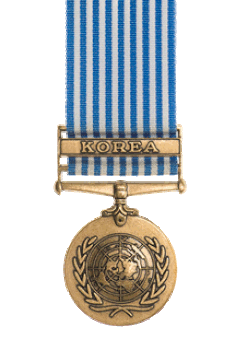
United Nations Service Medal Korea (UNK)
The United Nations Service Medal was instituted 12 December 1950 for service from 27 June 1950 to 27 July 1954 and was earned for serving one day under United Nations' command in Korea or adjacent areas, including Japan and Okinawa.
The medal could also be awarded for an aggregate of thirty days, which need not have been consecutive, spent on official visits of inspection to the qualifying area. The qualifying period was 27 June 1950 to 27 July 1954 (One year longer then in the case for the Canadian Medal for Korea).
A circular medal, 1.375 inches across, made of bronze alloy. For mounting, a single-toed scroll claw is attached to a plain, straight suspender. The obverse has the emblem of the United Nations, which is the globe of the earth viewed from above the North Pole within a wreath of two olive branches.
The reverse has the inscription in 5 lines: FOR SERVICE IN / DEFENCE OF THE / PRINCIPLES OF THE / CHARTER OF THE / UNITED NATIONS, or in 4 lines: POUR LA DEFENSE / DES PRINCIPES DE / LA CHARTE DES / NATIONS UNIES.
The ribbon is 1.375 inches wide, and consists of 17 alternating stripes of blue and white, with blue on each edge.
A permanent bar is attached to the mount with the word KOREA or COREE on it.
The recipient's name is engraved on the rim with the regimental number.
Captain Faustine Stanley Card
Gordon Leslie Croucher
Major Andrew Foulds
Bombardier Jack Fraser Riddle
Captain Angus MacDougall Tierney
The United Nations Service Medal was instituted 12 December 1950 for service from 27 June 1950 to 27 July 1954 and was earned for serving one day under United Nations' command in Korea or adjacent areas, including Japan and Okinawa.
The medal could also be awarded for an aggregate of thirty days, which need not have been consecutive, spent on official visits of inspection to the qualifying area. The qualifying period was 27 June 1950 to 27 July 1954 (One year longer then in the case for the Canadian Medal for Korea).
A circular medal, 1.375 inches across, made of bronze alloy. For mounting, a single-toed scroll claw is attached to a plain, straight suspender. The obverse has the emblem of the United Nations, which is the globe of the earth viewed from above the North Pole within a wreath of two olive branches.
The reverse has the inscription in 5 lines: FOR SERVICE IN / DEFENCE OF THE / PRINCIPLES OF THE / CHARTER OF THE / UNITED NATIONS, or in 4 lines: POUR LA DEFENSE / DES PRINCIPES DE / LA CHARTE DES / NATIONS UNIES.
The ribbon is 1.375 inches wide, and consists of 17 alternating stripes of blue and white, with blue on each edge.
A permanent bar is attached to the mount with the word KOREA or COREE on it.
The recipient's name is engraved on the rim with the regimental number.
Captain Faustine Stanley Card
Gordon Leslie Croucher
Major Andrew Foulds
Bombardier Jack Fraser Riddle
Captain Angus MacDougall Tierney
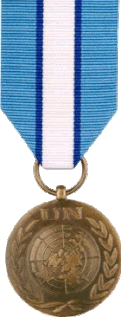
UN Forces in Cyprus (UNFICYP)
In the interest of international peace and security, the Mission was established in March 1964 to use its best efforts to prevent the recurrence of fighting between the Greek Cypriots and Turkish Cypriots and, as necessary, to contribute to the maintenance and restoration of law and order and a return to normal conditions. Since the hostilities of 1974, the mandate has included supervising the cease-fire and maintaining a buffer zone between the lines of the Cyprus National Guard and of the Turkish and Turkish Cypriot forces.
Awarded for 30 days service between 27 March 1964 and 27 March 1965. However, after 27 March 1965, 90 days consecutive service is required.
A circular bronze alloy medal, 1.4 inches (35mm) in diameter. On the obverse, the representation of the UN symbol surmounted by the straight letters UN, both in bas-relief. On the reverse, an inscription bearing the words, "IN THE SERVICE OF PEACE" in English (and only in English). A 0.5 inch (12mm) bronze ring, which holds the ribbon, passes through a small hollow ball at the top of a claw joined to the top of the medal. The ribbon has three equal bars, one of white in the centre and two of UN blue at either end. The bars are separated by two narrow bands of dark blue symbolizing the Mediterranean Sea.
The use of a post-nominal is not authorized for this medal.
http://www.cmp-cpm.forces.gc.ca/dhr-ddhr/chc-tdh/index-eng.asp
In the interest of international peace and security, the Mission was established in March 1964 to use its best efforts to prevent the recurrence of fighting between the Greek Cypriots and Turkish Cypriots and, as necessary, to contribute to the maintenance and restoration of law and order and a return to normal conditions. Since the hostilities of 1974, the mandate has included supervising the cease-fire and maintaining a buffer zone between the lines of the Cyprus National Guard and of the Turkish and Turkish Cypriot forces.
Awarded for 30 days service between 27 March 1964 and 27 March 1965. However, after 27 March 1965, 90 days consecutive service is required.
A circular bronze alloy medal, 1.4 inches (35mm) in diameter. On the obverse, the representation of the UN symbol surmounted by the straight letters UN, both in bas-relief. On the reverse, an inscription bearing the words, "IN THE SERVICE OF PEACE" in English (and only in English). A 0.5 inch (12mm) bronze ring, which holds the ribbon, passes through a small hollow ball at the top of a claw joined to the top of the medal. The ribbon has three equal bars, one of white in the centre and two of UN blue at either end. The bars are separated by two narrow bands of dark blue symbolizing the Mediterranean Sea.
The use of a post-nominal is not authorized for this medal.
http://www.cmp-cpm.forces.gc.ca/dhr-ddhr/chc-tdh/index-eng.asp
1985 Warrant Officer Don Labossiere
1988/89 Corporal Ken W Francis
1989/90 Private Grayham C Partridge
1992 Warrant Officer Chris Comars
1993 Lieutenant Brent Purcell
1993 Lieutenant Kent A Wickens
1993 Master Bombardier Robert G Wishnicki
1993 Bombardier Lisa Abbott
1993 Bombardier Ken Chui
1993 Bombardier Anthony Gee
1993 Bombardier Shane Hall
1993 Bombardier Dolan Magrath
1993 Bombardier Randy Phillips
1993 Bombardier Rick Tennant
1993 Bombardier Oliver Young
1993 Bombardier Dave Urquhart
1988/89 Corporal Ken W Francis
1989/90 Private Grayham C Partridge
1992 Warrant Officer Chris Comars
1993 Lieutenant Brent Purcell
1993 Lieutenant Kent A Wickens
1993 Master Bombardier Robert G Wishnicki
1993 Bombardier Lisa Abbott
1993 Bombardier Ken Chui
1993 Bombardier Anthony Gee
1993 Bombardier Shane Hall
1993 Bombardier Dolan Magrath
1993 Bombardier Randy Phillips
1993 Bombardier Rick Tennant
1993 Bombardier Oliver Young
1993 Bombardier Dave Urquhart

UN Emergency Force Middle East II (UNEFME II)
Established in October 1973 to supervise the cease-fire between Egyptian and Israeli forces and, following the conclusion of the agreements of 18 January 1974 and 4 September 1975, to supervise the redeployment of Egyptian and Israeli forces and to control the buffer zones established under those agreements. The mandate for this Mission expired in July 1979 and the troops were withdrawn.
Awarded for 90 days consecutive service between 26 October 1973 to 24 July 1979.
A circular bronze alloy medal, 1.4 inches (35mm) in diameter. On the obverse, the representation of the UN symbol surmounted by the straight letters UN, both in bas-relief. On the reverse, an inscription bearing the words, "IN THE SERVICE OF PEACE" in English (and only in English). A 0.5 inch (12mm) bronze ring, which holds the ribbon, passes through a small hollow ball at the top of a claw joined to the top of the medal.
The ribbon bears a wide central band of a sand or buff colour symbolizing the Sinai Desert with two narrow dark blue lines through the middle, representing the Suez Canal. Two wide bars of UN blue appear at either end.
Each subsequent Tour of duty in UNEFME II is recognized by the issuing of a representative silver numeral (i.e. '2' for a second Tour, '3' for a third Tour etc) which is worn centered on the ribbon. The use of a post-nominal is not authorized for this medal.
http://www.cmp-cpm.forces.gc.ca/dhr-ddhr/chc-tdh/index-eng.asp
1973/74 Gunner Gary Palmatory
1973/74 Gunner Brian Harmon
1976/77 Gunner Noel RR Dykes
1976/77 Gunner Joseph C. Gauthier
1976/77 Gunner Ernie Kovacs
1977/78 Corporal Joe Phelan
1978 Bombardier Dale Arthur Bliss
1978/79 Gunner Richard G. Fowler
1978/79 Gunner Terry Harmon
1978/79 Gunner Mike Hennessy
1978/79 Bombardier Noel RR Dykes
1978/79 Gunner Joseph C. Gauthier
1978/79 Corporal? Dennis Pistun
Established in October 1973 to supervise the cease-fire between Egyptian and Israeli forces and, following the conclusion of the agreements of 18 January 1974 and 4 September 1975, to supervise the redeployment of Egyptian and Israeli forces and to control the buffer zones established under those agreements. The mandate for this Mission expired in July 1979 and the troops were withdrawn.
Awarded for 90 days consecutive service between 26 October 1973 to 24 July 1979.
A circular bronze alloy medal, 1.4 inches (35mm) in diameter. On the obverse, the representation of the UN symbol surmounted by the straight letters UN, both in bas-relief. On the reverse, an inscription bearing the words, "IN THE SERVICE OF PEACE" in English (and only in English). A 0.5 inch (12mm) bronze ring, which holds the ribbon, passes through a small hollow ball at the top of a claw joined to the top of the medal.
The ribbon bears a wide central band of a sand or buff colour symbolizing the Sinai Desert with two narrow dark blue lines through the middle, representing the Suez Canal. Two wide bars of UN blue appear at either end.
Each subsequent Tour of duty in UNEFME II is recognized by the issuing of a representative silver numeral (i.e. '2' for a second Tour, '3' for a third Tour etc) which is worn centered on the ribbon. The use of a post-nominal is not authorized for this medal.
http://www.cmp-cpm.forces.gc.ca/dhr-ddhr/chc-tdh/index-eng.asp
1973/74 Gunner Gary Palmatory
1973/74 Gunner Brian Harmon
1976/77 Gunner Noel RR Dykes
1976/77 Gunner Joseph C. Gauthier
1976/77 Gunner Ernie Kovacs
1977/78 Corporal Joe Phelan
1978 Bombardier Dale Arthur Bliss
1978/79 Gunner Richard G. Fowler
1978/79 Gunner Terry Harmon
1978/79 Gunner Mike Hennessy
1978/79 Bombardier Noel RR Dykes
1978/79 Gunner Joseph C. Gauthier
1978/79 Corporal? Dennis Pistun

UN Disengagement Observation Force (UNDOF)
Established in June 1974 to supervise the cease-fire between Israel and Syria; to supervise the disengagement (redeployment) of Syrian and Israeli forces; and, to establish a buffer zone, as provided in the Agreement on Disengagement between Israeli and Syrian Forces of 31 May 1974. The Mission continues to perform its functions effectively with the cooperation of the parties.
Awarded for 90 days consecutive service between 1 June 1974 to the present.
A circular bronze alloy medal, 1.4 inches (35mm) in diameter. On the obverse, the representation of the UN symbol surmounted by the straight letters UN, both in bas-relief. On the reverse, an inscription bearing the words, "IN THE SERVICE OF PEACE" in English (and only in English). A 0.5 inch (12mm) bronze ring, which holds the ribbon, passes through a small hollow ball at the top of a claw joined to the top of the medal.
The ribbon contains a central stripe of UN blue with a red line down the middle representing the UN patrolled Area of Separation; two narrow stripes of black, representing the volcanic rock of the Golan region appear on either side with two narrow bands of white, symbolic of the snow on Mt. Hermon, outside these. At either end are wide bands of burgundy, symbolizing the purple haze at sunset and the native thistles of the Golan.
Each subsequent Tour of duty in UNDOF is recognized by the issuing of a representative silver numeral (i.e. '2' for a second Tour, '3' for a third Tour etc) which is worn centered on the ribbon.
http://www.cmp-cpm.forces.gc.ca/dhr-ddhr/chc-tdh/index-eng.asp
1978 Bombardier Graeme Mutton
1979 Gunner Joseph C Gauthier
1981/82 Gunner Steve Darragh
Established in June 1974 to supervise the cease-fire between Israel and Syria; to supervise the disengagement (redeployment) of Syrian and Israeli forces; and, to establish a buffer zone, as provided in the Agreement on Disengagement between Israeli and Syrian Forces of 31 May 1974. The Mission continues to perform its functions effectively with the cooperation of the parties.
Awarded for 90 days consecutive service between 1 June 1974 to the present.
A circular bronze alloy medal, 1.4 inches (35mm) in diameter. On the obverse, the representation of the UN symbol surmounted by the straight letters UN, both in bas-relief. On the reverse, an inscription bearing the words, "IN THE SERVICE OF PEACE" in English (and only in English). A 0.5 inch (12mm) bronze ring, which holds the ribbon, passes through a small hollow ball at the top of a claw joined to the top of the medal.
The ribbon contains a central stripe of UN blue with a red line down the middle representing the UN patrolled Area of Separation; two narrow stripes of black, representing the volcanic rock of the Golan region appear on either side with two narrow bands of white, symbolic of the snow on Mt. Hermon, outside these. At either end are wide bands of burgundy, symbolizing the purple haze at sunset and the native thistles of the Golan.
Each subsequent Tour of duty in UNDOF is recognized by the issuing of a representative silver numeral (i.e. '2' for a second Tour, '3' for a third Tour etc) which is worn centered on the ribbon.
http://www.cmp-cpm.forces.gc.ca/dhr-ddhr/chc-tdh/index-eng.asp
1978 Bombardier Graeme Mutton
1979 Gunner Joseph C Gauthier
1981/82 Gunner Steve Darragh
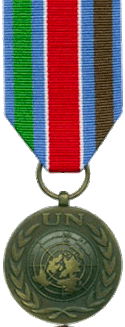
UN Protection Force (Yugoslavia) (UNPROFOR)
UNPROFOR was established in February 1992 as an interim arrangement to create the conditions of peace and security required for the negotiation of an overall settlement of the Yugoslavian crisis. The role of the UN troops was to ensure that areas designated as "UN Protected Areas" (UNPA) became and remained demilitarized and that all persons residing in these areas were protected from fear of armed attack. The role of UN police monitors was to ensure that local police forces carried out their duties without discriminating against persons of any nationality or abusing any human rights. The force also assisted the humanitarian agencies of the UN in the return of all displaced persons who so desired.There were several extensions of the original UNPROFOR covering the following purposes: reopening of the Sarajevo airport for humanitarian purposes; establishing a security zone encompassing Sarajevo and its airport; protection of convoys of released detainees in Bosnia and Herzegovina as requested by the International Committee of the Red Cross; monitoring arrangements for the complete withdrawal of the Yugoslavian Army from Croatia; the demilitarization of the Prevlaka peninsula and the removal of heavy weapons from neighbouring areas of Croatia and Montenegro (Res 779,1992); monitoring compliance with the ban on military flights (Res 781,1992); and the establishment of the United Nations presence in the former Yugoslav Republic of Macedonia.
Awarded for 90 days consecutive service from 01 March 1992
A circular bronze alloy medal, 1.4 inches (35mm) in diameter.On the obverse, the representation of the UN symbol surmounted by the straight letters UN, both in bas-relief.On the reverse, an inscription bearing the words, "IN THE SERVICE OF PEACE" in English (and only in English).A 0.5 inch (12mm) bronze ring, which holds the ribbon, passes through a small hollow ball at the top of a claw joined to the top of the medal.The ribbon consists of a background of UN blue, with a central wide band of red, representing the United Nations Protected Areas (UNPAs), flanked by thin stripes of the white. On the left side there is a narrow band of green, representing forests, and on the right side, a narrow band of brown, representing the mountains.
Each subsequent Tour of duty in UNPROFOR is recognized by the issuing of a representative bronze numeral (i.e. '2' for a second Tour, '3' for a third Tour etc) which is worn centered on the ribbon. The use of a post-nominal is not authorized for this medal.
http://www.cmp-cpm.forces.gc.ca/dhr-ddhr/chc-tdh/index-eng.asp
UNPROFOR was established in February 1992 as an interim arrangement to create the conditions of peace and security required for the negotiation of an overall settlement of the Yugoslavian crisis. The role of the UN troops was to ensure that areas designated as "UN Protected Areas" (UNPA) became and remained demilitarized and that all persons residing in these areas were protected from fear of armed attack. The role of UN police monitors was to ensure that local police forces carried out their duties without discriminating against persons of any nationality or abusing any human rights. The force also assisted the humanitarian agencies of the UN in the return of all displaced persons who so desired.There were several extensions of the original UNPROFOR covering the following purposes: reopening of the Sarajevo airport for humanitarian purposes; establishing a security zone encompassing Sarajevo and its airport; protection of convoys of released detainees in Bosnia and Herzegovina as requested by the International Committee of the Red Cross; monitoring arrangements for the complete withdrawal of the Yugoslavian Army from Croatia; the demilitarization of the Prevlaka peninsula and the removal of heavy weapons from neighbouring areas of Croatia and Montenegro (Res 779,1992); monitoring compliance with the ban on military flights (Res 781,1992); and the establishment of the United Nations presence in the former Yugoslav Republic of Macedonia.
Awarded for 90 days consecutive service from 01 March 1992
A circular bronze alloy medal, 1.4 inches (35mm) in diameter.On the obverse, the representation of the UN symbol surmounted by the straight letters UN, both in bas-relief.On the reverse, an inscription bearing the words, "IN THE SERVICE OF PEACE" in English (and only in English).A 0.5 inch (12mm) bronze ring, which holds the ribbon, passes through a small hollow ball at the top of a claw joined to the top of the medal.The ribbon consists of a background of UN blue, with a central wide band of red, representing the United Nations Protected Areas (UNPAs), flanked by thin stripes of the white. On the left side there is a narrow band of green, representing forests, and on the right side, a narrow band of brown, representing the mountains.
Each subsequent Tour of duty in UNPROFOR is recognized by the issuing of a representative bronze numeral (i.e. '2' for a second Tour, '3' for a third Tour etc) which is worn centered on the ribbon. The use of a post-nominal is not authorized for this medal.
http://www.cmp-cpm.forces.gc.ca/dhr-ddhr/chc-tdh/index-eng.asp
1992/93 Master Bombardier Drew W. Bartlett
1992/93 Bombardier John Meszaros
1993 Bombardier Rob F. Garrett
1993 Corporal Paul Kim
1993 Gunner William J. Rae
1993 Gunner Garnet R. Woodford
1994 Bombardier Quinn D. Gillard
1994 Gunner Tam T. Nguyen
1994 Captain Glen Hamilton-Brown
1995 Major Leon Jensen CD
1992/93 Bombardier John Meszaros
1993 Bombardier Rob F. Garrett
1993 Corporal Paul Kim
1993 Gunner William J. Rae
1993 Gunner Garnet R. Woodford
1994 Bombardier Quinn D. Gillard
1994 Gunner Tam T. Nguyen
1994 Captain Glen Hamilton-Brown
1995 Major Leon Jensen CD
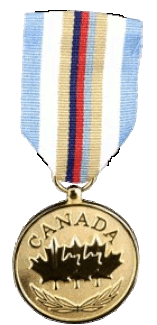
Somalia Medal (SOM)
The Somalia medal recognises the participation of CF members that have taken part in the coalition mission in Somalia to help stabilise the country from civil war, and to help deliver humanitarian aid.
A person enrolled in, attached to or working with the Canadian Forces may be awarded this medal if the person served a minimum of 90 cumulative days of honourable service in the theatre of operations during the period beginning on November 16, 1992 and ending on June 30,1993 provided that this service has not been recognized by another medal.
In the centre of the obverse appear three maple leaves, in fess and overlapping, above which is inscribed the word "CANADA" and below which appear two sprigs of laurel leaves; and
On the reverse appears the Royal Cypher surrounded by the inscription "SOMALIA SOMALIE 1992-93".
A 4 mm gold ring, which holds the ribbon, passes through smaller ring attached to the top of the medal.
The ribbon is 32 mm in width and United Nations blue in colour, with a central white stripe 22 mm in width on which are superimposed and centred five stripes, one each of, from left to right, sand, navy blue, scarlet, air force blue and sand, each stripe being 2.5 mm in width. The blue is the official colour of the United Nations, white is the colour of peace, the sand colour represents the theatre of operations while the dark blue, scarlet and light blue represent the navy, army and air force.
The Somalia medal recognises the participation of CF members that have taken part in the coalition mission in Somalia to help stabilise the country from civil war, and to help deliver humanitarian aid.
A person enrolled in, attached to or working with the Canadian Forces may be awarded this medal if the person served a minimum of 90 cumulative days of honourable service in the theatre of operations during the period beginning on November 16, 1992 and ending on June 30,1993 provided that this service has not been recognized by another medal.
In the centre of the obverse appear three maple leaves, in fess and overlapping, above which is inscribed the word "CANADA" and below which appear two sprigs of laurel leaves; and
On the reverse appears the Royal Cypher surrounded by the inscription "SOMALIA SOMALIE 1992-93".
A 4 mm gold ring, which holds the ribbon, passes through smaller ring attached to the top of the medal.
The ribbon is 32 mm in width and United Nations blue in colour, with a central white stripe 22 mm in width on which are superimposed and centred five stripes, one each of, from left to right, sand, navy blue, scarlet, air force blue and sand, each stripe being 2.5 mm in width. The blue is the official colour of the United Nations, white is the colour of peace, the sand colour represents the theatre of operations while the dark blue, scarlet and light blue represent the navy, army and air force.
1992 Warrant Officer Don Labossiere CD
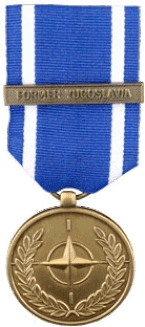
NATO Medal for Former Yugoslavia (NATO-FY)
On 14 December 1995 North Atlantic Council launched the largest military operation ever undertaken by the Alliance, Operation Joint Endeavour. Based on UN Security Council Resolution 1031, NATO was given the mandate to implement the military aspects of the Peace Agreement. A NATO-led multinational force, called the Implementation Force (IFOR), started its mission on 20 December 1995. IFOR was given a one-year mandate. After the peaceful conduct of the September 1996 elections, IFOR successfully completed its mission of implementing the military annexes of the General Framework Agreement for Peace. However, it was clear that much remained to be accomplished on the civil side and that the political environment would continue to be potentially unstable and insecure. On 25-26 September, one week after the Bosnian elections NATO Defence Ministers concluded that the Alliance needed to re-assess how it might continue to provide support for the establishment of a secure environment after the end of IFOR's mandate in December. The role of IFOR (Operation Joint Endeavour) was to implement the peace. The role of SFOR (Operation Joint Guard / Operation Joint Forge) is to stabilise the peace. The difference between the tasks of IFOR and SFOR is reflected in their names.
Awarded for thirty days continuous or accumulated service in direct support of NATO operations, on land, at sea or in the air spaces of the Former Yugoslavia, Albania, the Former Republic of Macedonia, and the Adriatic Sea (the theatre of operations) commencing 1 July 1992 and ending 31 December 2002; or ninety days continuous or accumulated service commencing 1 July 1992 and ending 31 December 2002, in the territories of Italy, Greece, Hungary and Austria, in direct support of the NATO operations in the Former Yugoslavia (the adjacent area).
The Medal is circular in form and made of bronze, and bearing, on the obverse, the NATO star set in a wreath of olive leaves; and on the reverse, the title "North Atlantic Treaty Organization" and the words "In the service of peace and freedom" in English and French. A large ring is attached to the top of the medal. The ribbon is dark blue the colour of NATO with, two white strips on either end representing peace. The tour numerals are Arabic script and made of bronze. The medal is always issued with a bar, inscribed "FORMER YUGOSLAVIA" or "EX-YOUGOSLAVIE".
http://www.cmp-cpm.forces.gc.ca/dhr-ddhr/chc-tdh/index-eng.asp
On 14 December 1995 North Atlantic Council launched the largest military operation ever undertaken by the Alliance, Operation Joint Endeavour. Based on UN Security Council Resolution 1031, NATO was given the mandate to implement the military aspects of the Peace Agreement. A NATO-led multinational force, called the Implementation Force (IFOR), started its mission on 20 December 1995. IFOR was given a one-year mandate. After the peaceful conduct of the September 1996 elections, IFOR successfully completed its mission of implementing the military annexes of the General Framework Agreement for Peace. However, it was clear that much remained to be accomplished on the civil side and that the political environment would continue to be potentially unstable and insecure. On 25-26 September, one week after the Bosnian elections NATO Defence Ministers concluded that the Alliance needed to re-assess how it might continue to provide support for the establishment of a secure environment after the end of IFOR's mandate in December. The role of IFOR (Operation Joint Endeavour) was to implement the peace. The role of SFOR (Operation Joint Guard / Operation Joint Forge) is to stabilise the peace. The difference between the tasks of IFOR and SFOR is reflected in their names.
Awarded for thirty days continuous or accumulated service in direct support of NATO operations, on land, at sea or in the air spaces of the Former Yugoslavia, Albania, the Former Republic of Macedonia, and the Adriatic Sea (the theatre of operations) commencing 1 July 1992 and ending 31 December 2002; or ninety days continuous or accumulated service commencing 1 July 1992 and ending 31 December 2002, in the territories of Italy, Greece, Hungary and Austria, in direct support of the NATO operations in the Former Yugoslavia (the adjacent area).
The Medal is circular in form and made of bronze, and bearing, on the obverse, the NATO star set in a wreath of olive leaves; and on the reverse, the title "North Atlantic Treaty Organization" and the words "In the service of peace and freedom" in English and French. A large ring is attached to the top of the medal. The ribbon is dark blue the colour of NATO with, two white strips on either end representing peace. The tour numerals are Arabic script and made of bronze. The medal is always issued with a bar, inscribed "FORMER YUGOSLAVIA" or "EX-YOUGOSLAVIE".
http://www.cmp-cpm.forces.gc.ca/dhr-ddhr/chc-tdh/index-eng.asp
1996 IFOR Major Leon Jensen CD
1996 SFOR Bombardier Darrell Erickson
1996 SFOR Bombardier James Perkins
1999/2000 SFOR Bombardier William Martinez
1999/2000 SFOR Bombardier Tymothy Spruston
2000 SFOR Bombardier Craig Burridge
2000 SFOR Gunner Goran Kurtaqich
2000 SFOR Lieutenant Don Lamb
2000 SFOR Gunner Kendall Shaw
2000 SFOR Bombardier Chris Schulz
2000/01 SFOR Major Daniel S. Kuhn
2000/01 SFOR Bombardier Lani M. Jakimchuk
2002/03 SFOR Gunner Kendall Shaw
2002/03 SFOR Bombardier Tymothy Spruston
2003 SFOR Bombardier CST Godsoe
2003 SFOR Bombardier J Pecsi
2000 SFOR Lieutenant Elizabeth Skuce
1996 SFOR Bombardier Darrell Erickson
1996 SFOR Bombardier James Perkins
1999/2000 SFOR Bombardier William Martinez
1999/2000 SFOR Bombardier Tymothy Spruston
2000 SFOR Bombardier Craig Burridge
2000 SFOR Gunner Goran Kurtaqich
2000 SFOR Lieutenant Don Lamb
2000 SFOR Gunner Kendall Shaw
2000 SFOR Bombardier Chris Schulz
2000/01 SFOR Major Daniel S. Kuhn
2000/01 SFOR Bombardier Lani M. Jakimchuk
2002/03 SFOR Gunner Kendall Shaw
2002/03 SFOR Bombardier Tymothy Spruston
2003 SFOR Bombardier CST Godsoe
2003 SFOR Bombardier J Pecsi
2000 SFOR Lieutenant Elizabeth Skuce
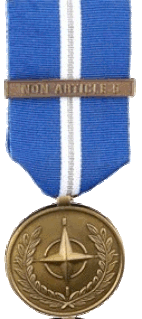
Non-Article 5 NATO Medal for Operations in the Balkans (NATO5)
On 14 December 1995 North Atlantic Council launched the largest military operation ever undertaken by the Alliance, Operation JOINT ENDEAVOUR. Based on UN Security Council Resolution 1031, NATO was given the mandate to implement the military aspects of the Peace Agreement. A NATO-led multinational force, called the Implementation Force (IFOR), started its mission on 20 December 1995. IFOR was given a one-year mandate.
After the peaceful conduct of the September 1996 elections, IFOR successfully completed its mission of implementing the military annexes of the General Framework Agreement for Peace. However, it was clear that much remained to be accomplished on the civil side and that the political environment would continue to be potentially unstable and insecure. On 25-26 September, one week after the Bosnian elections NATO Defence Ministers concluded that the Alliance needed to re-assess how it might continue to provide support for the establishment of a secure environment after the end of IFOR's mandate in December. The role of IFOR (Operation JOINT ENDEAVOUR) was to implement the peace. The role of SFOR (Operation JOINT GUARD / Operation JOINT FORGE) is to stabilise the peace. The difference between the tasks of IFOR and SFOR is reflected in their names.
12 December 1996, SFOR was authorised to implement the military aspects of the Peace Agreement as the legal successor to IFOR. Like IFOR, SFOR operates under Chapter VII of the UN Charter (peace enforcement).
ELIGIBILITY & CRITERIA
Awarded for 30 days continuous or 60 days cumulative service on the land or in the air spaces of Bosnia-Herzegovina, Croatia, the Former Yugoslavia (including Kosovo), Albania, and the Former Republic of Macedonia, between 1 January 2003 and ending on 29 March 2010 for service under operation BRONZE.
Service under operation KOBOLD qualifies for this medal from Aug 2008 to the present.
Aircrew will accumulate one day’s service for the first sortie flown of any day in the Area of Operation; additional sorties flown on the same day receive no further credit. This requirement exists for support as well as combat aircraft, support aircraft including tanker, airlift and surveillance platforms.
This medal replaces the NATO medals for the Former-Yugoslavia, Kosovo and the Former Yugoslav Republic of Macedonia.
DESCRIPTION
The Medal is circular in form and made of bronze, and bearing: on the obverse, the NATO star set in a wreath of olive leaves; and on the reverse, the title "North Atlantic Treaty Organization" and the words "In the service of peace and freedom" in English and French. A large ring is attached to the top of the medal. The bar is affixed onto the ribbon. A large ring is attached to the top of the medal. The ribbon is NATO-blue ribbon with two white stripes centered on the two outer thirds of the ribbon, with a silver stripe in the center of each white stripe. The white represents peace and the silver signifies that the operation was ordered in accordance with another article that the Article 5 of the North Atlantic Treaty.
BAR(S)
The medal is always issued with a bar. Medals issued until 31 December 2010 had a bar inscribed "NON ARTICLE 5" while those issued from 1 January 2011 onwards have a bar inscribed "BALKANS".The bar is worn centered on the ribbon. Where the undress ribbon is worn, a miniature version of the "BALKANS" bar is centered on the ribbon. Op BOREAS was the CF contribution to this operation, approximately 70 CF members were awarded this bar every rotation.
POSTNOMINALS
The use of a post-nominal is not authorized for this medal.
HISTORICAL NOTES
With the creation of this medal, NATO has abolished the practice of issuing tour numerals to recognize more than one tour with NATO forces. The “NON ARTICLE FIVE” medal will be issued once to recognize all service in the Balkans, regardless of the number of tours a member serves.
NATO no longer recognizes service in support areas such as Italy, Greece, Hungary and Austria as qualifying time towards the “NON ARTICLE FIVE” medal. A member must serve thirty days in the theatre of operations to qualify for the medal.
http://www.cmp-cpm.forces.gc.ca/dhr-ddhr/chc-tdh/index-eng.asp
On 14 December 1995 North Atlantic Council launched the largest military operation ever undertaken by the Alliance, Operation JOINT ENDEAVOUR. Based on UN Security Council Resolution 1031, NATO was given the mandate to implement the military aspects of the Peace Agreement. A NATO-led multinational force, called the Implementation Force (IFOR), started its mission on 20 December 1995. IFOR was given a one-year mandate.
After the peaceful conduct of the September 1996 elections, IFOR successfully completed its mission of implementing the military annexes of the General Framework Agreement for Peace. However, it was clear that much remained to be accomplished on the civil side and that the political environment would continue to be potentially unstable and insecure. On 25-26 September, one week after the Bosnian elections NATO Defence Ministers concluded that the Alliance needed to re-assess how it might continue to provide support for the establishment of a secure environment after the end of IFOR's mandate in December. The role of IFOR (Operation JOINT ENDEAVOUR) was to implement the peace. The role of SFOR (Operation JOINT GUARD / Operation JOINT FORGE) is to stabilise the peace. The difference between the tasks of IFOR and SFOR is reflected in their names.
12 December 1996, SFOR was authorised to implement the military aspects of the Peace Agreement as the legal successor to IFOR. Like IFOR, SFOR operates under Chapter VII of the UN Charter (peace enforcement).
ELIGIBILITY & CRITERIA
Awarded for 30 days continuous or 60 days cumulative service on the land or in the air spaces of Bosnia-Herzegovina, Croatia, the Former Yugoslavia (including Kosovo), Albania, and the Former Republic of Macedonia, between 1 January 2003 and ending on 29 March 2010 for service under operation BRONZE.
Service under operation KOBOLD qualifies for this medal from Aug 2008 to the present.
Aircrew will accumulate one day’s service for the first sortie flown of any day in the Area of Operation; additional sorties flown on the same day receive no further credit. This requirement exists for support as well as combat aircraft, support aircraft including tanker, airlift and surveillance platforms.
This medal replaces the NATO medals for the Former-Yugoslavia, Kosovo and the Former Yugoslav Republic of Macedonia.
DESCRIPTION
The Medal is circular in form and made of bronze, and bearing: on the obverse, the NATO star set in a wreath of olive leaves; and on the reverse, the title "North Atlantic Treaty Organization" and the words "In the service of peace and freedom" in English and French. A large ring is attached to the top of the medal. The bar is affixed onto the ribbon. A large ring is attached to the top of the medal. The ribbon is NATO-blue ribbon with two white stripes centered on the two outer thirds of the ribbon, with a silver stripe in the center of each white stripe. The white represents peace and the silver signifies that the operation was ordered in accordance with another article that the Article 5 of the North Atlantic Treaty.
BAR(S)
The medal is always issued with a bar. Medals issued until 31 December 2010 had a bar inscribed "NON ARTICLE 5" while those issued from 1 January 2011 onwards have a bar inscribed "BALKANS".The bar is worn centered on the ribbon. Where the undress ribbon is worn, a miniature version of the "BALKANS" bar is centered on the ribbon. Op BOREAS was the CF contribution to this operation, approximately 70 CF members were awarded this bar every rotation.
POSTNOMINALS
The use of a post-nominal is not authorized for this medal.
HISTORICAL NOTES
With the creation of this medal, NATO has abolished the practice of issuing tour numerals to recognize more than one tour with NATO forces. The “NON ARTICLE FIVE” medal will be issued once to recognize all service in the Balkans, regardless of the number of tours a member serves.
NATO no longer recognizes service in support areas such as Italy, Greece, Hungary and Austria as qualifying time towards the “NON ARTICLE FIVE” medal. A member must serve thirty days in the theatre of operations to qualify for the medal.
http://www.cmp-cpm.forces.gc.ca/dhr-ddhr/chc-tdh/index-eng.asp
Captain Richard J. Van Slyke MMM CD

International Commission for Supervision and Control Medal
The International Commission for Supervision and Control Medal is an international service medal awarded to personnel from the three countries that made up the International Commission for Supervision and Control (ICSC). The ICSC was born from the Geneva Agreements of 1954 which ended the First Indochina War. The medal was awarded for 90 days cumulative service with the ICSC between 1954 and 1974.
Description
The International Commission for Supervision and Control Medal is a circular bronze medal 34 mm (1.3 in) with a dark antiqued finish. The medal was made by Barton's Jewelers of Banglore, India. The obverse bears the design of the ICSC, the crossed flags of Canada and Poland with the Emblem of India between the flags. A dove is superimposed over the crossed poles of the flags. Around the edge are the words INTERNATIONAL COMMISSION FOR SUPERVISION AND CONTROL with the word PEACE at the base. The reverse of the medal bears a map of French Indochina with the borders of the individual countries of Laos, Cambodia, and Vietnam with each country's name.The medal is suspended from a straight bar with a bamboo shoot motif. It is attached to the medal by means of welded floral device. The medal hangs from a ribbon 32 mm (1.3 in) wide consisting of three equal stripes of dark green, white, and red.
The recipients' names and ranks were impressed on the edge in block capital letters, then filled in with white paint.
The medal is suspended from a straight bar with a bamboo shoot motif. It is attached to the medal by means of welded floral device. The medal hangs from a ribbon 32 mm (1.3 in) wide consisting of three equal stripes of dark green, white, and red.
The recipients' names and ranks were impressed on the edge in block capital letters, then filled in with white paint.
Douglas Edwin Gayton
The International Commission for Supervision and Control Medal is an international service medal awarded to personnel from the three countries that made up the International Commission for Supervision and Control (ICSC). The ICSC was born from the Geneva Agreements of 1954 which ended the First Indochina War. The medal was awarded for 90 days cumulative service with the ICSC between 1954 and 1974.
Description
The International Commission for Supervision and Control Medal is a circular bronze medal 34 mm (1.3 in) with a dark antiqued finish. The medal was made by Barton's Jewelers of Banglore, India. The obverse bears the design of the ICSC, the crossed flags of Canada and Poland with the Emblem of India between the flags. A dove is superimposed over the crossed poles of the flags. Around the edge are the words INTERNATIONAL COMMISSION FOR SUPERVISION AND CONTROL with the word PEACE at the base. The reverse of the medal bears a map of French Indochina with the borders of the individual countries of Laos, Cambodia, and Vietnam with each country's name.The medal is suspended from a straight bar with a bamboo shoot motif. It is attached to the medal by means of welded floral device. The medal hangs from a ribbon 32 mm (1.3 in) wide consisting of three equal stripes of dark green, white, and red.
The recipients' names and ranks were impressed on the edge in block capital letters, then filled in with white paint.
The medal is suspended from a straight bar with a bamboo shoot motif. It is attached to the medal by means of welded floral device. The medal hangs from a ribbon 32 mm (1.3 in) wide consisting of three equal stripes of dark green, white, and red.
The recipients' names and ranks were impressed on the edge in block capital letters, then filled in with white paint.
Douglas Edwin Gayton

European Security and Defence Policy Service Medal (ESDP)
The European Union (EU) established this medal on 1 January 2003 to provide recognition to those who serve in EU-led crisis management operations.
ELIGIBILITY & CRITERIA
Awarded to military and civilian personnel who have served 30 consecutive days either in the area of operations of a designated EU-led crisis management operations or in a EU HQ in designated positions in direct support of such operations.
The medal is always awarded with a bar to denote the mission for which it has been awarded.
DESCRIPTION
The medal is circular, silver in colour, 35 mm in diameter and bears on the obverse the emblem of the EU, which consist of a circle of 12 stars. On the reverse appears on three lines, the Latin inscription “PRO PACE UNUM”.
The medal is attached to the ribbon by a ring, which passed through a small ball attached to the top of the medal.
The ribbon is 37 mm in width and is EU blue with a central 10 mm stripe of yellow gold for personnel serving in theatre, the central stripe being white for eligible HQ personnel.
The bars to the medal are of the slide-on type, silver coloured with a raised edge and bear the name of the operation for which it is awarded on a stippled background.
BAR(S)
The Medal is always to be issued with a bar representing a particular mission:
EUPM for service with the EU Police Mission in Bosnia from 1 January 2003. Six Canadian police officers have been awarded the medal with this bar, five from the Royal Canadian Mounted Police and one from the Service de Police de la Communauté Urbaine de Montréal.
ARTEMIS for service with the European military operation in the Democratic Republic of Congo (DRC) between 12 June and 1 September 2003. The CF sent 2 CC-130 Hercules with support staff in the summer of 2003 to assist this mission by providing airlift from Entebbe, Uganda to Bunia in the DRC under the Canadian operation name CARAVAN. 53 CF members have been awarded this bar.
CONCORDIA for service with the EU military operation in the former Yugoslav Republic of Macedonia between 31 March and 15 December 2003. The CF had one staff officer, LCol J.M.R. Moreau, in the mission which had the Canadian Operation name FUSION and four other officers in the HQ positions.
PROXIMA for service with the European Union Police Mission in the former Yugoslav Republic of Macedonia from 15 December 2003 (no Canadian recipient to date).
ALTHEA for service with the European Union Force (EUFOR) in Bosnia-Herzegovina from 2 December 2004 to 31 May 2007. Op BOREAS was the CF contribution to this operation, approximately 70 CF members were awarded this bar every rotation.
POSTNOMINALS
The use of a post-nominal is not authorized for this medal.
HISTORICAL NOTES
The medal is accompanied by a certificate.
The European Union (EU) established this medal on 1 January 2003 to provide recognition to those who serve in EU-led crisis management operations.
ELIGIBILITY & CRITERIA
Awarded to military and civilian personnel who have served 30 consecutive days either in the area of operations of a designated EU-led crisis management operations or in a EU HQ in designated positions in direct support of such operations.
The medal is always awarded with a bar to denote the mission for which it has been awarded.
DESCRIPTION
The medal is circular, silver in colour, 35 mm in diameter and bears on the obverse the emblem of the EU, which consist of a circle of 12 stars. On the reverse appears on three lines, the Latin inscription “PRO PACE UNUM”.
The medal is attached to the ribbon by a ring, which passed through a small ball attached to the top of the medal.
The ribbon is 37 mm in width and is EU blue with a central 10 mm stripe of yellow gold for personnel serving in theatre, the central stripe being white for eligible HQ personnel.
The bars to the medal are of the slide-on type, silver coloured with a raised edge and bear the name of the operation for which it is awarded on a stippled background.
BAR(S)
The Medal is always to be issued with a bar representing a particular mission:
EUPM for service with the EU Police Mission in Bosnia from 1 January 2003. Six Canadian police officers have been awarded the medal with this bar, five from the Royal Canadian Mounted Police and one from the Service de Police de la Communauté Urbaine de Montréal.
ARTEMIS for service with the European military operation in the Democratic Republic of Congo (DRC) between 12 June and 1 September 2003. The CF sent 2 CC-130 Hercules with support staff in the summer of 2003 to assist this mission by providing airlift from Entebbe, Uganda to Bunia in the DRC under the Canadian operation name CARAVAN. 53 CF members have been awarded this bar.
CONCORDIA for service with the EU military operation in the former Yugoslav Republic of Macedonia between 31 March and 15 December 2003. The CF had one staff officer, LCol J.M.R. Moreau, in the mission which had the Canadian Operation name FUSION and four other officers in the HQ positions.
PROXIMA for service with the European Union Police Mission in the former Yugoslav Republic of Macedonia from 15 December 2003 (no Canadian recipient to date).
ALTHEA for service with the European Union Force (EUFOR) in Bosnia-Herzegovina from 2 December 2004 to 31 May 2007. Op BOREAS was the CF contribution to this operation, approximately 70 CF members were awarded this bar every rotation.
POSTNOMINALS
The use of a post-nominal is not authorized for this medal.
HISTORICAL NOTES
The medal is accompanied by a certificate.
Captain Richard J Van Slyke MMM CD
|
Sovereign’s Medal for Volunteers
The Sovereign’s Medal for Volunteers recognizes the exceptional volunteer achievements of Canadians from across the country and celebrates a wide range of voluntary contributions. The Sovereign’s Medal for Volunteers recognizes living Canadians who have made a significant, sustained and unpaid contribution to their community, in Canada or abroad. Non-Canadians are also eligible if their contribution brings benefit or honour to Canadians or to Canada. Major (Ret'd) Peter Moogk CD |

King George V Silver Jubilee Medal (KJM)
This medal was to mark the 25th year of the accession of King George V to the throne. It was awarded to the Royal Family, officers of state, officials and servants of the royal household, ministers, government officials, mayors, public servants, local government officials, members of the navy, army, air force and police in Britain, her colonies, and in Canada.
A circular, silver medal 1.25 inches in diameter. For mounting there a ring attaches to a double scroll claw on the upper edge of the medal.
The obverse features the conjoined effigies of King George V and Queen Mary, crowned and robed, facing left. The legend around the top edge reads GEORGE · V · AND · QUEEN · MARY · MAY · VI · MCMXXV ·
The reverse displays the Royal Cypher GVR surmounted by an Imperial Crown and on the left is the date MAY 6 / 1910 in two lines, and on the right the date: MAY 6 / 1935. The border is ornate.
The red ribbon is 1.25 inches wide, with three narrow stripes dark blue, white, and dark blue at each edge.
There were 7,500 medals to Canadians, of which 1,154 were to the Canadian Forces. A total of 85,235 were issued.
In the Canada Gazette Supplement 04 May 1935, all the names of the recipients are listed (64 pages). This is the only coronation or commemorative medal where this has been done
This medal was to mark the 25th year of the accession of King George V to the throne. It was awarded to the Royal Family, officers of state, officials and servants of the royal household, ministers, government officials, mayors, public servants, local government officials, members of the navy, army, air force and police in Britain, her colonies, and in Canada.
A circular, silver medal 1.25 inches in diameter. For mounting there a ring attaches to a double scroll claw on the upper edge of the medal.
The obverse features the conjoined effigies of King George V and Queen Mary, crowned and robed, facing left. The legend around the top edge reads GEORGE · V · AND · QUEEN · MARY · MAY · VI · MCMXXV ·
The reverse displays the Royal Cypher GVR surmounted by an Imperial Crown and on the left is the date MAY 6 / 1910 in two lines, and on the right the date: MAY 6 / 1935. The border is ornate.
The red ribbon is 1.25 inches wide, with three narrow stripes dark blue, white, and dark blue at each edge.
There were 7,500 medals to Canadians, of which 1,154 were to the Canadian Forces. A total of 85,235 were issued.
In the Canada Gazette Supplement 04 May 1935, all the names of the recipients are listed (64 pages). This is the only coronation or commemorative medal where this has been done

Queen Elizabeth II Coronation Medal (1953) (QECM)
Medals were awarded to a list of individuals similar to that for the King George V Jubilee Medal, as a personal souvenir to selected persons. There was no bar to this medal.
Description
A circular, silver medal, 1.25 inches in diameter.
Obverse
The obverse features a crowned effigy of Queen Elizabeth II, in a high-collared ermine cloak and wearing the collar of the Garter and Badge of the Bath, and facing right. There is no raised rim and no legend.
Reverse
The reverse shows the Royal Cypher EIIR surmounted by a large crown. The legend around the edge reads: QUEEN ELIZABETH II CROWNED 2nd JUNE 1953.
Mounting
A ring attached to a double-toe claw on the upper edge of the medal.
Ribbon
The dark red ribbon is 1.25 inches wide, with two narrow dark blue stripes (0.09375 inches {3/32"} wide) in the centre (0.0625" apart) and narrow white stripes (0.0625") at each edge. Ladies awarded the medal can wear it on their left shoulder with the ribbon tied in the form of a bow.
Date
The medals were presented following the coronation on 02 June 1953.
Issued
Of the 138,214 total medals issued, 12,500 went to Canadians
Major Edward Joseph Duckering Edmonds
Captain John Kenneth Alfred Foote
Warrant Officer Class II James Harold Galbraith
Sergeant Jim Buchanan Wortley
Medals were awarded to a list of individuals similar to that for the King George V Jubilee Medal, as a personal souvenir to selected persons. There was no bar to this medal.
Description
A circular, silver medal, 1.25 inches in diameter.
Obverse
The obverse features a crowned effigy of Queen Elizabeth II, in a high-collared ermine cloak and wearing the collar of the Garter and Badge of the Bath, and facing right. There is no raised rim and no legend.
Reverse
The reverse shows the Royal Cypher EIIR surmounted by a large crown. The legend around the edge reads: QUEEN ELIZABETH II CROWNED 2nd JUNE 1953.
Mounting
A ring attached to a double-toe claw on the upper edge of the medal.
Ribbon
The dark red ribbon is 1.25 inches wide, with two narrow dark blue stripes (0.09375 inches {3/32"} wide) in the centre (0.0625" apart) and narrow white stripes (0.0625") at each edge. Ladies awarded the medal can wear it on their left shoulder with the ribbon tied in the form of a bow.
Date
The medals were presented following the coronation on 02 June 1953.
Issued
Of the 138,214 total medals issued, 12,500 went to Canadians
Major Edward Joseph Duckering Edmonds
Captain John Kenneth Alfred Foote
Warrant Officer Class II James Harold Galbraith
Sergeant Jim Buchanan Wortley
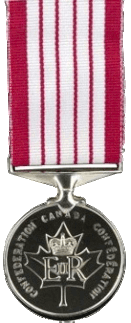
Canadian Centennial Medal (CCM)
This medal commemorates the Centennial of Canada's Confederation in 1867, and was awarded to people recommended by governments and associations. This medal is administered by the Chancellery of Honours at Rideau Hall.
A circular silver medal 1.42 inches (36 mm) in diameter with a thin plain raised rim:
On the obverse: The Royal Cypher EIIR surmounted by a crown is superimposed on a large single maple leaf. The inscription around the circumference reads CONFEDERATION · CANADA · CONFEDERATION with the word CANADA being at the top of the medal.On the reverse: The Coat of Arms of Canada with the dates 1867 – 1967 located under the Coat of Arms.
A wide triangular fixed suspender (0.1875" high) is attached to the medal by a prominent single-toe claw.
The ribbon is white with red edges and four equally spaced red stripes between the red edges, the red and white are the official colours of Canada as appointed by King George V in 1921, the red borders and white center are inspired by the new Canadian flag approved two years before the creation of this medal and the four thin red stripes each represent a quarter century for one hundred years;
There is no bar to this medal.
The use of a post-nominal is not authorized for this medal.
There were 29 500 issued, of which 8 500 were awarded to members of the Canadian Forces.
http://www.cmp-cpm.forces.gc.ca/dhr-ddhr/chc-tdh/index-eng.asp
Sergeant Brian P. Cormier
Sergeant Robert (Bob) E. Mugford
Staff Sergeant James Hamilton CD
This medal commemorates the Centennial of Canada's Confederation in 1867, and was awarded to people recommended by governments and associations. This medal is administered by the Chancellery of Honours at Rideau Hall.
A circular silver medal 1.42 inches (36 mm) in diameter with a thin plain raised rim:
On the obverse: The Royal Cypher EIIR surmounted by a crown is superimposed on a large single maple leaf. The inscription around the circumference reads CONFEDERATION · CANADA · CONFEDERATION with the word CANADA being at the top of the medal.On the reverse: The Coat of Arms of Canada with the dates 1867 – 1967 located under the Coat of Arms.
A wide triangular fixed suspender (0.1875" high) is attached to the medal by a prominent single-toe claw.
The ribbon is white with red edges and four equally spaced red stripes between the red edges, the red and white are the official colours of Canada as appointed by King George V in 1921, the red borders and white center are inspired by the new Canadian flag approved two years before the creation of this medal and the four thin red stripes each represent a quarter century for one hundred years;
There is no bar to this medal.
The use of a post-nominal is not authorized for this medal.
There were 29 500 issued, of which 8 500 were awarded to members of the Canadian Forces.
http://www.cmp-cpm.forces.gc.ca/dhr-ddhr/chc-tdh/index-eng.asp
Sergeant Brian P. Cormier
Sergeant Robert (Bob) E. Mugford
Staff Sergeant James Hamilton CD
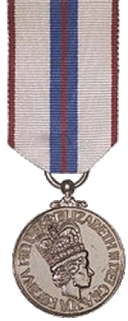
Queen Elizabeth II Silver Jubilee Medal (QSJM)
In order that the list of those to be honoured would be representative of all the regions of Canada, agencies of government at the federal, provincial, and local levels were invited to propose the names of candidates for the medal. National organizations in every important field of endeavour, including the professions, education and arts, veterans' groups, sports associations, philanthropic and charitable bodies and welfare services were asked to participate in submitting nominations. All members of the Order of Canada, Order of Military Merit and winners of the Canadian Bravery Decorations received the medal. Selection for the Armed Forces was based on merit with length of service and prestige of current appointment as secondary consideration. There is no bar to the medal.
The circular silver medal, 1.25 inches (32 mm) in diameter, has a thin, smooth raised rim. The Canadian issue was slightly thicker than the British issue. The obverse shows Queen Elizabeth II, facing right, wearing the high Imperial State Crown. The inscription around the rim reads: ELIZABETH II DEI GRATIA REGINA FID DEF. The reverse shows a large stylized maple leaf with CANADA around the top rim and 1952 EIIR 1977 in small lettering around the bottom of the rim. The EIIR has a small crown on top. In very small letters above and between the EIIR and 1977 is the word HUNT (for the designer of the medal Dora de Pédery-Hunt). A 0.5 inch (12 mm) silver ring, which holds the ribbon, passes through a small hollow ball at the top of a claw joined to the top of the medal. The watered white ribbon (representing the silver) is 1.25 inches (30 mm) wide, with cardinal red edge stripes (1 mm each). The middle is garter blue (7 mm wide), with a cardinal stripe (1 mm wide) running through its centre.
http://www.cmp-cpm.forces.gc.ca/dhr-ddhr/chc-tdh/index-eng.asp
Sergeant Gordie Wright CD
Lieutenant-Colonel W.T. (Bill) Wickett CD
Captain Peter Erwin CD
Master Warrant Officer James Hamilton CD
In order that the list of those to be honoured would be representative of all the regions of Canada, agencies of government at the federal, provincial, and local levels were invited to propose the names of candidates for the medal. National organizations in every important field of endeavour, including the professions, education and arts, veterans' groups, sports associations, philanthropic and charitable bodies and welfare services were asked to participate in submitting nominations. All members of the Order of Canada, Order of Military Merit and winners of the Canadian Bravery Decorations received the medal. Selection for the Armed Forces was based on merit with length of service and prestige of current appointment as secondary consideration. There is no bar to the medal.
The circular silver medal, 1.25 inches (32 mm) in diameter, has a thin, smooth raised rim. The Canadian issue was slightly thicker than the British issue. The obverse shows Queen Elizabeth II, facing right, wearing the high Imperial State Crown. The inscription around the rim reads: ELIZABETH II DEI GRATIA REGINA FID DEF. The reverse shows a large stylized maple leaf with CANADA around the top rim and 1952 EIIR 1977 in small lettering around the bottom of the rim. The EIIR has a small crown on top. In very small letters above and between the EIIR and 1977 is the word HUNT (for the designer of the medal Dora de Pédery-Hunt). A 0.5 inch (12 mm) silver ring, which holds the ribbon, passes through a small hollow ball at the top of a claw joined to the top of the medal. The watered white ribbon (representing the silver) is 1.25 inches (30 mm) wide, with cardinal red edge stripes (1 mm each). The middle is garter blue (7 mm wide), with a cardinal stripe (1 mm wide) running through its centre.
http://www.cmp-cpm.forces.gc.ca/dhr-ddhr/chc-tdh/index-eng.asp
Sergeant Gordie Wright CD
Lieutenant-Colonel W.T. (Bill) Wickett CD
Captain Peter Erwin CD
Master Warrant Officer James Hamilton CD
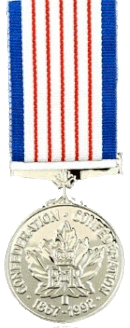
125 Anniversary of the Confederation of Canada Medal (C125)
The medal was awarded to those making a significant contribution to their fellow citizens, their community, or to Canada. Persons deceased prior to 01 January 1992 were not eligible for consideration. This commemorative medal program is now closed. This medal is administered by the Chancellery of Honours at Rideau Hall.
Military nominees were selected by the chain of command based on merit.
The medal is circular in form, made of copper and zinc alloy, rhodium plated (appears bright silver), 1.42 inches (36 mm) in diameter. On the obverse the Royal Cypher (EIIR) surmounted by a crown superimposed on a large single maple leaf, circumscribed with the legend CONFEDERATION CONFÉDÉRATION and the dates 1867 - 1992 at the bottom. On the reverse, the shield of arms of Canada encircled by the motto ribbon of the Order of Canada (which contains the words DESIDERANTE MELIOREM PATRIAM) ensigned by the central portion of the crest of Canada (a crowned lion holding a maple leaf in the right front paw) and circumscribed with the motto A MARI USQUE AD MARE at the bottom. A claw at the top of the medal attaches to a straight bar, with a maple leaf at the top of the claw where the claw attaches to the bar. The ribbon is white with edges of blue and five red stripes equally spaced between the two blue stripes. It is similar to the Centennial Medal ribbon except it has blue edges and one extra red stripe. The red and white are the official colours of Canada as appointed by King George V in 1921, the blue borders symbolize the motto of Canada A MARI USQUE AD MARE (From sea to sea) and the five thin red stripes each represent a quarter century for one hundred and twenty five years.
The use of a post-nominal is not authorized for this medal.
There were 42 000 issued, of which 4 000 were awarded to members of the Canadian Forces.
http://www.cmp-cpm.forces.gc.ca/dhr-ddhr/chc-tdh/index-eng.asp
Sergeant Donato Calogero
Master Bombardier Dawne Larsen
Bombardier William Martinez
Brigadier-General Stuart T, McDonald CD
Captain Richard J Van Slyke CD
The medal was awarded to those making a significant contribution to their fellow citizens, their community, or to Canada. Persons deceased prior to 01 January 1992 were not eligible for consideration. This commemorative medal program is now closed. This medal is administered by the Chancellery of Honours at Rideau Hall.
Military nominees were selected by the chain of command based on merit.
The medal is circular in form, made of copper and zinc alloy, rhodium plated (appears bright silver), 1.42 inches (36 mm) in diameter. On the obverse the Royal Cypher (EIIR) surmounted by a crown superimposed on a large single maple leaf, circumscribed with the legend CONFEDERATION CONFÉDÉRATION and the dates 1867 - 1992 at the bottom. On the reverse, the shield of arms of Canada encircled by the motto ribbon of the Order of Canada (which contains the words DESIDERANTE MELIOREM PATRIAM) ensigned by the central portion of the crest of Canada (a crowned lion holding a maple leaf in the right front paw) and circumscribed with the motto A MARI USQUE AD MARE at the bottom. A claw at the top of the medal attaches to a straight bar, with a maple leaf at the top of the claw where the claw attaches to the bar. The ribbon is white with edges of blue and five red stripes equally spaced between the two blue stripes. It is similar to the Centennial Medal ribbon except it has blue edges and one extra red stripe. The red and white are the official colours of Canada as appointed by King George V in 1921, the blue borders symbolize the motto of Canada A MARI USQUE AD MARE (From sea to sea) and the five thin red stripes each represent a quarter century for one hundred and twenty five years.
The use of a post-nominal is not authorized for this medal.
There were 42 000 issued, of which 4 000 were awarded to members of the Canadian Forces.
http://www.cmp-cpm.forces.gc.ca/dhr-ddhr/chc-tdh/index-eng.asp
Sergeant Donato Calogero
Master Bombardier Dawne Larsen
Bombardier William Martinez
Brigadier-General Stuart T, McDonald CD
Captain Richard J Van Slyke CD
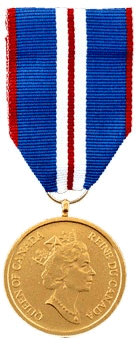
Queen Elizabeth II Golden Jubilee Medal (QGJM)
The Queen Elizabeth II Golden Jubilee Medal was created in 2002 to commemorate the 50th anniversary of the ascension of Her Majesty Queen Elizabeth II to the throne. The Medal was awarded to Canadians who have made outstanding and exemplary contributions to their communities or to Canada as a whole.
The award focuses both on the achievements of those people who, over the past 50 years, have helped create the Canada of today, and on the achievements of younger Canadians who are actively contributing to our future.
In order to ensure all regions of Canada were represented, various organizations were invited to propose candidates, including the federal, provincial and territorial levels of government; national professional, educational and cultural organizations; the military; the Royal Canadian Mounted Police; veterans’ groups; sports associations; and philanthropic and charitable bodies.
A circular gold-plated bronze medal with a thin raised edge. On the obverse of which is an effigy of Her Majesty Queen Elizabeth II, wearing the King George IV State Diadem, circumscribed with QUEEN OF CANADA . REINE DU CANADA, and on the reverse of which is a large stylized maple leaf, with CANADA inscribed at the bottom, and 1952 and 2002 inscribed on either side of the Royal Cipher and Crown. The Medal is worn suspended from a broad royal blue ribbon, with red outer stripes, and double white stripes with a red central stripe
Governor General of Canada website www.gg.ca
The Queen Elizabeth II Golden Jubilee Medal was created in 2002 to commemorate the 50th anniversary of the ascension of Her Majesty Queen Elizabeth II to the throne. The Medal was awarded to Canadians who have made outstanding and exemplary contributions to their communities or to Canada as a whole.
The award focuses both on the achievements of those people who, over the past 50 years, have helped create the Canada of today, and on the achievements of younger Canadians who are actively contributing to our future.
In order to ensure all regions of Canada were represented, various organizations were invited to propose candidates, including the federal, provincial and territorial levels of government; national professional, educational and cultural organizations; the military; the Royal Canadian Mounted Police; veterans’ groups; sports associations; and philanthropic and charitable bodies.
A circular gold-plated bronze medal with a thin raised edge. On the obverse of which is an effigy of Her Majesty Queen Elizabeth II, wearing the King George IV State Diadem, circumscribed with QUEEN OF CANADA . REINE DU CANADA, and on the reverse of which is a large stylized maple leaf, with CANADA inscribed at the bottom, and 1952 and 2002 inscribed on either side of the Royal Cipher and Crown. The Medal is worn suspended from a broad royal blue ribbon, with red outer stripes, and double white stripes with a red central stripe
Governor General of Canada website www.gg.ca
|
Lieutenant-Colonel Dean B Drysdale CD
Lieutenant-Colonel Leon Jensen CD Major James Barrett CD Captain Noel RR Dykes, CD Captain Richard J Van Slyke MMM CD Master Warrant Officer Ken Surges CD Warrant Officer Cheryl McHugh Warrant Officer James E Tempest CD Warrant Officer Kevin Walker CD Warrant Officer Robert G Wishnicki CD |
Sgt Ward Blair
Master Bombardier Patricia Kostuk CD Master Bombardier Scott Weaver Bombardier David Jeffs CD Bombardier Nathaniel Senff Bombardier Malcolm Sings Bombardier Brian Smith CD Bombardier Ronald Toth Bombardier Edward Trovato CD Gunner Joseph Foster |
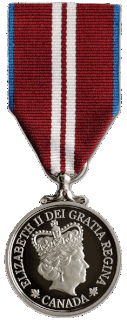
Queen Elizabeth II Diamond Jubilee Medal (QDJM)
Created in 2012 to mark the 60th anniversary of Her Majesty Queen Elizabeth II’s accession to the Throne as Queen of Canada, the Queen Elizabeth II Diamond Jubilee Medal was a tangible way for Canada to honour Her Majesty for her service to this country. At the same time, this commemorative medal served to honour significant contributions and achievements by Canadians. During the year of celebrations, 60 000 deserving Canadians were recognized.
To ensure that a variety of fields of activity were recognized, partner organizations were invited by the Government of Canada to nominate candidates from their community or organization for this national honour.
The obverse depicts a crowned image of the Sovereign, in whose name the medal is bestowed. The reverse marks the sixtieth, or diamond, anniversary of the accession to the Throne of Her Majesty Queen Elizabeth II. The anniversary is expressed by the central diamond shape, by the background composed of a pattern of diamonds, and by the two dates. The Royal Cypher consists of the Royal Crown above the letters EIIR (i.e., Elizabeth II Regina, the latter word meaning Queen in Latin). The maple leaves refer to Canada, while the motto VIVAT REGINA means “Long live The Queen!”
The ribbon uses a new arrangement of the blue, red and white colours found in the 1953 Coronation Medal, the 1977 Silver Jubilee Medal, and the 2002 Golden Jubilee Medal.
Created in 2012 to mark the 60th anniversary of Her Majesty Queen Elizabeth II’s accession to the Throne as Queen of Canada, the Queen Elizabeth II Diamond Jubilee Medal was a tangible way for Canada to honour Her Majesty for her service to this country. At the same time, this commemorative medal served to honour significant contributions and achievements by Canadians. During the year of celebrations, 60 000 deserving Canadians were recognized.
To ensure that a variety of fields of activity were recognized, partner organizations were invited by the Government of Canada to nominate candidates from their community or organization for this national honour.
The obverse depicts a crowned image of the Sovereign, in whose name the medal is bestowed. The reverse marks the sixtieth, or diamond, anniversary of the accession to the Throne of Her Majesty Queen Elizabeth II. The anniversary is expressed by the central diamond shape, by the background composed of a pattern of diamonds, and by the two dates. The Royal Cypher consists of the Royal Crown above the letters EIIR (i.e., Elizabeth II Regina, the latter word meaning Queen in Latin). The maple leaves refer to Canada, while the motto VIVAT REGINA means “Long live The Queen!”
The ribbon uses a new arrangement of the blue, red and white colours found in the 1953 Coronation Medal, the 1977 Silver Jubilee Medal, and the 2002 Golden Jubilee Medal.
|
Colonel Leon Jensen OMM CD
Honorary Colonel Roy Grant Smith Lieutenant-Colonel Dean B Drysdale CD Major Brent A Purcell CD Captain James E Tempest CD Captain Douglas P Gayton MMM CD |
Chief Warrant Officer Robert G Wishnicki CD
Master Warrant Officer Rob Garrett CD Warrant Officer Ian M Smith CD Sergeant Benjamin Van Slyke CD Master Bombardier Kazue Maruyama |
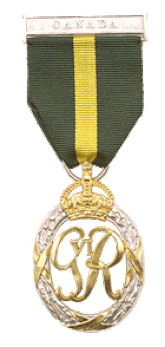
Canadian Efficiency Decoration (ED)
Medal was presented for 20 years meritorious service in the Non-permanent active militia, RCAF Auxiliary and Reserve until 17 August 1942 for Commissioned officers. The bar awarded for 20 additional years
The medal consisted of an oval oak wreath in silver, tied with gold, enclosing the Royal Cypher and surmounted by a gold crown. The obverse features one of the Royal Cyphers GRV, GRI or EIIR and the reverse is plain for engraving names. A ring passes through a small hole at the top of the crown. There is a bar at the top of the ribbon with the word CANADA on it. The green ribbon is 1.5 inches wide, with a central yellow stripe (0.25" wide).
There have been approximately 3,700 issued. War service counted double and half of the time spent in the ranks counted towards this medal.
Superseded by Canadian Forces Decoration (CD).
http://www.veterans.gc.ca/eng/remembrance/medals-decorations/orders-decorations
Medal was presented for 20 years meritorious service in the Non-permanent active militia, RCAF Auxiliary and Reserve until 17 August 1942 for Commissioned officers. The bar awarded for 20 additional years
The medal consisted of an oval oak wreath in silver, tied with gold, enclosing the Royal Cypher and surmounted by a gold crown. The obverse features one of the Royal Cyphers GRV, GRI or EIIR and the reverse is plain for engraving names. A ring passes through a small hole at the top of the crown. There is a bar at the top of the ribbon with the word CANADA on it. The green ribbon is 1.5 inches wide, with a central yellow stripe (0.25" wide).
There have been approximately 3,700 issued. War service counted double and half of the time spent in the ranks counted towards this medal.
Superseded by Canadian Forces Decoration (CD).
http://www.veterans.gc.ca/eng/remembrance/medals-decorations/orders-decorations
Lieutenant-Colone Aeneas E. McBean Bell-Irving OBE ED Awarded 1945 Honorary Colonel 1957
Major Gordon Younghusband L. Crossley ED Commanding Officer 1938-1940
Lieutenant-Colonel Cyril Gainsborough Beeston ED Commanding Officer 1934-1938
Captain Edward Joseph Duckering Edmonds ED
Lieutenant-Colonel Robert Theodore DuMoulin ED Awarded 1944 Commanding Officer 1946-1948
Major C.K. Rosebrugh ED Awarded 1943 Commanding Officer 1943-1946
Lieutenant-Colonel E.A. Royce ED Commanding Officer 1948-1951
Lieutenant-Colonel William Allen Townsley MC ED Awarded 1943 Commanding Officer 1924-1930
Lieutenant-Colonel F.C. Underhill ED Commanding Officer 1940-1943
Honorary Colonel William Charles Woodward ED Awarded 1946 Honorary Lieutenant-Colonel/Colonel 1933-1957
Major Gordon Younghusband L. Crossley ED Commanding Officer 1938-1940
Lieutenant-Colonel Cyril Gainsborough Beeston ED Commanding Officer 1934-1938
Captain Edward Joseph Duckering Edmonds ED
Lieutenant-Colonel Robert Theodore DuMoulin ED Awarded 1944 Commanding Officer 1946-1948
Major C.K. Rosebrugh ED Awarded 1943 Commanding Officer 1943-1946
Lieutenant-Colonel E.A. Royce ED Commanding Officer 1948-1951
Lieutenant-Colonel William Allen Townsley MC ED Awarded 1943 Commanding Officer 1924-1930
Lieutenant-Colonel F.C. Underhill ED Commanding Officer 1940-1943
Honorary Colonel William Charles Woodward ED Awarded 1946 Honorary Lieutenant-Colonel/Colonel 1933-1957

Canadian Forces Decoration (CD)
The Canadian Forces Decoration is awarded to officers, and to the men and women of the Canadian Forces who have completed twelve years of service. The medal is awarded to all ranks, who must have a good record of conduct during the final eight years of claimed service. The medal is awarded to the Regular Forces, Reserve forces and to Officers to the Cadet Instructors List (CIL). Service in the regular and reserve of auxiliary forces of the British Commonwealth of Nations will be counted towards the medal if the final five years have been with the Canadian Forces and no other long service, good conduct or efficiency medal has been awarded for the same service. The medal may be awarded to persons in possession of any long service, good conduct or efficiency decoration or medal clasps, provided that the individual has completed the full qualifying periods of service for each award and that no service qualifying towards one award is permitted to count towards any other. The service need not be continuous. This award supersedes all other awards for members joining the Canadian Forces after 01 September 1939
See more...
The Canadian Forces Decoration is awarded to officers, and to the men and women of the Canadian Forces who have completed twelve years of service. The medal is awarded to all ranks, who must have a good record of conduct during the final eight years of claimed service. The medal is awarded to the Regular Forces, Reserve forces and to Officers to the Cadet Instructors List (CIL). Service in the regular and reserve of auxiliary forces of the British Commonwealth of Nations will be counted towards the medal if the final five years have been with the Canadian Forces and no other long service, good conduct or efficiency medal has been awarded for the same service. The medal may be awarded to persons in possession of any long service, good conduct or efficiency decoration or medal clasps, provided that the individual has completed the full qualifying periods of service for each award and that no service qualifying towards one award is permitted to count towards any other. The service need not be continuous. This award supersedes all other awards for members joining the Canadian Forces after 01 September 1939
See more...

Corrections Exemplary Service Medal (CESM)
The Corrections Exemplary Service Medal, created on June 11, 1984, recognizes employees of the Canadian Correctional Service who have served in an exemplary manner, characterized by good conduct, industry and efficiency. Recipients must have been working on or after the date of creation of the Medal, and must have completed 20 years of full-time service, not necessarily continuous, with one or more of the correctional services in Canada.
Service of 20 years must include 10 years as a peace officer in an institution, parole officer or probation officer, or in a capacity which has brought the recipient into contact with offenders in the regular performance of duties.
Consideration is given only to periods of service for which no other long service, good conduct or efficiency decoration or medal has been awarded by the Crown. Exemplary service in any other occupation eligible for award for exemplary service may count as qualifying service. The Medal may be awarded posthumously.
Captain Rob Wishnicki CD
The Corrections Exemplary Service Medal, created on June 11, 1984, recognizes employees of the Canadian Correctional Service who have served in an exemplary manner, characterized by good conduct, industry and efficiency. Recipients must have been working on or after the date of creation of the Medal, and must have completed 20 years of full-time service, not necessarily continuous, with one or more of the correctional services in Canada.
Service of 20 years must include 10 years as a peace officer in an institution, parole officer or probation officer, or in a capacity which has brought the recipient into contact with offenders in the regular performance of duties.
Consideration is given only to periods of service for which no other long service, good conduct or efficiency decoration or medal has been awarded by the Crown. Exemplary service in any other occupation eligible for award for exemplary service may count as qualifying service. The Medal may be awarded posthumously.
Captain Rob Wishnicki CD
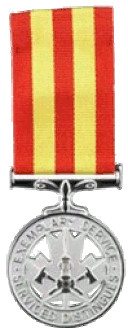
Fire Services Exemplary Service Medal (FSESM)
The Fire Services Exemplary Service Medal, created on August 29, 1985, honours members of a recognized Canadian fire service who have completed 20 years of service, ten years of which have been served in the performance of duties involving potential risks, and were employed on or after the date of creation of the Medal. Recognized fire services include Canadian fire departments, fire marshals’ offices, fire commissioners’ offices and the Canadian Forces fire services. Exemplary service is characterized by good conduct, industry and efficiency.
Consideration is given only to periods of service for which no other long service, good conduct or efficiency decoration or medal has been awarded by the Crown. The Medal may be awarded posthumously.
Chief Warrant Officer Mark Jackson CD
Major Nick Watts CD
The Fire Services Exemplary Service Medal, created on August 29, 1985, honours members of a recognized Canadian fire service who have completed 20 years of service, ten years of which have been served in the performance of duties involving potential risks, and were employed on or after the date of creation of the Medal. Recognized fire services include Canadian fire departments, fire marshals’ offices, fire commissioners’ offices and the Canadian Forces fire services. Exemplary service is characterized by good conduct, industry and efficiency.
Consideration is given only to periods of service for which no other long service, good conduct or efficiency decoration or medal has been awarded by the Crown. The Medal may be awarded posthumously.
Chief Warrant Officer Mark Jackson CD
Major Nick Watts CD

British Columbia Long Service Medal
The province awards the British Columbia Long Service Medal to people who have completed at least 25 years of paid or volunteer fire service. The medal recognizes their dedicated and selflessness service to their communities and province.
The province also awards the British Columbia Long Service Bar for 35 and 45 years of fire service.Years of fire service include paid service, volunteer service or a combination of both. Documentation of fire service must be submitted with the application.
If the nomination is for the fire chief, the nominating authority must be the person the fire chief reports to such as the mayor or chief administrative officer of their village, town, district or city. Self-nominations will not be accepted
Chief Warrant Officer Mark Jackson CD
The province awards the British Columbia Long Service Medal to people who have completed at least 25 years of paid or volunteer fire service. The medal recognizes their dedicated and selflessness service to their communities and province.
The province also awards the British Columbia Long Service Bar for 35 and 45 years of fire service.Years of fire service include paid service, volunteer service or a combination of both. Documentation of fire service must be submitted with the application.
If the nomination is for the fire chief, the nominating authority must be the person the fire chief reports to such as the mayor or chief administrative officer of their village, town, district or city. Self-nominations will not be accepted
Chief Warrant Officer Mark Jackson CD
|
Memorial Cross
The Memorial Cross is an award that has been granted since 1919 to the loved ones of Canadian Armed Forces personnel who died in service or whose death was attributed to their service. It is granted by the Government of Canada and is frequently referred to as the Silver Cross. In the past it has only been given to mothers and widows. The Memorial Cross, the gift of Canada, was issued as a memento of personal loss and sacrifice on the part of widows and mothers of Canadian sailors, soldiers and airmen who died for their country during the war. The Memorial Cross is in the form of a cross pattee, in silver, suspended by a bar brooch, although prior to 1945 it was suspended from a light purple ribbon 11 mm wide. At the end of the upright is a crown and at the foot and the end of either arm, a maple leaf. In the centre, within a wreath of laurel, is the royal cypher of the reigning monarch: GRI for King George the Fifth, GVIR for King George the Sixth, or EIIR for Elizabeth the Second. The reverse of the Cross is engraved with the name and service number of the individual commemorated. Known regimental recipients of the Memorial Cross are featured on a seperate page. These include: Captain Oliver Alexander Mowat, MC Gunner Wallace Reece Brunt Sergeant James Stevenson Richardson |
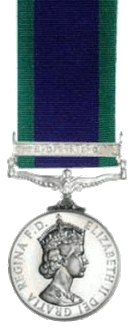
The General Service Medal (GSM)
The General Service Medal (1962) GSM, also sometimes referred to as the Campaign Service Medal), was introduced in 1962 to combine the General Service Medal (1918), as awarded to the Army and RAF, and the Naval General Service Medal (1915). The 1962 GSM was awarded until 2007, when it was replaced by the Operational Service Medal.The 1962 GSM is a circular Silver medal. The obverse shows the crowned effigy of Queen Elizabeth II. The reverse bears the words ‘FOR CAMPAIGN SERVICE' under a crown, all surrounded by a wreath of oak leaves. The popular motto for this medal grouping is "Against All Odds" whereas the accurate motto is "Against Adversity". The 32 mm wide ribbon is purple with two outer stripes of dark green. These are the same colours as the GSM 1918–62, but with different proportions of these two colours being used for this medal. GSMs have the name, rank, service number and regiment or corps of the awardee annotated on the rim of the medal. Thirteen Clasps were awarded to the 1962 GSM. The maximum awarded to any one individual appears to have been six.
Radfan Bar
Awarded to members of 815 Naval Air Squadron, sailors on HMS Centaur, and soldiers and RAF aircrew that were involved in the campaign mounted by British personnel, with Federation troops, against the Egyptian/Yemeni backed Radfan tribesmen. They were quickly and effectively defeated.
1964 Bombardier John Brownlee-Baker
South Arabia Bar
This campaign is related to the Radfan Campaign, because both were Egyptian-inspired attempts to end the British presence in Aden and end the embryonic Federation of South Arabia.
This 3 year long campaign saw numerous terrorist attacks on both civilian and military targets. In both Rafan and Aden, the British Army suffered 90 personnel killed and 510 wounded.
The qualifying period was 30 days service in the Federation of South Arabia between 1 August 1964 and 30 November 1967.
Sergeant John Brownlee-Baker
Northern Ireland Bar
This clasp was instituted for award to personnel involved in varying operations in Northern Ireland during The Troubles.
The general qualifying period is a minimum of 30 days' service between 14 August 1969 and 31 July 2007. The 30 days' service does not have to be composed of consecutive days. Should the qualifying period be cut short due to injury or death, then the completed days are counted as sufficient for the award of this clasp.
Warrant Officer Class II John Brownlee-Baker
The General Service Medal (1962) GSM, also sometimes referred to as the Campaign Service Medal), was introduced in 1962 to combine the General Service Medal (1918), as awarded to the Army and RAF, and the Naval General Service Medal (1915). The 1962 GSM was awarded until 2007, when it was replaced by the Operational Service Medal.The 1962 GSM is a circular Silver medal. The obverse shows the crowned effigy of Queen Elizabeth II. The reverse bears the words ‘FOR CAMPAIGN SERVICE' under a crown, all surrounded by a wreath of oak leaves. The popular motto for this medal grouping is "Against All Odds" whereas the accurate motto is "Against Adversity". The 32 mm wide ribbon is purple with two outer stripes of dark green. These are the same colours as the GSM 1918–62, but with different proportions of these two colours being used for this medal. GSMs have the name, rank, service number and regiment or corps of the awardee annotated on the rim of the medal. Thirteen Clasps were awarded to the 1962 GSM. The maximum awarded to any one individual appears to have been six.
Radfan Bar
Awarded to members of 815 Naval Air Squadron, sailors on HMS Centaur, and soldiers and RAF aircrew that were involved in the campaign mounted by British personnel, with Federation troops, against the Egyptian/Yemeni backed Radfan tribesmen. They were quickly and effectively defeated.
1964 Bombardier John Brownlee-Baker
South Arabia Bar
This campaign is related to the Radfan Campaign, because both were Egyptian-inspired attempts to end the British presence in Aden and end the embryonic Federation of South Arabia.
This 3 year long campaign saw numerous terrorist attacks on both civilian and military targets. In both Rafan and Aden, the British Army suffered 90 personnel killed and 510 wounded.
The qualifying period was 30 days service in the Federation of South Arabia between 1 August 1964 and 30 November 1967.
Sergeant John Brownlee-Baker
Northern Ireland Bar
This clasp was instituted for award to personnel involved in varying operations in Northern Ireland during The Troubles.
The general qualifying period is a minimum of 30 days' service between 14 August 1969 and 31 July 2007. The 30 days' service does not have to be composed of consecutive days. Should the qualifying period be cut short due to injury or death, then the completed days are counted as sufficient for the award of this clasp.
Warrant Officer Class II John Brownlee-Baker

Medal for Long Service and Good Conduct (Military) (LSGC)
On 23 September 1930 the Medal for Long Service and Good Conduct (Military) was instituted by King George V as a single medal for the regular other ranks of the British Army and those of all Permanent Forces of the British Empire. The new medal, which replaced the Army Long Service and Good Conduct Medal as well as the Permanent Forces of the Empire Beyond the Seas Medal, once again had various territorial versions, this time in the form of subsidiary titles inscribed on a bar attached to the suspender of the medal rather than on the medal's reverse. These subsidiary titles were "Regular Army" on the bar of the medal for the British Army and the name of the dominion country on the bars of the medals for Australia, Canada, India and New Zealand.
1976 Warrant Officer Class 1 John Brownlee-Baker
On 23 September 1930 the Medal for Long Service and Good Conduct (Military) was instituted by King George V as a single medal for the regular other ranks of the British Army and those of all Permanent Forces of the British Empire. The new medal, which replaced the Army Long Service and Good Conduct Medal as well as the Permanent Forces of the Empire Beyond the Seas Medal, once again had various territorial versions, this time in the form of subsidiary titles inscribed on a bar attached to the suspender of the medal rather than on the medal's reverse. These subsidiary titles were "Regular Army" on the bar of the medal for the British Army and the name of the dominion country on the bars of the medals for Australia, Canada, India and New Zealand.
1976 Warrant Officer Class 1 John Brownlee-Baker

Croix de guerre (France) (CdGF)
The Croix de guerre (English: War Cross) is a French military decoration. It was created to recognize French and allied soldiers who were cited for their service during World War I, similar to the British mentioned in dispatches. Soon after the outbreak of World War I, French military officials felt that a new military award had to be created. At that time, the Citation du jour ("Daily Service Citation") already existed to acknowledge soldiers, but it was just a sheet of paper.
At the end of 1914, General Boëlle, Commandant in Chief of the French 4th Army Corps, tried to convince the French administration to create the formal military award. On December 23, 1914, the French deputy Georges Bonnefous proposed a legislative bill to create the Croix de la Valeur Militaire ("Cross of Military Valor") signed by 66 other deputies. Émile Driant, a deputy who served in the war zone during much of this time, became its natural spokesman when he returned to the legislature. On 18 January 1915, Driant submitted this bill but the name of the military award was renamed the Croix de guerre ("Cross of War"). After parliamentary discussions, the bill was adopted on 2 April 1915.
World War I began in 1914 and ended in 1918, so the final name became "Croix de guerre 1914–1918".
Every Croix de guerre carries at least one mention awarded for gallantry to any member of the French military or its allies. Degrees indicate the importance of the former soldier's role during the War. The lowest degree is represented by a bronze star and the highest degree is represented by a silver palm. The number of mentions on a Croix de guerre is not limited.
The cross was designed by the sculptor Paul-Albert Bartholomé. It is 37 mm in diameter, Florentine bronze cross patée, with two crossed swords between the arms. The center of the front side shows the symbolic profile of the French Republic: a young woman wearing a Phrygian cap. The words République française (French Republic) encircle the portrait. The back of the medal shows the dates of the conflict: first, it was 1914–1915 then 1914–1916, 1914–1917, 1914–1918. A subsequent issue for World War II was labelled 1939-1945. The cross is suspended by a green ribbon with seven narrow vertical red stripes.
https://en.wikipedia.org/wiki/Croix_de_guerre_1914%E2%80%931918_(France)
The Croix de guerre (English: War Cross) is a French military decoration. It was created to recognize French and allied soldiers who were cited for their service during World War I, similar to the British mentioned in dispatches. Soon after the outbreak of World War I, French military officials felt that a new military award had to be created. At that time, the Citation du jour ("Daily Service Citation") already existed to acknowledge soldiers, but it was just a sheet of paper.
At the end of 1914, General Boëlle, Commandant in Chief of the French 4th Army Corps, tried to convince the French administration to create the formal military award. On December 23, 1914, the French deputy Georges Bonnefous proposed a legislative bill to create the Croix de la Valeur Militaire ("Cross of Military Valor") signed by 66 other deputies. Émile Driant, a deputy who served in the war zone during much of this time, became its natural spokesman when he returned to the legislature. On 18 January 1915, Driant submitted this bill but the name of the military award was renamed the Croix de guerre ("Cross of War"). After parliamentary discussions, the bill was adopted on 2 April 1915.
World War I began in 1914 and ended in 1918, so the final name became "Croix de guerre 1914–1918".
Every Croix de guerre carries at least one mention awarded for gallantry to any member of the French military or its allies. Degrees indicate the importance of the former soldier's role during the War. The lowest degree is represented by a bronze star and the highest degree is represented by a silver palm. The number of mentions on a Croix de guerre is not limited.
The cross was designed by the sculptor Paul-Albert Bartholomé. It is 37 mm in diameter, Florentine bronze cross patée, with two crossed swords between the arms. The center of the front side shows the symbolic profile of the French Republic: a young woman wearing a Phrygian cap. The words République française (French Republic) encircle the portrait. The back of the medal shows the dates of the conflict: first, it was 1914–1915 then 1914–1916, 1914–1917, 1914–1918. A subsequent issue for World War II was labelled 1939-1945. The cross is suspended by a green ribbon with seven narrow vertical red stripes.
https://en.wikipedia.org/wiki/Croix_de_guerre_1914%E2%80%931918_(France)
Major Frederick Thomas Coghlan DSO DDS LDS 3 September 1918 Commanding Officer 1920-1924
Lieutenant-Colonel William Wasbrough Foster DSO 7 January 1919 Honorary Colonel 1932-1938
Lieutenant Archibald Eric James Sudbury 28 April 1945 Former member 15th Brigade CFA
Lieutenant-Colonel William Wasbrough Foster DSO 7 January 1919 Honorary Colonel 1932-1938
Lieutenant Archibald Eric James Sudbury 28 April 1945 Former member 15th Brigade CFA
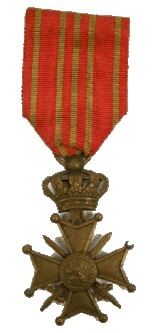
Croix de guerre (Belgium)(CdGB)
The World War I Croix de guerre was established by royal decree on 25 October 1915 as an award for bravery or other military virtue on the battlefield. It was only awarded to individuals. The Croix de guerre was not only awarded for bravery but also for three years or more of service on the front line, or for good conduct on the battlefield. It was also awarded to volunteers older than 40 or younger than 16 after a minimum of 18 months of service, to escaped prisoners of war rejoining the armed forces, and to military personnel who were placed on inactive duty because of injury. The World War I Croix de guerre was a 40mm wide bronze Maltese cross with 3mm in diameter balls at its eight points. It had a 14mm in diameter central medallion bearing the relief image of a "lion rampant" on its obverse and the royal cypher of King Albert I on its reverse. Two 37mm long crossed swords point upwards between it arms. A 14mm high "inverted V" between the two points of the top cross arm is secured to the inside of a 25mm wide by 25mm high royal crown, the ribbon's suspension ring passes through the top orb of the crown giving the cross a total height of 65mm.
The World War I Croix de guerre's ribbon is red with five 2mm wide light green longitudinal stripes, three at the center separated by 3mm and one on each side 3mm from the edges.
When the person being awarded the Croix de guerre was mentioned in despatches, this distinction was denoted by a device worn on the ribbon, either a small lion or a palm adorned with the monogram "A" (for Albert I): Bronze lion: regimental level; Silver lion: brigade level; Gold lion: divisional level; Bronze palm: Army level; Silver palm: five bronze palms; Gold palm: five silver palms
When awarded posthumously, the ribbon of the Croix de guerre was adorned with a narrow black enamel bar.
https://en.wikipedia.org/wiki/Croix_de_guerre_(Belgium)
Lieutenant-Colonel William Wasbrough Foster DSO 12 July 1918 Honorary Colonel 1932-1938
Sergeant Francis James Hully 12 July 1918 Enlisted Boorman's Battery
The World War I Croix de guerre was established by royal decree on 25 October 1915 as an award for bravery or other military virtue on the battlefield. It was only awarded to individuals. The Croix de guerre was not only awarded for bravery but also for three years or more of service on the front line, or for good conduct on the battlefield. It was also awarded to volunteers older than 40 or younger than 16 after a minimum of 18 months of service, to escaped prisoners of war rejoining the armed forces, and to military personnel who were placed on inactive duty because of injury. The World War I Croix de guerre was a 40mm wide bronze Maltese cross with 3mm in diameter balls at its eight points. It had a 14mm in diameter central medallion bearing the relief image of a "lion rampant" on its obverse and the royal cypher of King Albert I on its reverse. Two 37mm long crossed swords point upwards between it arms. A 14mm high "inverted V" between the two points of the top cross arm is secured to the inside of a 25mm wide by 25mm high royal crown, the ribbon's suspension ring passes through the top orb of the crown giving the cross a total height of 65mm.
The World War I Croix de guerre's ribbon is red with five 2mm wide light green longitudinal stripes, three at the center separated by 3mm and one on each side 3mm from the edges.
When the person being awarded the Croix de guerre was mentioned in despatches, this distinction was denoted by a device worn on the ribbon, either a small lion or a palm adorned with the monogram "A" (for Albert I): Bronze lion: regimental level; Silver lion: brigade level; Gold lion: divisional level; Bronze palm: Army level; Silver palm: five bronze palms; Gold palm: five silver palms
When awarded posthumously, the ribbon of the Croix de guerre was adorned with a narrow black enamel bar.
https://en.wikipedia.org/wiki/Croix_de_guerre_(Belgium)
Lieutenant-Colonel William Wasbrough Foster DSO 12 July 1918 Honorary Colonel 1932-1938
Sergeant Francis James Hully 12 July 1918 Enlisted Boorman's Battery
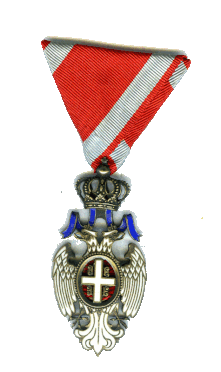
Order of the White Eagle (OWE)
The Order of the White Eagle was a Royal Order in the Kingdom of Serbia (1883–1918) and the Kingdom of Yugoslavia (1918–1945). King Milan I of Serbia instituted the Order of the White Eagle on 23 January 1883, concurrently with the Order of St. Sava. The Order had five classes and was conferred on Serbian and Yugoslav citizens for achievements in peace or war, or for special merits to the Crown, the state and nation. In the period between 1883 and 1898 Order of the White Eagle was the highest award in the Kingdom of Serbia. In 1898 the Royal Order of Miloš the Great took precedence over the White Eagle and in 1904 the former was replaced by the Order of the Karađorđe's Star.[1]
After his accession to the throne in 1903, King Peter I of Serbia continued awarding the Order of the White Eagle, but the reverse of the medallion had the year of the proclamation of the Kingdom (1883) instead of the cipher of Milan I.
Major David Neil Hossie DSO 4th Class Battery Commander 85th Battery in 1922
The Order of the White Eagle was a Royal Order in the Kingdom of Serbia (1883–1918) and the Kingdom of Yugoslavia (1918–1945). King Milan I of Serbia instituted the Order of the White Eagle on 23 January 1883, concurrently with the Order of St. Sava. The Order had five classes and was conferred on Serbian and Yugoslav citizens for achievements in peace or war, or for special merits to the Crown, the state and nation. In the period between 1883 and 1898 Order of the White Eagle was the highest award in the Kingdom of Serbia. In 1898 the Royal Order of Miloš the Great took precedence over the White Eagle and in 1904 the former was replaced by the Order of the Karađorđe's Star.[1]
After his accession to the throne in 1903, King Peter I of Serbia continued awarding the Order of the White Eagle, but the reverse of the medallion had the year of the proclamation of the Kingdom (1883) instead of the cipher of Milan I.
Major David Neil Hossie DSO 4th Class Battery Commander 85th Battery in 1922

Bronze Medal of Military Valour (Medaglia di bronzo al valor militare) (BMMV)
The Bronze Medal of Military Valour is an Italian medal for gallantry. It was established by Charles Albert of Sardinia on 26 March 1833, along with the higher ranking Gold and Silver Medals for Military valour. the medal was established by the Royal Decree of 4 November 1932, in which their purpose is defined as "To distinguish and publicly honor the authors of heroic military acts, even ones performed in time of peace, provided that the exploit is closely connected with the purposes for which the Armed Forces are constituted, whatever may be the condition or quality of the author."
During the First World War, the medal was given out some 60,244 times for individual acts of heroism.
Sergeant Claude Drone Winegard
The Bronze Medal of Military Valour is an Italian medal for gallantry. It was established by Charles Albert of Sardinia on 26 March 1833, along with the higher ranking Gold and Silver Medals for Military valour. the medal was established by the Royal Decree of 4 November 1932, in which their purpose is defined as "To distinguish and publicly honor the authors of heroic military acts, even ones performed in time of peace, provided that the exploit is closely connected with the purposes for which the Armed Forces are constituted, whatever may be the condition or quality of the author."
During the First World War, the medal was given out some 60,244 times for individual acts of heroism.
Sergeant Claude Drone Winegard
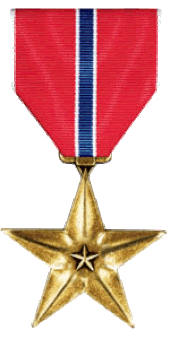
The Bronze Star Medal (United States of America) (BSM)
The Bronze Star Medal was established 4 February 1944. The Bronze Star Medal may be awarded by to any person who, while serving in any capacity in or with the Army, Navy, Marine Corps, Air Force, or Coast Guard of the United States, after 6 December 1941, distinguishes, or has distinguished, herself or himself by heroic or meritorious achievement or service, not involving participation in aerial flight--
(a) while engaged in an action against an enemy of the United States;
(b) while engaged in military operations involving conflict with an opposing foreign force; or
(c) while serving with friendly foreign forces engaged in an armed conflict against an opposing armed force in which the United States is not a belligerent party.
The acts of heroism are of a lesser degree than required for the award of the Silver Star. The acts of merit or acts of valor must be less than that required for the Legion of Merit but must nevertheless have been meritorious and accomplished with distinction.
Appearance
The Bronze Star Medal was designed by Rudolf Freund (1878–1960) of jewelry firm Bailey, Banks & Biddle.
The medal is a bronze star 1 1⁄2 inches in circumscribing diameter. In the center is a 3⁄16 inch diameter superimposed bronze star, the center line of all rays of both stars coinciding. The reverse bears the inscription "HEROIC OR MERITORIOUS ACHIEVEMENT" with a space for the name of the recipient to be engraved. The star hangs from its ribbon by a rectangular metal loop with rounded corners. The suspension ribbon is 1 3⁄8 inches wide and consists of the following stripes: 1⁄32 inch white ; 9⁄16 inch scarlet; 1⁄32 inch white; center stripe 1⁄8 inch ultramarine blue ; 1⁄32 inch white; 9⁄16 inch scarlet; and 1⁄32 inch white.
https://en.wikipedia.org/wiki/Bronze_Star_Medal
1945 Sergeant Arne Knudsen
1946 Warrant Officer Class I Ferdinand MacVicar
The Bronze Star Medal was established 4 February 1944. The Bronze Star Medal may be awarded by to any person who, while serving in any capacity in or with the Army, Navy, Marine Corps, Air Force, or Coast Guard of the United States, after 6 December 1941, distinguishes, or has distinguished, herself or himself by heroic or meritorious achievement or service, not involving participation in aerial flight--
(a) while engaged in an action against an enemy of the United States;
(b) while engaged in military operations involving conflict with an opposing foreign force; or
(c) while serving with friendly foreign forces engaged in an armed conflict against an opposing armed force in which the United States is not a belligerent party.
The acts of heroism are of a lesser degree than required for the award of the Silver Star. The acts of merit or acts of valor must be less than that required for the Legion of Merit but must nevertheless have been meritorious and accomplished with distinction.
Appearance
The Bronze Star Medal was designed by Rudolf Freund (1878–1960) of jewelry firm Bailey, Banks & Biddle.
The medal is a bronze star 1 1⁄2 inches in circumscribing diameter. In the center is a 3⁄16 inch diameter superimposed bronze star, the center line of all rays of both stars coinciding. The reverse bears the inscription "HEROIC OR MERITORIOUS ACHIEVEMENT" with a space for the name of the recipient to be engraved. The star hangs from its ribbon by a rectangular metal loop with rounded corners. The suspension ribbon is 1 3⁄8 inches wide and consists of the following stripes: 1⁄32 inch white ; 9⁄16 inch scarlet; 1⁄32 inch white; center stripe 1⁄8 inch ultramarine blue ; 1⁄32 inch white; 9⁄16 inch scarlet; and 1⁄32 inch white.
https://en.wikipedia.org/wiki/Bronze_Star_Medal
1945 Sergeant Arne Knudsen
1946 Warrant Officer Class I Ferdinand MacVicar
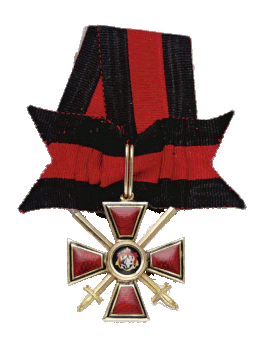
Order of Saint Apostolic and Grand Duke Vladimir 4th Class (Russia) (OSV)
The Order of Saint Vladimir (Russian: Орден Святого Владимира) was an Imperial Russian Order established in 1782 by Empress Catherine II (r. 1762–1796) in memory of the deeds of Saint Vladimir, the Grand Prince and the Baptizer of the Kievan Rus'. The order had four degrees and was awarded for continuous civil and military service. People who had been awarded with the St.Vladimir Order for military merits bore it with a special fold on the ribbon - "with a bow". There was a certain hierarchy of Russian Orders. According to this, the St. Vladimir Order, 1st Class was the second one (the first - St. George Order) by its significance. According to the Russian Law about the Nobility, people who were awarded with the St. Vladimir Order (each class) had had the rights of hereditary nobility until the Emperor's Decree of 1900 was issued. After this only three first classes of the Order gave such a right.
Major Walter Court Hyde, DSO 68th Battery 16th Brigade, CFA North Russia Expeditionary Force
The Order of Saint Vladimir (Russian: Орден Святого Владимира) was an Imperial Russian Order established in 1782 by Empress Catherine II (r. 1762–1796) in memory of the deeds of Saint Vladimir, the Grand Prince and the Baptizer of the Kievan Rus'. The order had four degrees and was awarded for continuous civil and military service. People who had been awarded with the St.Vladimir Order for military merits bore it with a special fold on the ribbon - "with a bow". There was a certain hierarchy of Russian Orders. According to this, the St. Vladimir Order, 1st Class was the second one (the first - St. George Order) by its significance. According to the Russian Law about the Nobility, people who were awarded with the St. Vladimir Order (each class) had had the rights of hereditary nobility until the Emperor's Decree of 1900 was issued. After this only three first classes of the Order gave such a right.
Major Walter Court Hyde, DSO 68th Battery 16th Brigade, CFA North Russia Expeditionary Force

Order of Saint Anna with swords 3rd Class (Russia) (OSA)
The Order of Saint Anna (Russian: Орден Святой Анны; also "Order of Saint Ann" or "Order of Saint Anne") was established as a Holstein ducal and then Russian imperial order of chivalry established by Karl Friedrich, Duke of Holstein-Gottorp, on 14 February 1735, in honour of his wife Anna Petrovna, daughter of Peter the Great of Russia. The motto of the Order is "Amantibus Justitiam, Pietatem, Fidem" ("To those who love justice, piety, and fidelity"). Its festival day is 3 February (New Style, 16 February). Originally, the Order of Saint Anna was a dynastic order of knighthood; but between 1797 and 1917 it had dual status as a dynastic order and as a state order. The Head of the Imperial House of Russia always is Master of the imperial Order of Saint Anna. Today, the Russian Imperial Order of St. Anna, awarded by Grand Duchess Maria Vladimirovna is recognized as an order of chivalry by the privately operated ICOC as a continuation of the pre-Revolutionary order, and has been approved for wear with military uniform by the Russian Federation, but not by some members of the Romanov Family Association.
Membership of the Order was awarded for a distinguished career in civil service or for valour and distinguished service in the military. The Order of Saint Anna entitled recipients of the first class to hereditary nobility, and recipients of lower classes to personal nobility. For military recipients, it was awarded with swords. It is now usually awarded for meritorious service to the Imperial House of Russia.
Lieutenant John Douglas Winslow, MC 68th Battery 16th Brigade, CFA North Russia Expeditionary Force
The Order of Saint Anna (Russian: Орден Святой Анны; also "Order of Saint Ann" or "Order of Saint Anne") was established as a Holstein ducal and then Russian imperial order of chivalry established by Karl Friedrich, Duke of Holstein-Gottorp, on 14 February 1735, in honour of his wife Anna Petrovna, daughter of Peter the Great of Russia. The motto of the Order is "Amantibus Justitiam, Pietatem, Fidem" ("To those who love justice, piety, and fidelity"). Its festival day is 3 February (New Style, 16 February). Originally, the Order of Saint Anna was a dynastic order of knighthood; but between 1797 and 1917 it had dual status as a dynastic order and as a state order. The Head of the Imperial House of Russia always is Master of the imperial Order of Saint Anna. Today, the Russian Imperial Order of St. Anna, awarded by Grand Duchess Maria Vladimirovna is recognized as an order of chivalry by the privately operated ICOC as a continuation of the pre-Revolutionary order, and has been approved for wear with military uniform by the Russian Federation, but not by some members of the Romanov Family Association.
Membership of the Order was awarded for a distinguished career in civil service or for valour and distinguished service in the military. The Order of Saint Anna entitled recipients of the first class to hereditary nobility, and recipients of lower classes to personal nobility. For military recipients, it was awarded with swords. It is now usually awarded for meritorious service to the Imperial House of Russia.
Lieutenant John Douglas Winslow, MC 68th Battery 16th Brigade, CFA North Russia Expeditionary Force

Order of Saint Stanislaus (Russia) (OSS)
The Order of Saint Stanislaus (Polish: Order św. Stanisława, Russian: Орденъ Св. Станислава), also spelled Stanislas, is a Russian dynastic order of knighthood founded as Order of the Knights of Saint Stanislaus, Bishop and Martyr in 1765 by King Stanisław II Augustus of the Polish-Lithuanian Commonwealth. In 1831 after the downfall of the November Uprising, the order was incorporated into the Chapter of Russian Orders as part of the honours system of the Russian Empire by Emperor Nicholas I of Russia.
In 1839, the Russian Order of Saint Stanislaus received new statutes, including granting status of nobility on its recipients in all three classes. As a result of the Russian Revolution 1917, activities were suspended by the Soviet Union, although it has since been awarded by the head of the Imperial House of Romanov as a dynastic order. When in 1918 Poland regained its independence as the Second Polish Republic, a Polish order was introduced as a successor to the Polish Order of Saint Stanislaus, the Order of Polonia Restituta.
However, the Order of Saint Stanislas continued to be awarded after the revolution by Grand Duke Kirill Vladimirovich, Grand Duke Vladimir Kirillovich, and Grand Duchess Maria Vladimirovna; the latter recognized as the legitimate head of the pre-Revolutionary order of chivalry by International Commission on Orders of Chivalry. It has also been approved for wear with military uniform by the Russian Federation.
2nd Class
Major Walter Court Hyde, DSO 68th Battery 16th Brigade, CFA North Russia Expeditionary Force
3rd Class
Lieutenant Walter Selkirk Newton, MC 68th Battery 16th Brigade, CFA North Russia Expeditionary Force
Lieutenant John Roberts, MC 68th Battery 16th Brigade, CFA North Russia Expeditionary Force
The Order of Saint Stanislaus (Polish: Order św. Stanisława, Russian: Орденъ Св. Станислава), also spelled Stanislas, is a Russian dynastic order of knighthood founded as Order of the Knights of Saint Stanislaus, Bishop and Martyr in 1765 by King Stanisław II Augustus of the Polish-Lithuanian Commonwealth. In 1831 after the downfall of the November Uprising, the order was incorporated into the Chapter of Russian Orders as part of the honours system of the Russian Empire by Emperor Nicholas I of Russia.
In 1839, the Russian Order of Saint Stanislaus received new statutes, including granting status of nobility on its recipients in all three classes. As a result of the Russian Revolution 1917, activities were suspended by the Soviet Union, although it has since been awarded by the head of the Imperial House of Romanov as a dynastic order. When in 1918 Poland regained its independence as the Second Polish Republic, a Polish order was introduced as a successor to the Polish Order of Saint Stanislaus, the Order of Polonia Restituta.
However, the Order of Saint Stanislas continued to be awarded after the revolution by Grand Duke Kirill Vladimirovich, Grand Duke Vladimir Kirillovich, and Grand Duchess Maria Vladimirovna; the latter recognized as the legitimate head of the pre-Revolutionary order of chivalry by International Commission on Orders of Chivalry. It has also been approved for wear with military uniform by the Russian Federation.
2nd Class
Major Walter Court Hyde, DSO 68th Battery 16th Brigade, CFA North Russia Expeditionary Force
3rd Class
Lieutenant Walter Selkirk Newton, MC 68th Battery 16th Brigade, CFA North Russia Expeditionary Force
Lieutenant John Roberts, MC 68th Battery 16th Brigade, CFA North Russia Expeditionary Force
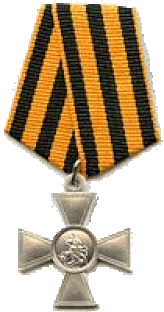
Cross of Saint George (Russia) (CSG)
The Cross of Saint George (Russian: Георгиевский Крест) is a state decoration of the Russian Federation. It was initially established by Imperial Russia where it was officially known as the Decoration of the Military Order of Saint George between 1807 and 1913. Established in the February 1807 decree of Emperor Alexander I, it was intended as a reward for "undaunted courage" by the lower ranks (soldiers, sailors and NCOs) of the military.
The Cross of Saint George was reinstated into the Russian awards system in 1992. It is awarded to soldiers, sailors, sergeants, petty officers, warrant officers and junior officers for deeds and distinction in battle in defence of the Fatherland, as well as for deeds and distinction in battle on the territory of other states while maintaining or restoring international peace and security with recognized instances of courage, dedication and military skill. Awarded sequentially in four classes from the fourth to the first for subsequent acts of courage.
St George's Cross (SGC)
Corporal Walter Hughes, MM 68th Battery 16th Brigade, CFA North Russia Expeditionary Force
Gunner Edmund George Kerr 68th Battery 16th Brigade, CFA North Russia Expeditionary Force
Acting Corporal Adam Robert Winegard 68th Battery 16th Brigade, CFA North Russia Expeditionary Force
Gunner Thomas Gray 68th Battery 16th Brigade, CFA North Russia Expeditionary Force
Corporal Warren Perkins Davy 68th Battery 16th Brigade, CFA North Russia Expeditionary Force
St George's Medal (SGM)
Driver Henry Alexander Redmond Woodd 68th Battery 16th Brigade, CFA North Russia Expeditionary Force
Driver Herbert Stewart 68th Battery 16th Brigade, CFA North Russia Expeditionary Force
Signaler Leslie Willard McCaw 68th Battery 16th Brigade, CFA North Russia Expeditionary Force
Gunner James Morrison Watson 68th Battery 16th Brigade, CFA North Russia Expeditionary Force
Bombardier George Edward Windsor 68th Battery 16th Brigade, CFA North Russia Expeditionary Force
The Cross of Saint George (Russian: Георгиевский Крест) is a state decoration of the Russian Federation. It was initially established by Imperial Russia where it was officially known as the Decoration of the Military Order of Saint George between 1807 and 1913. Established in the February 1807 decree of Emperor Alexander I, it was intended as a reward for "undaunted courage" by the lower ranks (soldiers, sailors and NCOs) of the military.
The Cross of Saint George was reinstated into the Russian awards system in 1992. It is awarded to soldiers, sailors, sergeants, petty officers, warrant officers and junior officers for deeds and distinction in battle in defence of the Fatherland, as well as for deeds and distinction in battle on the territory of other states while maintaining or restoring international peace and security with recognized instances of courage, dedication and military skill. Awarded sequentially in four classes from the fourth to the first for subsequent acts of courage.
St George's Cross (SGC)
Corporal Walter Hughes, MM 68th Battery 16th Brigade, CFA North Russia Expeditionary Force
Gunner Edmund George Kerr 68th Battery 16th Brigade, CFA North Russia Expeditionary Force
Acting Corporal Adam Robert Winegard 68th Battery 16th Brigade, CFA North Russia Expeditionary Force
Gunner Thomas Gray 68th Battery 16th Brigade, CFA North Russia Expeditionary Force
Corporal Warren Perkins Davy 68th Battery 16th Brigade, CFA North Russia Expeditionary Force
St George's Medal (SGM)
Driver Henry Alexander Redmond Woodd 68th Battery 16th Brigade, CFA North Russia Expeditionary Force
Driver Herbert Stewart 68th Battery 16th Brigade, CFA North Russia Expeditionary Force
Signaler Leslie Willard McCaw 68th Battery 16th Brigade, CFA North Russia Expeditionary Force
Gunner James Morrison Watson 68th Battery 16th Brigade, CFA North Russia Expeditionary Force
Bombardier George Edward Windsor 68th Battery 16th Brigade, CFA North Russia Expeditionary Force

Legion of Honour (French: Légion d'honneur) (LH)
The highest French order of merit for military and civil merits, established in 1802 by Napoleon Bonaparte and retained by all later French governments and régimes. The order's motto is Honneur et Patrie ("Honour and Fatherland"), and its seat is the Palais de la Légion d'Honneur next to the Musée d'Orsay, on the left bank of the Seine in Paris. The order is divided into five degrees of increasing distinction: Chevalier (Knight), Officier (Officer), Commandeur (Commander), Grand officier (Grand Officer), and Grand-croix (Grand Cross).
Chevalier
Warrant officer Class II George Chow CD
The highest French order of merit for military and civil merits, established in 1802 by Napoleon Bonaparte and retained by all later French governments and régimes. The order's motto is Honneur et Patrie ("Honour and Fatherland"), and its seat is the Palais de la Légion d'Honneur next to the Musée d'Orsay, on the left bank of the Seine in Paris. The order is divided into five degrees of increasing distinction: Chevalier (Knight), Officier (Officer), Commandeur (Commander), Grand officier (Grand Officer), and Grand-croix (Grand Cross).
Chevalier
Warrant officer Class II George Chow CD
Hazardous Skill Badges
The Canadian Forces Dress Manual states the following:
Parachute Badge. Two versions exist:
a. The Parachute Badge with white maple leaf is worn by parachutists who have received Paratroop Allowance for:
(1) service on strength of one of the following operational airborne formations or units:
(a) Specifically designated Regular and Militia army sub-units assigned to the airborne role,
(b) Canadian Parachute Centre; or
(2) service on strength of one of the following previous airborne formations or units:
(a) Special Service Force,
(b) Canadian Airborne Regiment,
(c) Canadian Airborne Centre,
(d) CF Parachute Maintenance Depot,
(e) Mobile Strike Force,
(f) Defence of Canada Force,
(g) Canadian Joint Air Training Centre, and
(h) 28 Central Ordnance Depot.
b. Other qualified parachutists shall wear the red maple leaf Parachute Badge.
Parachute Badge. Two versions exist:
a. The Parachute Badge with white maple leaf is worn by parachutists who have received Paratroop Allowance for:
(1) service on strength of one of the following operational airborne formations or units:
(a) Specifically designated Regular and Militia army sub-units assigned to the airborne role,
(b) Canadian Parachute Centre; or
(2) service on strength of one of the following previous airborne formations or units:
(a) Special Service Force,
(b) Canadian Airborne Regiment,
(c) Canadian Airborne Centre,
(d) CF Parachute Maintenance Depot,
(e) Mobile Strike Force,
(f) Defence of Canada Force,
(g) Canadian Joint Air Training Centre, and
(h) 28 Central Ordnance Depot.
b. Other qualified parachutists shall wear the red maple leaf Parachute Badge.
---- --- Colin V Norris
---- --- Richard Van Slyke
1973 Bombardier Brian Harmon
1973 Second Lieutenant Edward E Johnson
1974 Second Lieutenant John Jessop
1976 Lieutenant John T. Carter
1978 Second Lieutenant Russell G Ford
1982 Master Bombardier Noel RR Dykes
1982 Master Bombardier Paul Stewart
1985 Captain Dave Montrose
1993 Bombardier Quinn Gillard
1993 Master Bombardier David Urquhart
---- --- Grayson McCready
---- --- Doug Storey
---- --- Jack Mortlock
---- --- Don Gatward
---- --- Alfred T. Woo
---- --- Jason Street
---- --- Daniel S Kuhn
---- --- Nick Watts
---- --- Brent A Purcell
---- --- Goran Kurtagich
---- --- Richard Van Slyke
1973 Bombardier Brian Harmon
1973 Second Lieutenant Edward E Johnson
1974 Second Lieutenant John Jessop
1976 Lieutenant John T. Carter
1978 Second Lieutenant Russell G Ford
1982 Master Bombardier Noel RR Dykes
1982 Master Bombardier Paul Stewart
1985 Captain Dave Montrose
1993 Bombardier Quinn Gillard
1993 Master Bombardier David Urquhart
---- --- Grayson McCready
---- --- Doug Storey
---- --- Jack Mortlock
---- --- Don Gatward
---- --- Alfred T. Woo
---- --- Jason Street
---- --- Daniel S Kuhn
---- --- Nick Watts
---- --- Brent A Purcell
---- --- Goran Kurtagich
---- --- Colin V Norris
---- --- Jack Mortlock
1983 Bdr Noel RR Dykes
---- --- Grayson McCready
---- --- Don Labossiere
---- --- Don Gatward
---- --- Jack Mortlock
1983 Bdr Noel RR Dykes
---- --- Grayson McCready
---- --- Don Labossiere
---- --- Don Gatward
---- Cpl Anthony Tony Lawrence
---- --- John Brownlee-Baker
---- --- John Brownlee-Baker
---- --- John Brownlee-Baker
---- --- Jack Mortlock
Royal Canadian Air Force Navigator Wings
---- --- Steven R. Burridge
